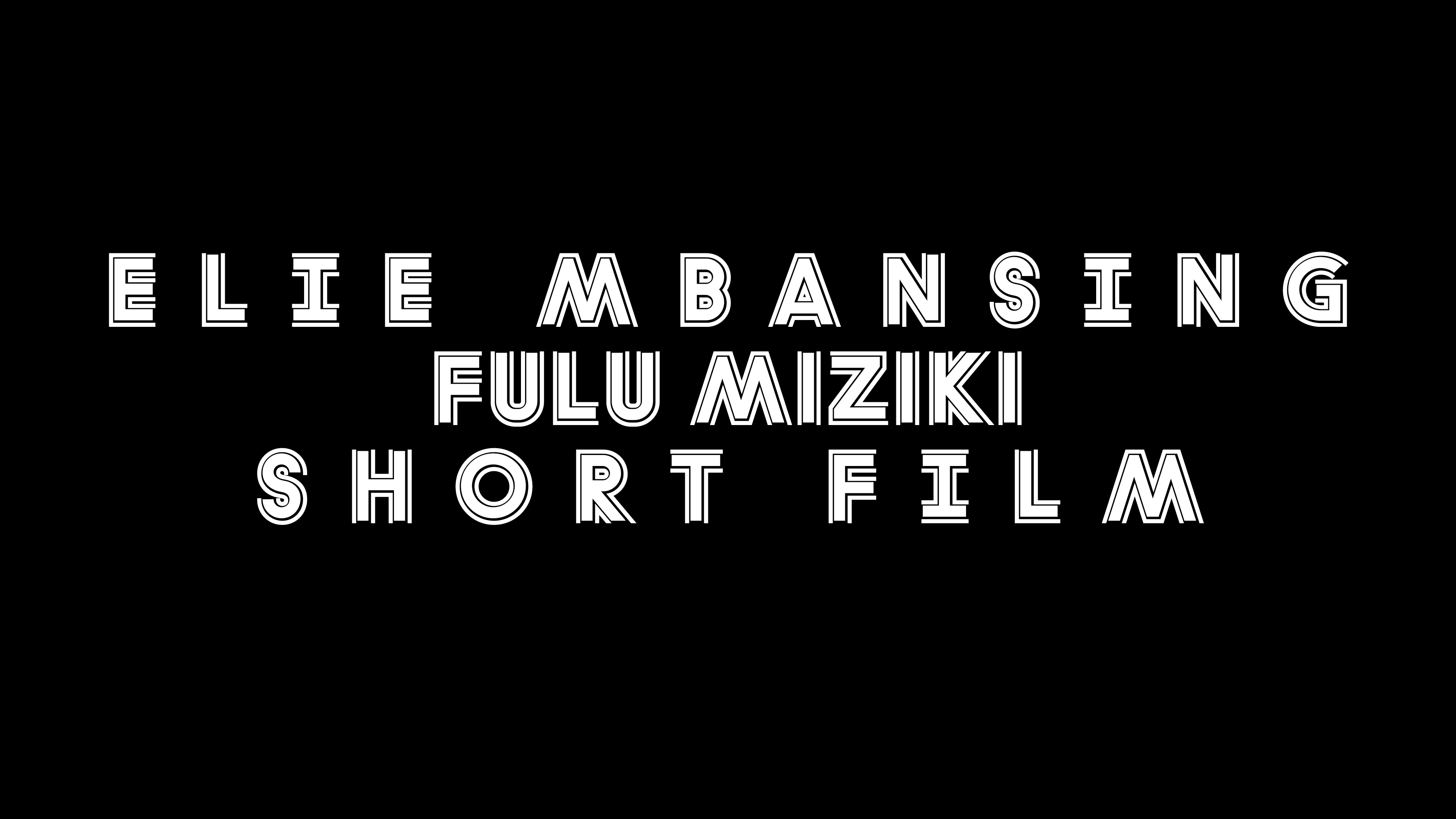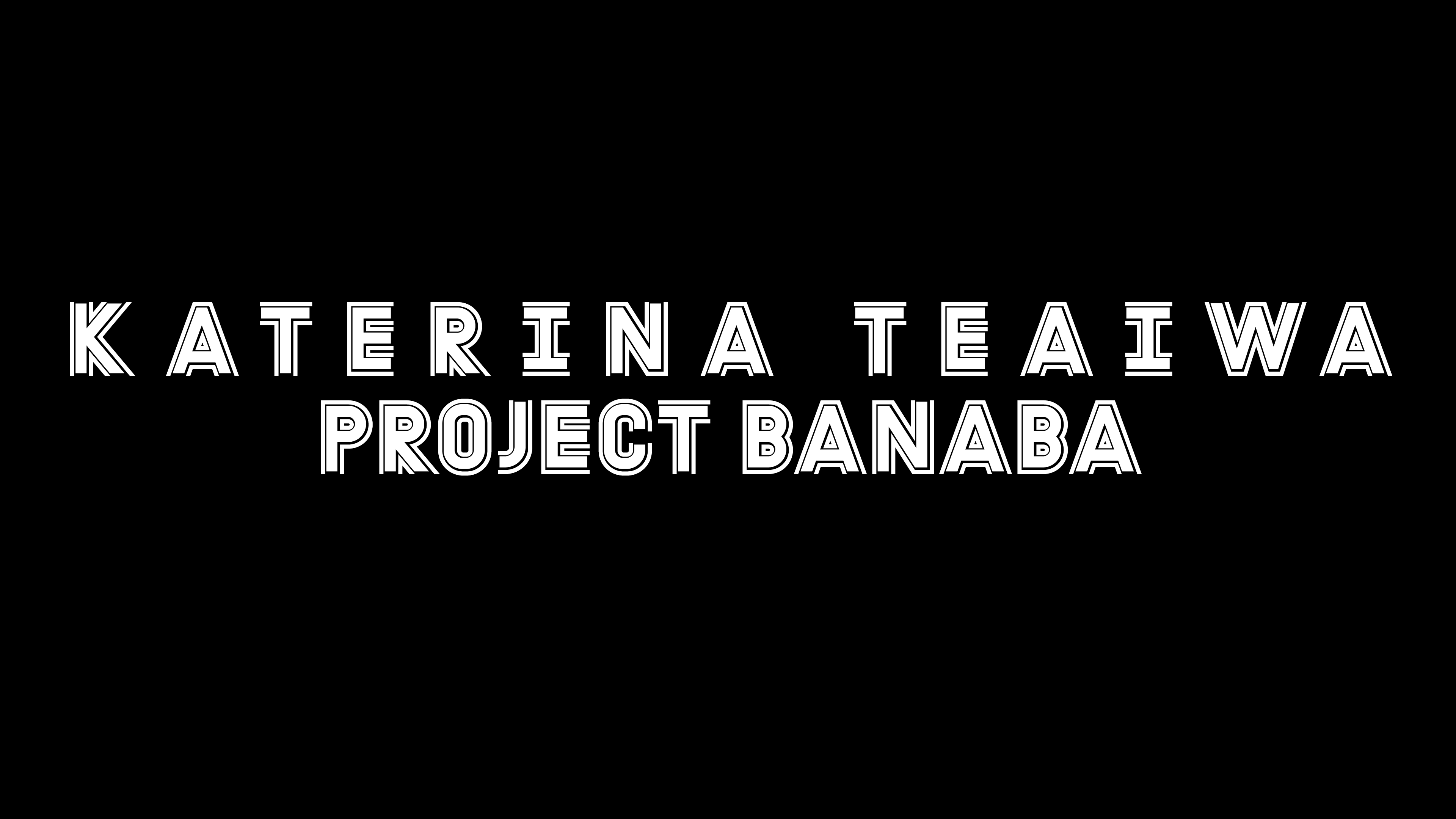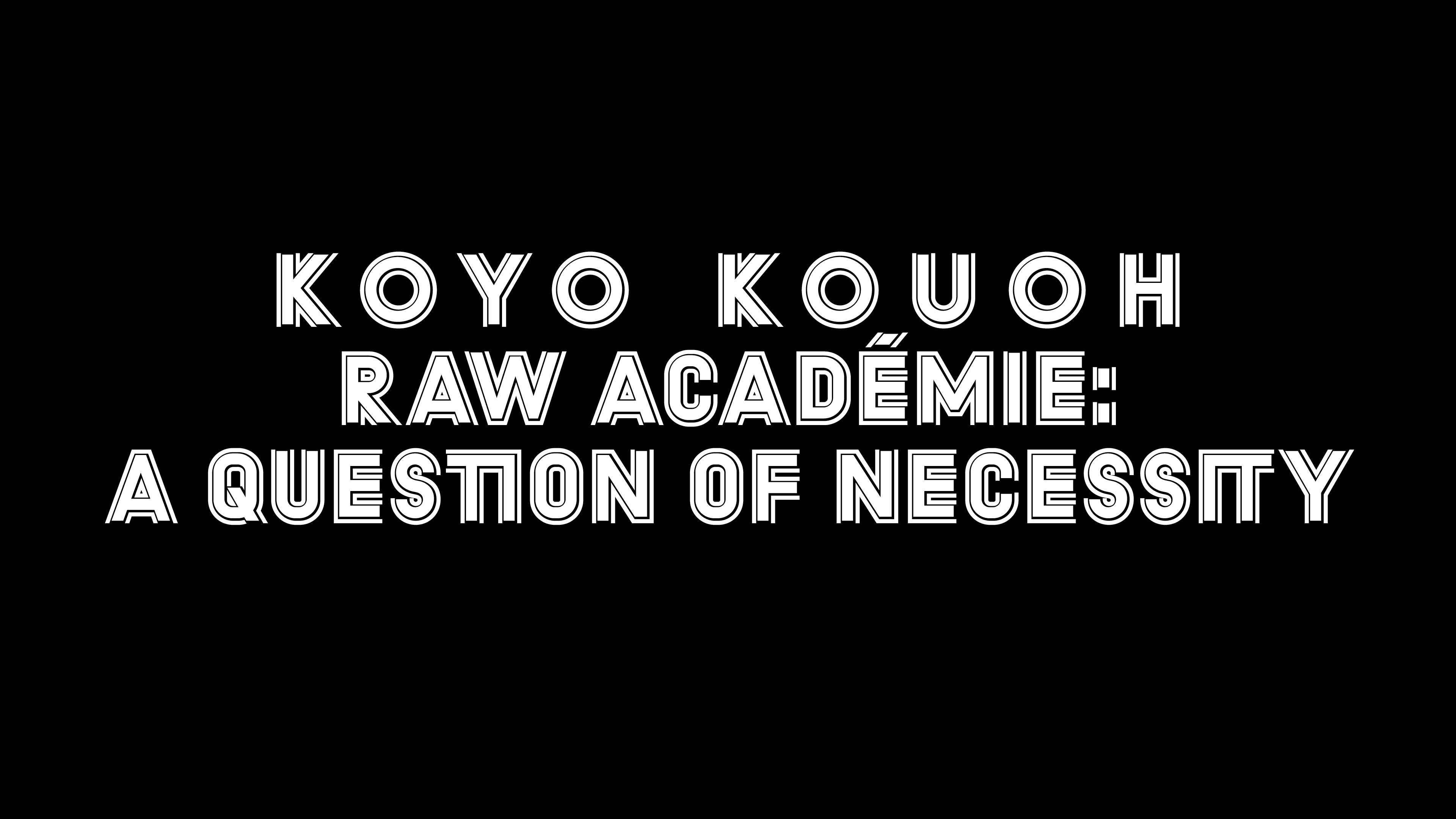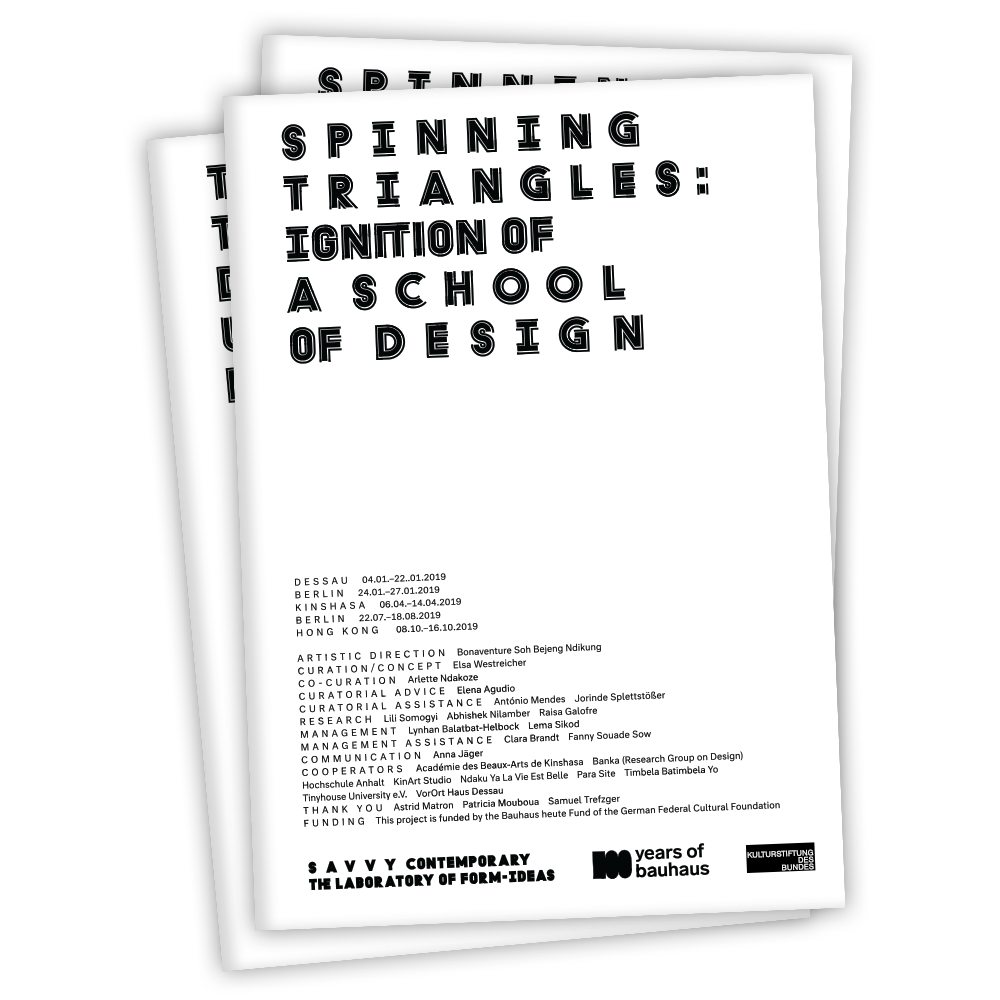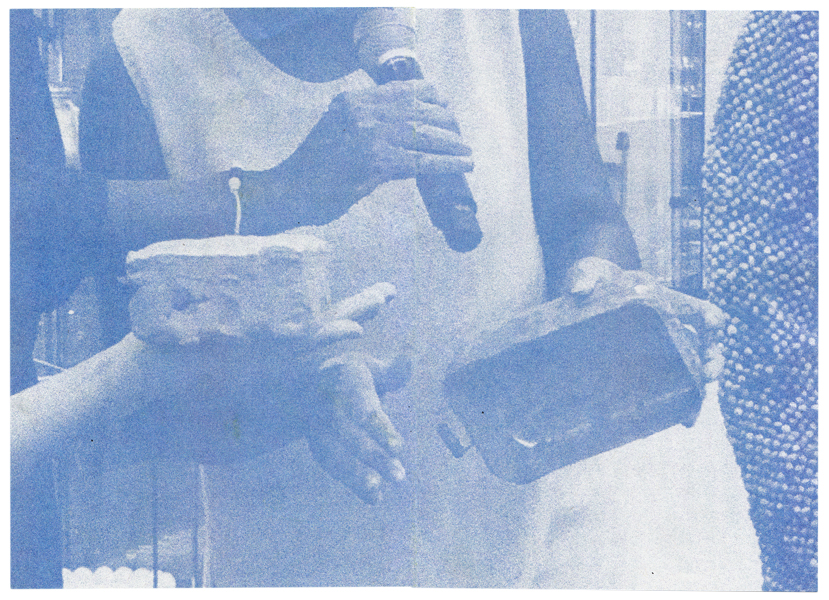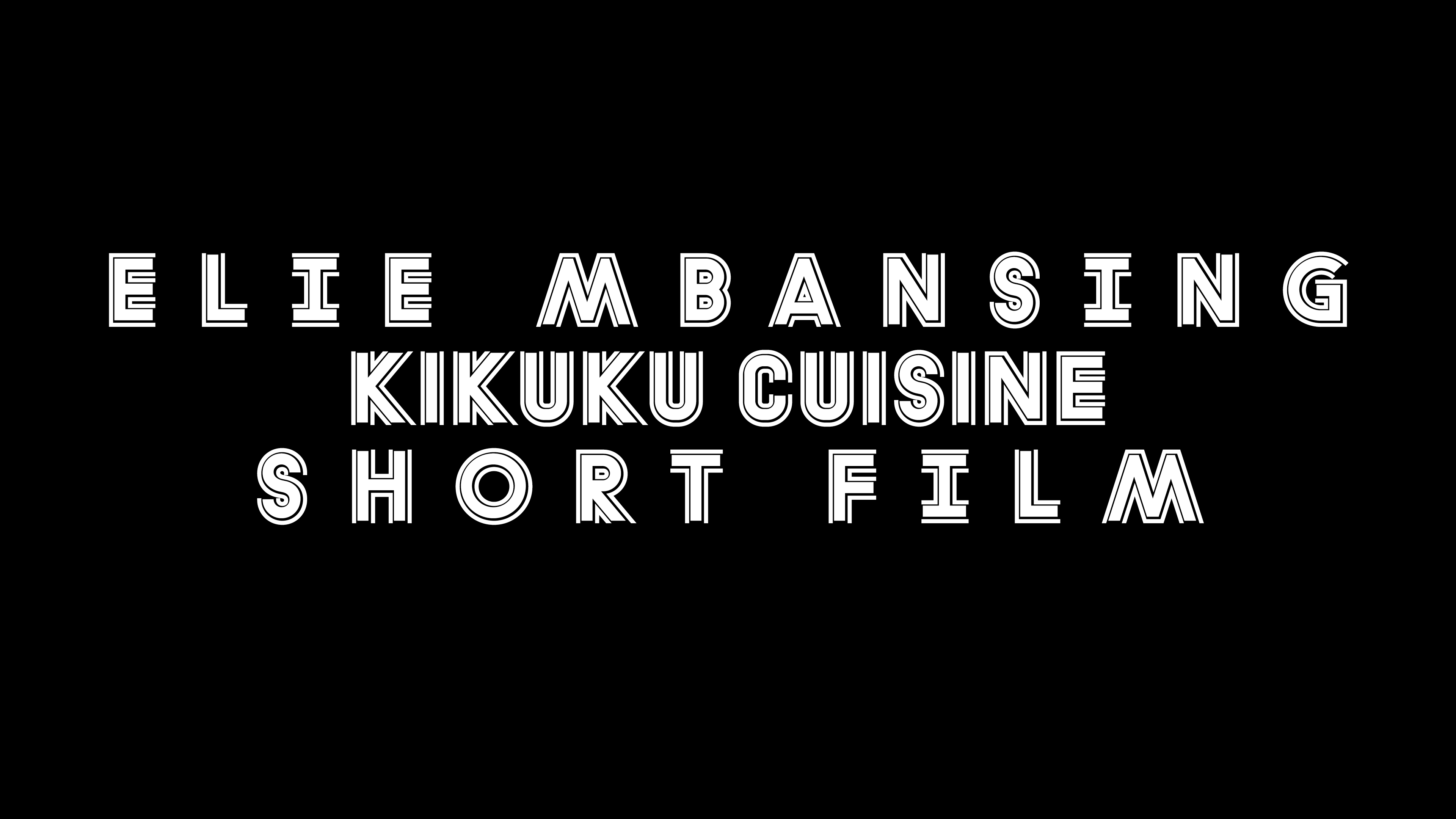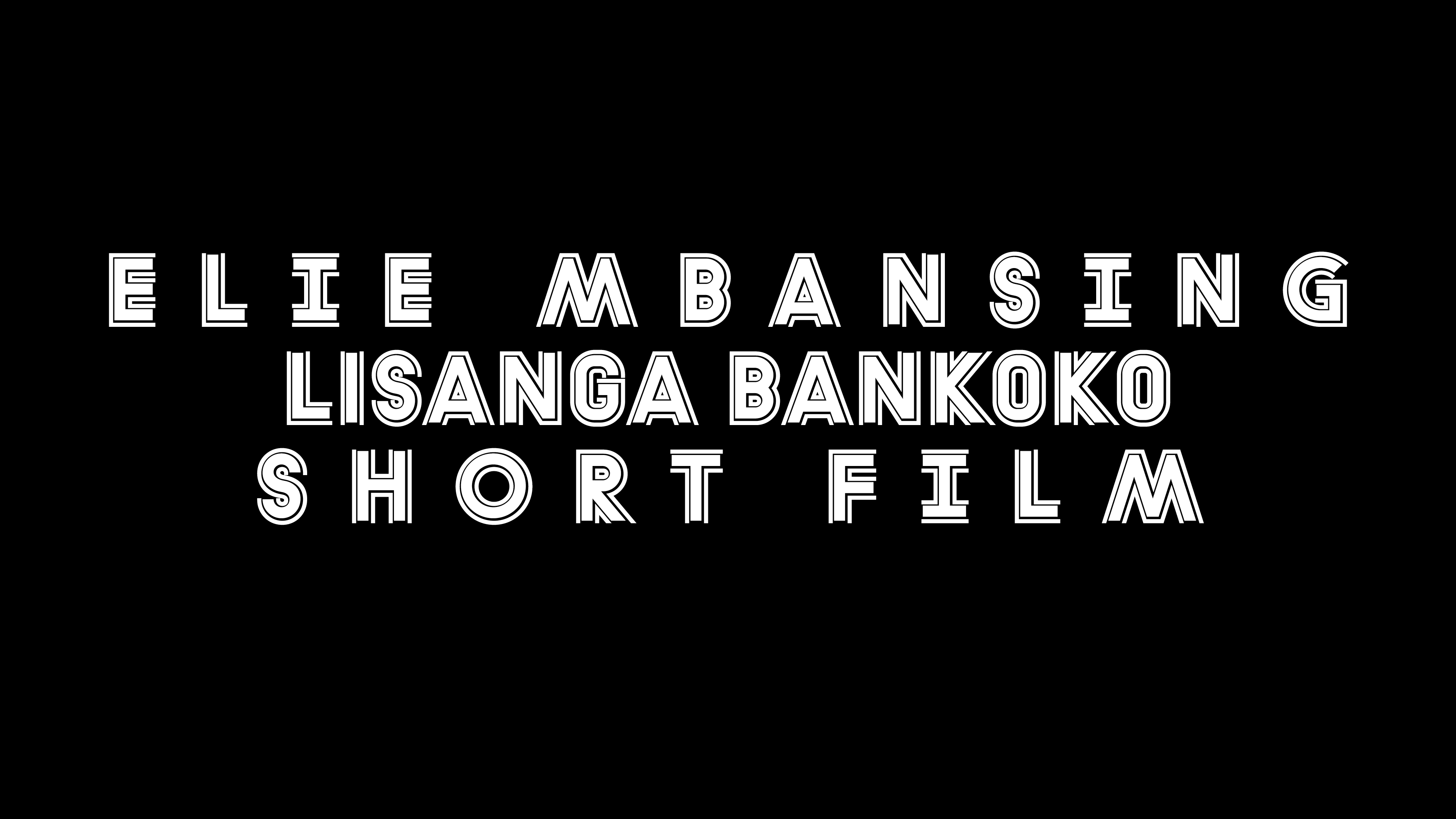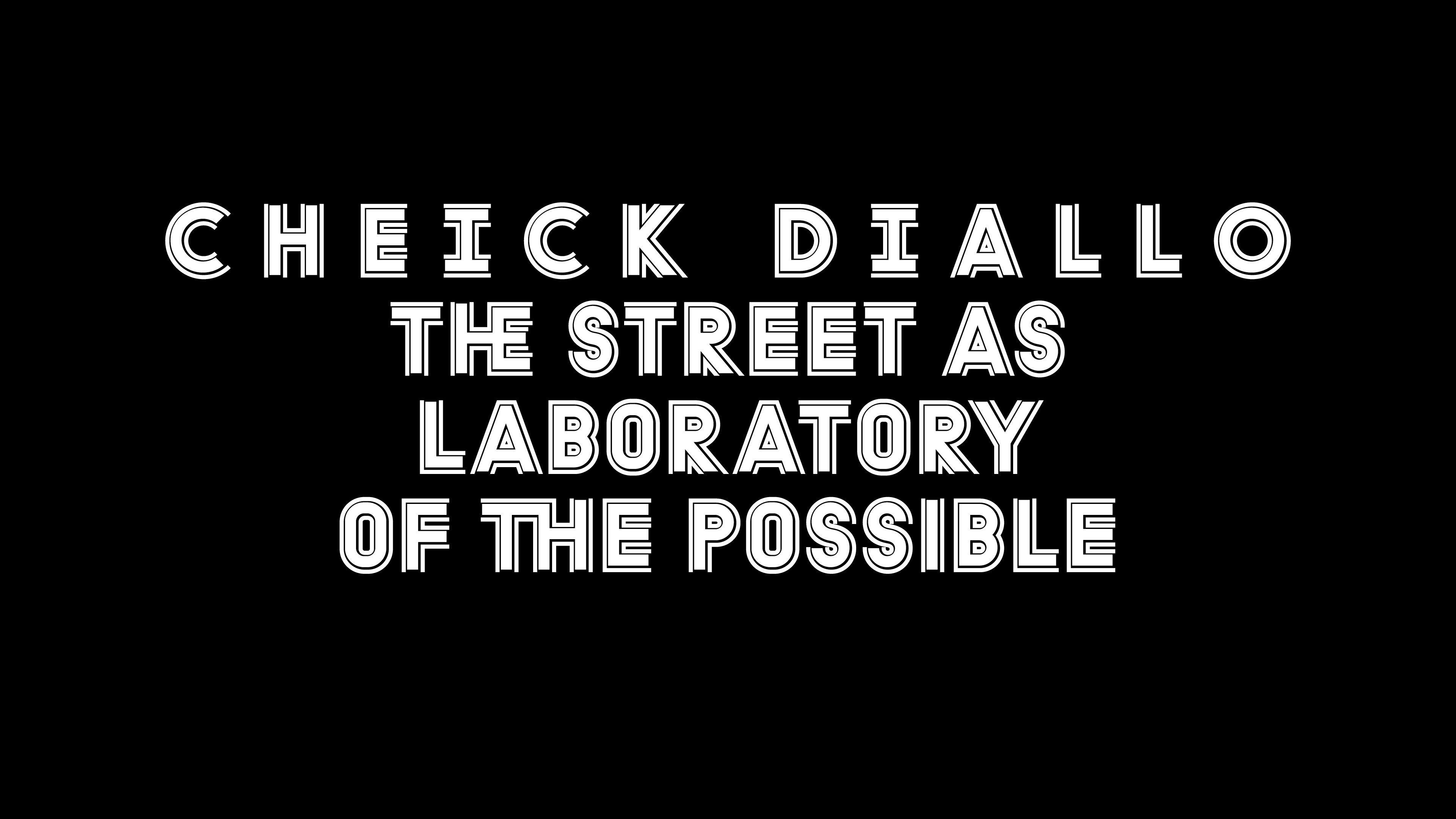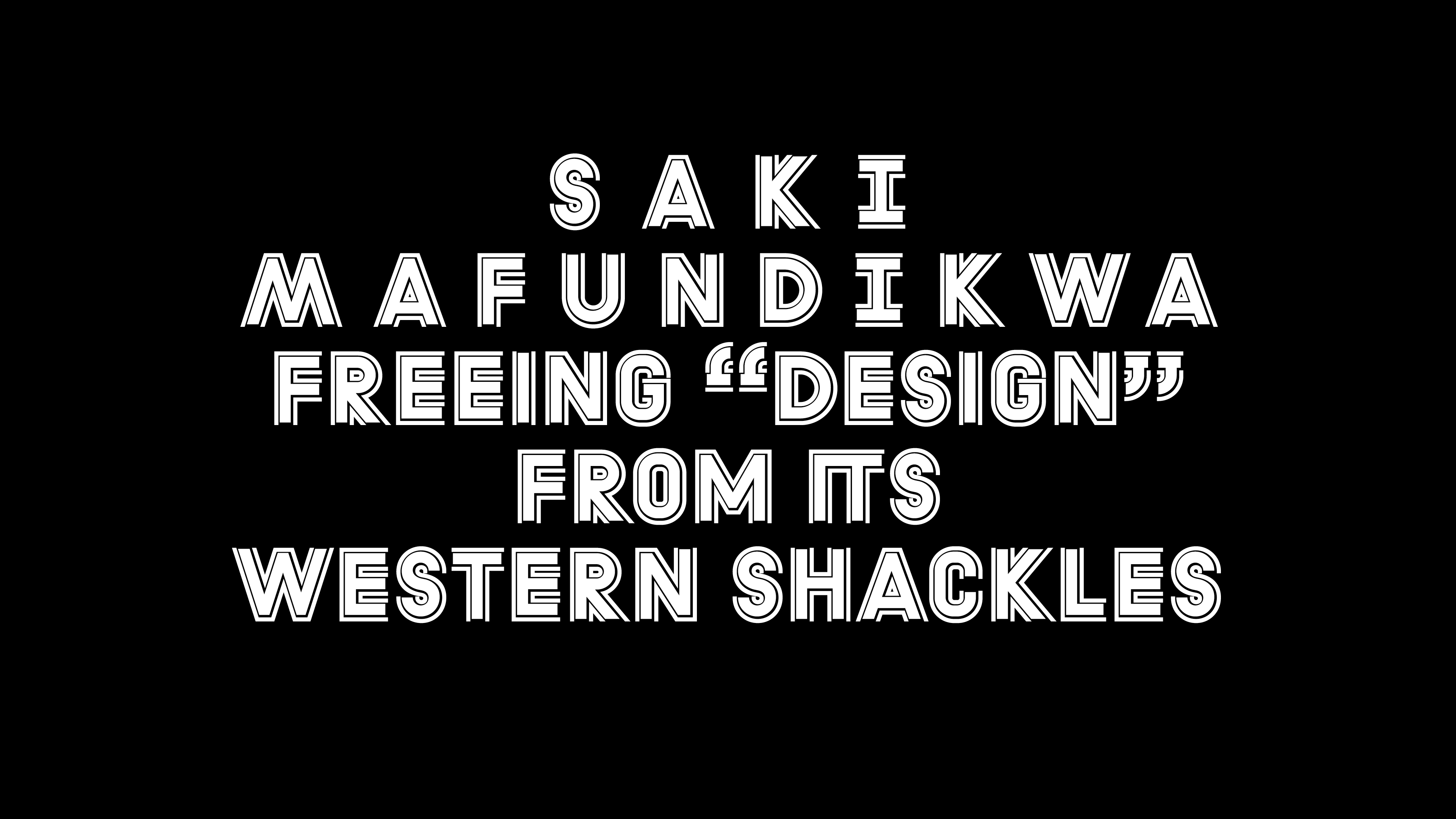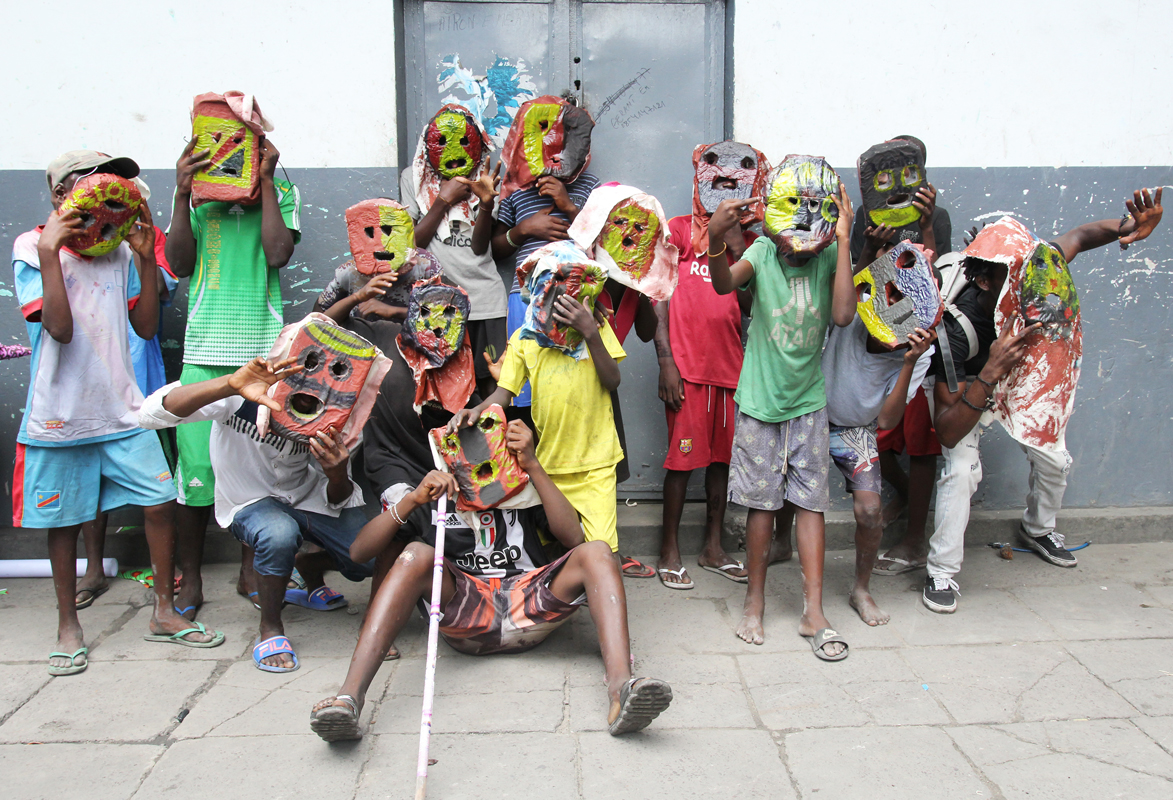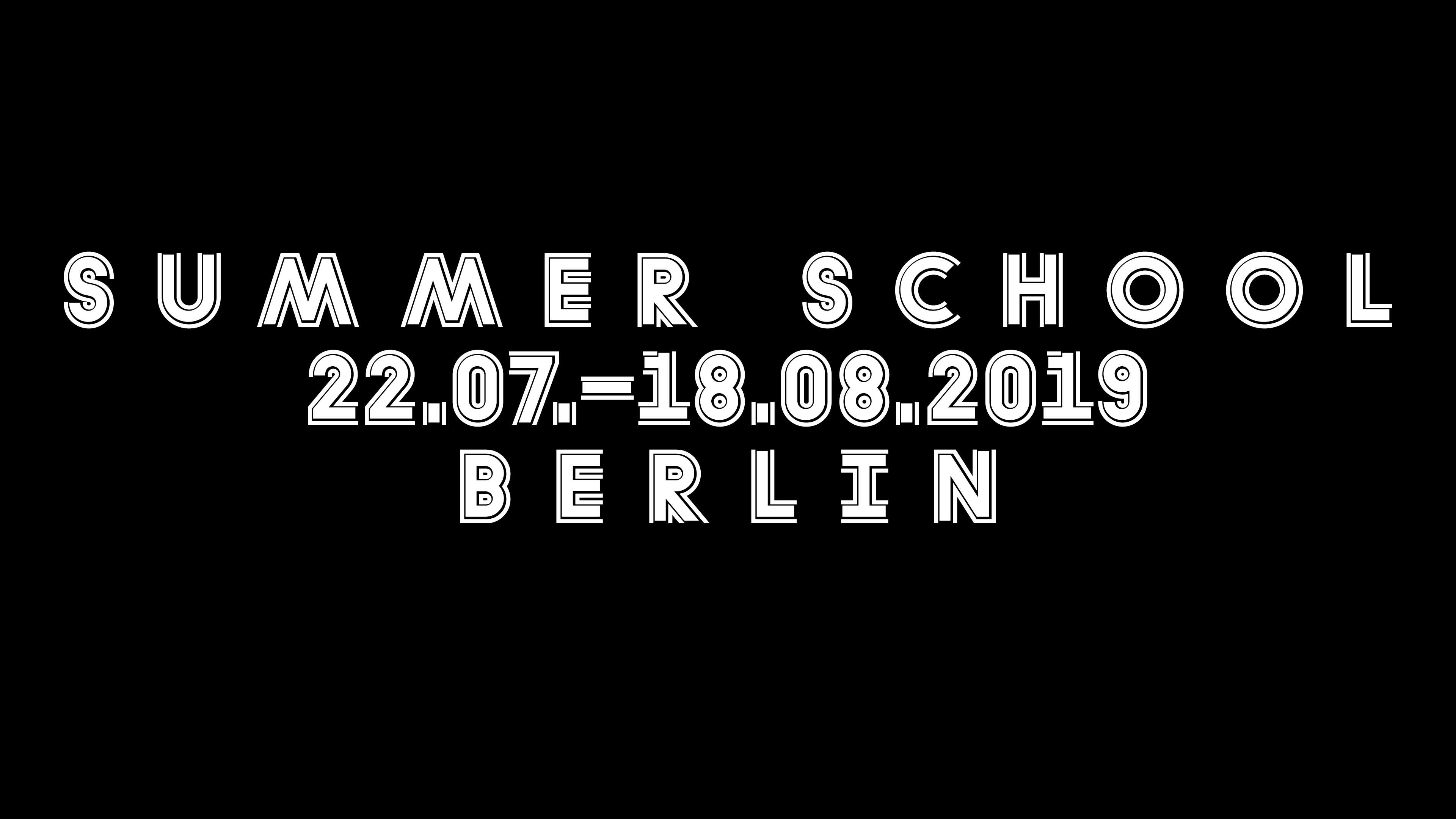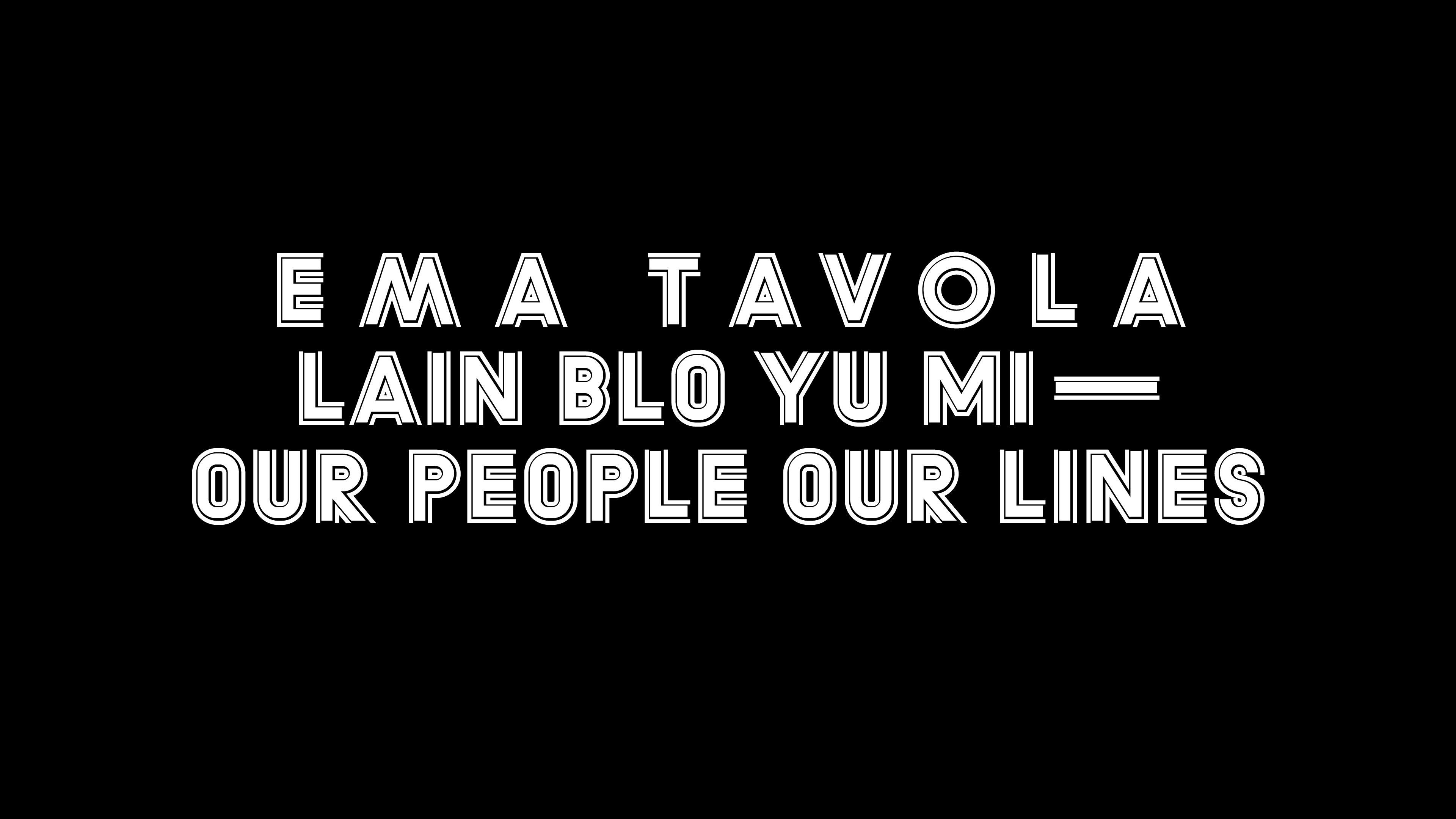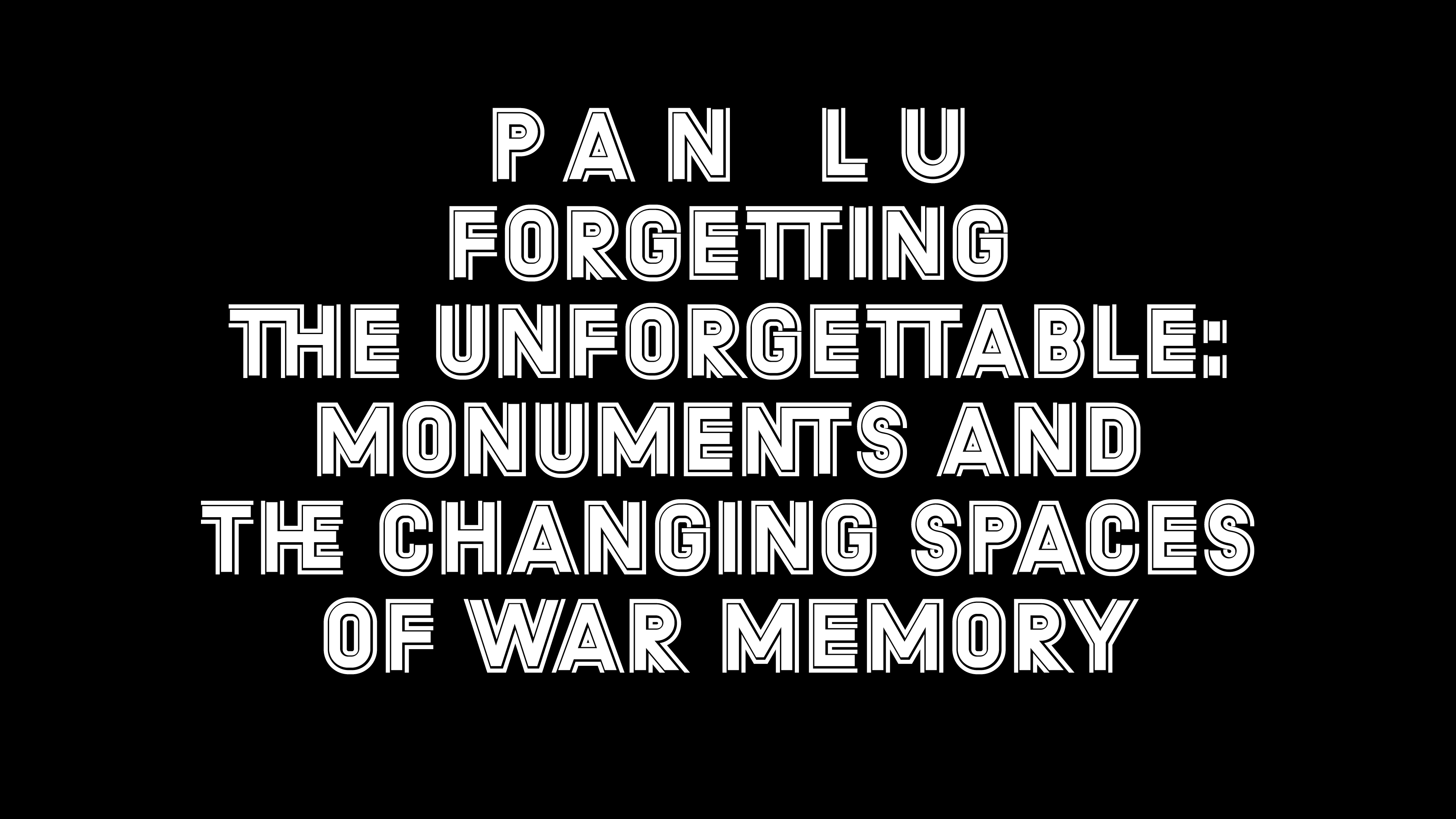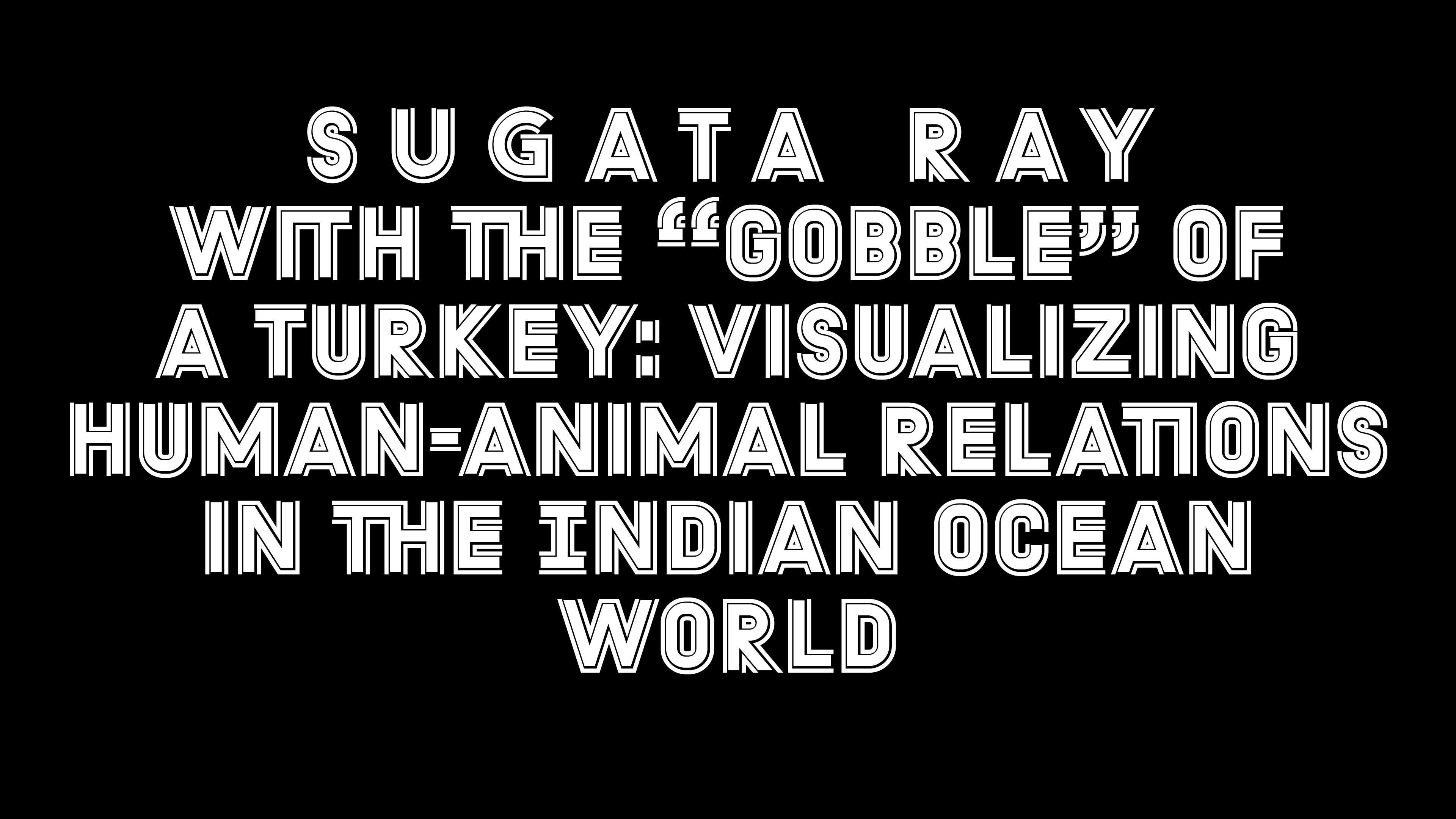or do we want to get along together in the future – starting today – because tomorrow doesn’t exist?
Spinning Triangles: Ignition of a School of Design is a project by S A V V Y Contemporary – The Laboratory of Form-Ideas. In 2019, on the occasion of the 100th anniversary of the bauhaus, we began to challenge and act against the inherent, neocolonial power structures in design practices, theory and teaching. The project shape-shifted, triangulated and wove itself between Dessau, Kinshasa, Berlin, and Hong Kong.
With this publishing platform, we wish to share fragments of the complex knots that bind the project’s questions together, that challenge and spell out the current ties of power structures, and point to open cracks and possibilities concerning norms, epistemologies and futures. By doing so, we hope to add to the ongoing conversation on how to think, do, learn and un-learn what is currently understood as the practice of “design”. Rather than marking an endpoint of these endeavors, this website is a beginning to further enquiries and form-ideas.
Detailed information on the project concept and program can be found here.
On (Digital) Technologies and Coloniality
A conversation with Aouefa AmoussouviElsa Westreicher: Hi Aouefa! We are very happy that we can come together today to talk about your workshop during the Berlin chapter of Spinning Triangles. Would you mind explaining to us shortly what your workshop during the Summer School was about?
Aouefa Amoussouvi: Yes, sure. It was a two-day workshop with the title On (Digital) Technologies and Coloniality. During the first day we talked about the history of digital technologies, what they are, which different kinds of technology exist, how we can use them, how they developed and how they became overly present nowadays. We discussed the opportunities as well as the ethical challenges they create in the context of decoloniality and feminism. Then, the second day, I removed the word “digital” in the title to focus on technology more generally. I was interested in ancient methods or practices, especially those that the West does not really recognize as technologies – maybe because there are no tools to measure their efficiency yet. I presented two examples: the plant medicine raw cacao and meditation.
Raw cacao was consumed by the Maya and the Aztecs during ceremonies. I guided the group through the preparation of a raw cacao drink, which we drank together before meditating. Meditation has been practiced in Asia for more than 4000 years. Nowadays the West becomes more and more interested in meditation, because tools are now able to measure what's happening in the brain when you meditate. Scientists realize that, indeed, meditation affects your brain.
Elsa Westreicher: I remember that many of the participants shared their experiences afterwards and were really excited about what they had learned through it. I wonder about two aspects that you addressed. One being the category of technology itself. Who or what is deemed to belong to it? Could you elaborate on that a little further? The other question is more about the “digital” – would you like to say something about the philosophies, or maybe rather conceptions on how to relate to the world that binary code exemplifies?
Aouefa Amoussouvi: I found it interesting to first go to the definitions of these terms. What is a “technology” and what is a “digital technology?” Everybody talks about digital technologies today. We sense what it means, but we are not totally sure. So I searched for definitions. Technology comes from ancient Greek and means “science of craft.” It's a tool, material or knowledge developed to solve a problem or to expand human capabilities. So a technology doesn’t have to be digital. For example: shoes are a technology because they enable us to walk without hurting our feet. A recipe to create cement or blacksmithing are also technologies. Agriculture as well gathers many technologies. Now let’s look at “digital technology.” Digital comes from the Latin word “digitus,” which means finger. The fingers and our hands were the first tools that were used to count. When we teach children to count, we tell them to use their fingers to help them with it. So a digital technology is a technology that is based on numbers, on fingers, and it implies the conversion of information into a digital – meaning a numerical – format made of ones and zeros, for storing and processing. This is basically how digital cameras, computers, smartphones, the internet, 3D printing work… Does this answer your question?
Elsa Westreicher: Yes, in its main points. Part of the question also was, who or what is deemed to belong to technology or digital technology. You responded to it already by expanding these definitions. I guess the question came from wanting to reflect the narrow understanding, in order to broaden it. For the rest, we might find time later on.
Arlette-Louise Ndakoze: Let’s move to the second question just because you mentioned smartphones. It seems that nowadays, industrialized societies are very much conditioned by the digital perception of things. We organize our days, our transport, meals, delivery, clothes, furniture and travels with digital devices such as smartphones or iPads, and the many apps that accompany them. Would you qualify their intelligence as artificial? And do you see a tendency of societies becoming artificial, which means, are humans replacing themselves by technology?
Aouefa Amoussouvi: It's a very interesting question. When I start to talk about digital technology I like to remind people that a digital technology is a tool and a tool is usually neutral. It's not good or bad. However, how you use it brings in values. Let’s think about a knife. You can cook a meal with it or cut something in smaller pieces in order to share it in a group. But with the same knife you can also commit murder.
Digital technologies are not bad as such. We are now using Skype to have this discussion. Skype as well as other digital communication tools enable many immigrants for example to talk, even see their friends and families. They may not be able to travel home but these digital technologies enable them to maintain contact and relationships that wouldn't be so easy to keep with older technologies like landlines or letters. At least not in the same regularity and format. Digital technologies enable education, self-organization, the building of communities…
On the other side, these technologies support capitalist society's consumption of objects and humans; buying always faster and more. Instead of purchasing something in a shop and having an interaction, even if brief, with another human being, we buy what we need on the internet and stay isolated in our homes... while simultaneously being online on social media. We also often forget that the production and disposal of our devices are directly linked with abusive working conditions and environmental disasters.
Another example is the use of screen names on the internet. We feel anonymous and protected behind our computers, behind our smartphones. Technology doesn’t really make us feel attached and connected with other people. This opens the door for hate speech. I am quite positive about digital technologies because I see a lot of possibilities, but, of course, I also see serious problems. Because they develop so fast, it is a big challenge for people and society to understand technologies and create legal regulations in order to protect users, but without restriction to their freedom of speech or of any other rights. This is something that is slowly being developed in different countries; as a way to deal with this and not maintain or even reinforce capitalism, patriarchy or racism with technologies.
Arlette-Louise Ndakoze: Interesting. I would also like to have your opinion on the term artificial intelligence.
Aouefa Amoussouvi: Artificial intelligence… Seen from the technical side, artificial intelligence is an algorithm. So it's a code, a script that is fed with information and will simulate new information. It means that artificial intelligences are very dependent on what they are given as initial information.
There is an interesting story to tell here. Microsoft developed a chatbot based on artificial intelligence and opened a Twitter account for this robot. It had been learning from mainstream millennials’ conversations and started to write misogynistic, racist and anti-Semitic comments. So after only 24 hours it had to be shut down. Again, this is a product made by human beings, which stays dependent on the people who produce and use it.
Arlette-Louise Ndakoze: But would you say that it's artificial, if it's coming from humans, or is it just the technique that is? How do you relate to that technique? Do you also say artificial intelligence? According to the way you define it, is there one term that we can use for that?
Aouefa Amoussouvi: I would say that it is artificial because it is not a biological intelligence. If I try to find another word.... Is there another word that you prefer to use when you think about these technologies?
Arlette-Louise Ndakoze: Maybe we will come to that. Within the project Spinning Triangles and within SAVVY, we thought about tools. It was really made much clearer when you talked about tools as any tool that we can use every day so that our life can be adapted to something that makes it easier or makes us relate more to one another. This is where I think design also was thought about. I wonder how far we went in that history of tools. Sometimes also certain names are given to us, although they sometimes don't accord to what is really happening. That's where I wanted to go to. This kind of dominance that comes from the outside telling us that we are no more humans or we are no more relating towards each other because we are now being replaced. We're being replaced by a system we don't have any control of, and that we should just get used to. So all of this is still a bit more amplified by another discourse nowadays, by the human and non-human, and by the question of agency. You know, instead of saying nature, people say non-human as if human is a reference for everything in this world, you know? So, you as a biophysicist, I was just curious to know your view on that.
Aouefa Amoussouvi: When I use the word artificial intelligence, I refer to this technology that can develop new information based on initial ones. I agree that how we name things has big implications and that human ego-centrism is problematic. It facilitates and justifies for instance the exploitation or destruction of nature. The deeper problem is that the speed and amplitude of digital technologies empower the flaws of current society.
Arlette-Louise Ndakoze: Yes. Let's move to the next question. You already mentioned the meditation that you did. Can you go back a bit more to that and explain how it is related to the digital mode?
Aouefa Amoussouvi: As I said at the beginning, I wanted to address the notion of technology in the broader sense as well as question who decides what is named one or not. It seems to me that many technologies usually non-Western or women related practices are not recognized, because they are considered too abstract or esoteric. An example is meditation, which is a very ancient technique. People were already meditating more than 4000 years ago. Now, thanks to the progress of science, it was measured that meditation affects the brain and even has an “anti-aging” effect for long-term practitioners.
The participants of the workshop were coming from different parts of the world and were working in different disciplines. I wanted to make them reflect not only on new technologies, that are coming from the West and that maybe can make life easier but also on the tools that have been present in their cultures, but have been seen as folkloric traditions and not as powerful technologies. It is interesting to observe that nowadays there is a kind of loop. There are a lot of digital technologies that confirm the efficiency of meditation, and others that enable people to meditate. In turn, practicing meditation and/or mindfulness may help to employ and develop digital technologies in an ethical way.
Arlette-Louise Ndakoze: I didn't know that meditation could be seen as a technology, or tool. What did it look like? Were people sitting with their eyes closed or did they hold something in their hands?
Aouefa Amoussouvi: There are very different ways of doing meditation. I think that most of the time people have this image of someone sitting with crossed legs and closed eyes, staying silent and static. That is one way but there are also many others. During the workshop, I took advantage of the garden. It was summer and really good weather. We did a walking meditation, where the idea is to move very slowly and mindfully, and to put your awareness to the soles of your feet. For each step you focus on the contact of different parts of your feet with the ground. We walked like this for about twenty minutes. Afterwards, we went back inside to be in a quiet space, where we did twenty minutes of humming meditation, making vibrations with our closed mouths. Afterwards, we did a twenty minutes silent meditation. I thought it important to propose some active and passive meditations, in order to show that people don’t have to force themselves into silence if they want to be mindful. You can practice it in different ways. The most important aspect of meditation is to be aware of what's happening, to not judge what's happening and to stay relaxed. And this can be done seated and static, but also while walking or doing something else.
Arlette-Louise Ndakoze: Thank you.
Elsa Westreicher: Then maybe we move on to the last question, which goes into a slightly different direction. Currently, huge amounts of data are being stored by monopolistic companies, websites and apps. These frantic storing activities sometimes remind me of the ethnographic craze that filled and still fills museums in the West. Neither the Museums, nor the tech companies have the sense to actually interpret or do anything with the things they store. We might say luckily so, yet we all know that in both cases, these things are not in the right hands. In the case of the tech companies, contemporary computers and storing technology are not advanced enough yet to allow far reaching analysis. But often I wonder what may happen when this will be the case? What do you see when you look at that as one of the possible futures?
Aouefa Amoussouvi: Yes, this craziness about data. Nowadays this raises more and more questions. So much data is stored about us. Data related to the websites we visit, how often we visit them, who we know and communicate with, where we are. It is data about what we like, our habits, our personalities. It can be very personal and very intimate. Luckily, people are nowadays more and more interested to know what's going on and ask how this data is being used. But we need more transparency and regulations to protect users.
This data is mostly sold for advertising purposes but can also be used in much more dangerous ways. I'm thinking about governments here, and would like to take the example of China, even though similar practices are also used in many other countries, including in the West, even though sometimes, maybe, in less obvious ways. China's government is using cyber-surveillance to collect data of citizens and control the population. If you praise the government on social media, you would receive positive points. And if you don't do it, you would get negative citizen points. Chinese government wants to encourage and reward the “good” behaviors of citizens, making their lives easier. For example, the “good” citizens would pay lower or no school fees for their children, or for public transport. “Bad” citizens, the ones that don't support the government, would be sanctioned and have to pay more money for life commodities, or in extreme cases can be sent to jail.
Again, there are also positive usages of data. I'm thinking about the field of digital medicine and more personalized diagnostics and treatment. At a larger scale if we collect a lot of data about people’s health, we can also make more accurate decisions about public health. What we can do to make sure that our data is used in a good way is still a very tricky question.
Elsa Westreicher: In order to get a little deeper into this question I would like to connect it to the earlier inquiry about binary code and its underlying system of thinking and being in the world. Knowing that electronic digital technologies are based on the binary opposition between zero and one, being and not-being, reflected in electric energy flows that are either cut or allowed, I am now wondering about another binary that you mention, which would be the one between good and bad. Implied here again is the question who actually decides what is good and bad. But also if it is helpful at all to go through and relate to the world with a binary logic. I keep wondering if this binary logic of the electronic machines we use doesn’t amplify, in one way or another, this binary way of thinking.
Aouefa Amoussouvi: I think that you already describe the situation quite well. Humans like to have this binary logic or judgment, to put people or objects in boxes, to value them or not, to label them as good or bad, for example. Many people realize that there's a lot of potential and money to make by collecting data. The question of how data is used is related to who analyzes and interprets this data and takes decisions based on it once it’s analyzed.
Nowadays there is a dangerous gap between producers and users of digital technologies. We need more diversity in the production phase, by this I mean more women and people of color in IT, who create these technologies and interpret the data. At the same time, we, as individuals need to educate ourselves about media, Internet and the risks related to digital technologies. Finally, we have to remember that humans make those tools and not the opposite.
Our starting point was to ignore the Bauhaus
A conversation with Cosmin Costinas (Executive Director/Curator at Para Site) and Anqi Li (Curator of Education and Public Programmes at Para Site Hong Kong)Arlette Ndakoze: So for our first question we are turning to you, Cosmin. In the context of this whole year, where we have together been engaging with you and Para Site, what does it mean for Para Site to have undertaken the project with Spinning Triangles in Kinshasa and in Hong Kong?
Cosmin Costinas: There are several aspects to this collaboration. It is related to our desire to engage more substantially with you guys, with S A V V Y. So the institutional collaboration in itself was very important for us. Because we strongly believe that institutions that share so much of their agendas, the responsibilities they see for themselves, should be in solidarity and in a process of working together. Secondly, but not in any particular order, I think it was very important for us to understand the different modes of education – the question of education is an ongoing question, of course – but it’s still very important for us to try and understand how institutions of our sort can pose this question and problem. How, from the perspective of a critical platform and non-academic institutional instruction can this lead to an educational outcome for the audience that we engage with? The broader audience or smaller groups. Both in Hong Kong and in Kinshasa, there was this sort of double layer. It was very important to see that happening. To have that in the context of the weight of Bauhaus, which still is a very powerful and dominant tradition, that was very important. And thirdly, it was also just being able to collaborate with colleagues from Kinshasa. That was also great for us. We are very much engaged in the process of working with different networks and geographies. And it’s something that we’ve been doing for many years now. So that was very much part of and aligned with the way in which we're seeing our work and our institutional worldliness, so to speak. We just met some incredible people last year. In both places. So I think, at the end of the day, it was also an incredible intellectual production that happened along these Spinning Triangles.
Arlette Ndakoze: I would, if it's ok, bounce to the educational aspect. The whole conference in general, was extremely inspiring and motivating in this context, how it flipped, regarding the still dominant Western view on what academia or knowledge is.
For example, in one talk by Professor Teren Sevea, who was pointing out the relationship between traditional knowledge, for instance, by miracle workers and the academic field, which often doesn’t really think about different concepts of reality and rationality. And in his talk, he mentions what happened in 2014, an aircraft that went missing and how miracle workers could foresee what experts couldn’t. They foresaw that this airplane would be found on an island, which actually happened afterwards. I wonder what you think about this, you know, because this whole program was very fascinating to us and we could see a kind of line in there. Would you like to talk about this, this concept?
Cosmin Costinas: Maybe it is. I think it's important to say that we were very much in dialogue with Simon Soon, so I think it would be important to acknowledge that. He’s one of the two guests who we also suggested to work for Kinshasa (the second was Ema Tavola). Because he was there and because we actually have a history of working together, we conceived that program together to a significant extent. Obviously we were very much interested in certain types of knowledge and people working in a particular way in certain subjects and certain hybridities.
We started from ignoring the Bauhaus legacy. That was the idea; not to deconstruct it, not to respond to it, certainly not to find its local manifestations, but to find the best way to basically ignore it, to work already from a premise of having overcome its legacy. Speculatively, but still making the claim. We were indeed very interested by different ways of deconstructing the assertion of rationality, as a part of Western modernity. From the speculative proposal of working from the premise that we have already overcome the legacy of Bauhaus, made it possible to imagine ourselves in a moment that is not yet here, but that we could nevertheless have imagined. This brought us to be interested in other forms of circulation, of ideas, of bonds, of styles.
Circulations that happen in different geographies on the one hand, but also circulations that happen in non-hierarchical manners on the other, in opposition to the way the Bauhaus diffused and organized itself in the process of taking over the world. So there were particular stories and particular lines, that naturally came about through the work of colleagues that we admire and that we want to work with.
Curating conferences is very different from curating art and its exhibitions. It's a different process. When some of the constellations for the symposium were formed and became apparent to us, we added people to make aspects clearer or to take them in different directions.
Elsa Westreicher: Even though this is very interesting and that there would be so much to add, I think it would be wise to move to the next question. This one is for Anqi. In Hong Kong, and many places on the planet, we see various acts of resistance against oppressive systems, geared at economic structures, environmental issues or education. In Para Site’s 2019 international conference, there was an underlying thread that reflected modes of resistance through design in a long historic frame. From many centuries in the past up to today. So I guess we touched on this a little bit already, but what are your reflections on this in relation to contemporary Hong Kong?
Anqi Li: First of all, personally, I feel pretty lucky and grateful to be able to be involved in the international conference, not only as an organizer but also as an attendee, because I think the conference really brought voices from speakers from many places together, from many different regions. They were able to share, to discuss, to debate about different opinions here.
We find a lot of common struggles and suffering, thinking not only of Hong Kong but also many other places of the world. From this perspective, the symposium reflected Hong Kong as a very open minded hub, where such ideas can come together to be in exchange. That’s why I myself, joined Para Site. I moved to Hong Kong about half a year ago. I am experiencing a different Hong Kong from what it was before summer 2019. So my experience might have been quite different previously. What I observe in Hong Kong now, is that people are constantly looking for solutions to problems that surface from the bigger social struggles and personally I feel the anxiety, the uncertainty, sometimes I see the fear sometimes the fearlessness of people, with all the things that happened in the past half year here in Hong Kong.
And I think attending the international conference, we share the same vision with you. As co-presenters, I think we encourage solidarity and different opinions to be presented at the conference. We can talk, we can share and we can learn from the ideas presented by speakers from different countries. We all resonate with different perspectives that were shared at the conference. After all, at the international conference, we wanted people to take away something that helps them beyond the event itself. We hope the discussion continues after speakers are leaving the stage. Maybe while talking to the audience at the dinner table or in any other place or circumstance. We could keep this conversation going and talk about contemporary Hong Kong, but what I would like to point out, is that, I think that those ideas are welcome here and that they are inspiring people. Something has been opened up for people. They have been encouraged by the open conversations taking place here.
Arlette Ndakoze: The next question goes to Cosmin and the concept of this international conference, which can actually be read on your website. We would like to refer to the international language that you mention. What are the characteristics of the international or internationalist language you refer to in your concept notes, especially regarding the guests and the topics of your conference of 2019? You talked about it in many different ways, but maybe you want to add something specifically in regards to this language.
Cosmin Costinas: That was also speculative. It was part of the same strategy as imagining ourselves having overcome Bauhaus already. It was very much a counterpoint to the very clearly articulated internationalist framework that Bauhaus and other systems in the same legacy had. So we were certainly not claiming for a single unified internationalist language, we’re not claiming that this exists or that it should exist as such. But there is a long semantic debate here in Hong Kong about what the term would be to describe that sense of international solidarity, the system of common thinking, of common making and common acting, which we’re all working towards. And to a certain extent we are also working with this, so something is in place and is part of reality. But I guess that the call is, to try to understand how to define it beyond semantics. Is this internationalism, cosmopolitanism, transnationalism and so on and so forth? Very often these kind of semantic discussions are not really solving the problem. It’s not really about the semantics, but more about the substances, how to work towards enhancing what we already have to a certain extent.
Arlette Ndakoze: Within this project, one of the main questions is how to make a common, a collective way of living possible. And we were thinking a lot about what you mentioned, what Anqi mentioned. What would you say, you know, that this kind of tension between opening to various opinions and at the same time not be violent in the way to stick to one’s own way of thinking?
Cosmin Costinas: I mean, sure, we’re not really opening the space to all ideas, obviously, it’s very important, especially in the complicated context of our age, where even in spaces that used to be safer in terms of people’s politics, are now being infiltrated by other positions. We need to be discerning. It is not about creating one happy family for all ideas, freedom of speech and about making an umbrella for the whole of humanity. But it is certainly about curating and making a stand for a certain direction. But within this, sure, there needs to be a certain broadness, and an understanding that if we are to think of the legacy of Bauhaus, that language itself can be oppressive. Language can hide many things. Ignoring knowledge that uses different forms of language to express itself and to come to the world can be very limiting. In that sense, it’s certainly important to open up to different, established languages or to invite people who try to do interesting things in academia despite the difficulties as well as open up to people working in other fields. People who work outside of language or create their own language. Maybe because of the various ways that make other forms of language inaccessible or maybe because this language is not enough for what they want to express.
Elsa Westreicher: I want to add a small reflection, because I find it very interesting to reflect Para Site as well as S A V V Y as spaces that try to propose a certain collectivity and how that can be lived within the reality that you outlined. That’s where I see a connection to the idea of speculation, that actualizes the imaginary in a way. There is a whole section of design, where the word “speculative” has become quite en vogue, with people expressing their practice as “speculative design,” and where creating is not so much a part of a modernist design idea of creating solutions to certain perceived problems, but rather to ask the question of what sort of imagined realities one could create and what kind of form-language could be related to it, and what collectivity that would propose or engender. This is why I find it quite interesting that you use the word speculative to explain your approach. I don’t know if you want to add anything to that reflection. Otherwise we could move to the next question.
Cosmin Costinas: That makes sense, yes. It relates to what we said, very much so. But yes, I am fine to move to the next question.
Elsa Westreicher: Ok. This one would go to Anqi. Next to the conference, Para Site also ran the workshops for emerging professionals, which were organized by you. Could you explain a little what these annual workshops are, what you intended and what their focus was this year?
Anqi Li: Our workshops for emerging arts professionals started in 2015. It is a nine day curatorial intensive but we also want to make it into a lab for experimentation, for different kinds of emerging professionals a space to meet, to collaborate, to make friends. So this is not really like a curatorial program like the many other academic curatorial programs out there. We want people to gather here. We want to invite people to Hong Kong so they can have a deeper understanding of the arts scene here. We want to provide them with opportunities to see, to experience and to know what career they might want to follow. It’s practical but it is not really a training per se. We want to equip them with the skills and the mindset so that they are ready to pursue a career in the arts. For the international conference this year, we had a slightly different approach than in the previous years, because we invited scholars rather than putting the focus on curators or artists. With the feedback we received from previous workshop participants, we clearly saw an increased interest in having more visits from institutions and in having deeper conversations with researchers who have their own ways of doing curatorial projects or who have practical experiences of running public, private or independent organizations. So we designed the 2019 workshop to be more practical in a way. We had many site visits, but tried to create smaller groups so that it would not only be fifteen people talking to one person, but allow for more intimate conversations. One example would be the visit to the Foo Tak Building, maybe you remember. That house has multiple storeys and hosts several art organizations such as the Rooftop Institute, the Archive of the People, Liber Research Community. The visit did not only allow the institutions to introduce themselves and explain what they do, but also allowed students to ask questions such as how they approach their academic interests and so on.
The institutions are interesting, but it becomes more interesting when there is a conversation between them and the participants.That went pretty well and we are receiving good feedback on this. Some news to share at this point is, that we just received new applications for the workshops in 2020. It is very exciting to read, many of the new applicants are recommended by people who participated previously. This is really our hope; to grow a network of young curators, scholars and writers. They will be the new generation that will come into the industry, so we wonder how to maintain this group. What concerns Para Site, we want to provide exhibition opportunities and open a space for a bigger pool of applicants, but we definitely want to encourage workshop participants to apply to our exhibition opportunities. We provide the exhibition budget and all kinds of production or tutorial support. All this can contribute to a better ecological system in the arts. So we want to help realizing this and provide fair opportunities for emerging curators and researchers to follow their art career.
Elsa Westreicher: It’s interesting that there is a community emerging through this. Doing this for five years and now going towards the sixth iteration allows for a learning process to have taken place within Para Site. The fact that there is a continuity, and not the effect of a one off project that loses traction after it is finished is important, I think. Especially in a reality where such continued interest is not a given and where art spaces struggle to stay alive. I was very lucky to be able to follow the program you organized for the workshops and to follow the map you were drawing of Hong Kong. Which indeed was very diverse, visiting institutionalized places as well as self-initiated and self-run initiatives. I also have to think of all the incredible conversations with participants, of whom many were already involved in their own initiatives and proposals. Somehow, I guess Para Site is an entity that takes in and gives back, receives and returns. Would you want to say anything about that and maybe also touch on why you chose these particular institutions for the visits?
Cosmin Costinas: Referring to the last part of your question, I think we try to be as inclusive as possible. Maybe even a little bit more inclusive than we normally are for the conference, in relation to my previous answer about broadness. Because it’s also about solidarity and highlighting your peers. But it’s also a little bit of an educational exercise where we need to give the participants a broader knowledge and understanding of what’s happening in the city. So we would also take them to institutions that are maybe a little bit different from us or to exhibitions that wouldn’t be among those we would highlight otherwise. But now, for the remains of your question. I mean, pretty much everything that we do is very much connected to Hong Kong. So that’s very clear. But it’s also very important to understand, what that means and what it says about Hong Kong. Because there are some things that are very directly connected and easily recognizable as conversations or issues happening in Hong Kong. But with regards to other things, the connection is less obvious. It is very important to say that, part of what Hong Kong is, is an ambiguity and ephemerality, if one wants to be melancholic about it. But it is also a space of encounter in many ways. It is one of the few places where such conversations can take place, where certain conversations can happen between people across the region or from other parts of the world. With very different ways of understanding issues of power or hierarchy that occur in many such meetings. It’s a city which does not have an imperial project of itself, compared with other rich cities in the world, where bringing things to them would immediately serve or inevitably be part of a conversation of the hegemonic project that they have. Whether it’s Singapore that likes to position itself as a kind of hub or capital of Southeast Asia, or Tokyo, with its complicated past. Not even mentioning western cities. This is very different in the case of Hong Kong because its own identity is so contested and so complicated and so sensitive, that there is no branding exercise or real imperial project in which the city would be the subject. So it is very interesting to play with this quite rare situation, where many things are possible. We try to take advantage of that. With many projects that we do, we highlight the nature of Hong Kong. So even if the subject is not immediately and obviously connected to this city, it still is very much in connection to it. They are many projects we do that could only happen in Hong Kong. And they are very much defined by the spirit and the realities of the city.
Anqi Li: And for me, I would say for us who are part of Para Site, I think our earlier founders, our previous colleagues, have already built a lot of great resources, and a great reputation for Para Site. We definitely want to provide those advantages for our workshop participants. Getting them connected with people from the industry, to give them the opportunity to learn, to experience what they want to. Because when we’re selecting the workshop participants we also ask “what do you expect to get from this experience?” So we are definitely considering what will be ideal for people to get from the workshop. On the other hand, like what Cosmin said, I think individuals filter information from different projects or events. But for us, since we’re doing a group program, we want to make sure that people don’t overlook all the things that are happening in the city. Even if those might already be filtered by them individually. Those are our efforts as educators; to provide a lot and give the participants the freedom to choose what they want to focus on.
Arlette Ndakoze: This is a comment on how we can draw a lot of parallels between a space like Para Site especially in terms of its content and what you are engaging with, and the approach we take at S A V V Y. In the sense that a space, already is a certain world to exist in. I think a lot about what you Anqi and Cosmin said before, is similar to a certain world that is not yet the world, but a kind of reality or perhaps not yet, but which exists within beings and that this can be imagined. And how much it is already happening, you know, that we always think about one world and many things that we should adapt to or think about, live in a certain way or think in a certain way. But seeing that something is already happening in a space where people are willing to open themselves up to certain things or see where the limits should be in order to come together. This is where my thinking goes to a lot, thinking about design and how to design a space that goes further and further.
Cosmin Costinas: And so how do you see the afterlife of this project? It would be interesting to hear, because very often and too often, a lot of projects create an interesting moment, and interesting situation that doesn't continue anywhere, because the project has its natural ending point. So then that situation is not maintained. How do you see that?
Elsa Westreicher: One can see it both ways, I think. Sometimes it can be good to close a chapter, actually. The project was a beginning for a lot of things, which might weave itself back into some new forms. We have really gone through a big process with this project at S A V V Y, with all those who were involved of course — S A V V Y is a big family and only a few of us worked directly on the project — but like each project this one also created seismic waves that influence the space. I also think of the people who have participated in the summer school in Berlin. In Hong Kong during the panel discussion, we had already mentioned that this learning, or unlearning process is not necessarily always pleasant. There’s also a lot of healing that needs to be done, according to our individual capacities at the moment. It goes for the team, but also for the participants. Moments and meetings, or encounters like the ones in Spinning Triangles generate something, bonds and clashes, “comfort and discomfort” as one of the workshops (by Jean-Jacques Tankwey) was called. But it is difficult to pinpoint precisely what it is that is generated. It has something to do with how to relate to each other and pointing to pain. It might not be helpful to say “this is exactly what happened, and this was the outcome.” The outcome, if one wants to use the term, is this ongoing process itself, to confront a change, even though this might sound abstract and is also very subjective. But this is the best way I can express how I feel about it currently. What concerns Kinshasa, I can say that the discussions we’ve had and the links that could be created, had consequences. One of these consequences I’ve only heard about recently, in a conversation with Jonathan Bongi, one of the members of the Banka Research Group that was initiated with Spinning Triangles. He is, for instance, now seriously thinking about creating a learning centre, where knowledges are shared on a broader level than in some of the more institutionalized learning spaces in Kinshasa. He wants to link up different knowledges in the city and give them a common space to reflect on their practices. To hear something like this in a casual conversation is something really beautiful. Who knows what is being picked up from the project, beyond S A V V Y or our own intentionality. Apart from that I think the knots that were created will be difficult to untie. What S A V V Y will practically do from this experience is not determined yet, but it's pretty certain that there will be practical consequences in terms of programming and picking up threads.
Arlette Ndakoze: I would just shortly say that from all these common encounters – what was great in this project is that it allowed for an encounter, for an intense moment, with people from various institutions and cultural contexts, also philosophical contexts, who think about these questions in their varied ways. But sometimes, for example when you Elsa conceived of this concept, we often don't think about how much we already do in our everyday life. How much of these forms are in us already and by coming together we can share them, and realize how to just be conscious of that. I was thinking about, how much writing with this Times New Roman font shapes our view on things, and that it also just could be another font. But with this other fonts, we would also think differently. Same goes for the way we would sit or greet someone, these questions around practices of conviviality were already part of previous projects at S A V V Y. But when I think in terms of this design project, the question was more intensely focused on how we can really conceive these tools, of our everyday environments in order to make this collective future possible? Whereas before we would think a lot about the sense of belonging. How could it happen? How can we have a sense of belonging that embraces all of the conditions of the world? This was a question within the project Geographies of Imagination, which was a project that took place before Spinning Triangles. So Bonaventure Ndikung and Antonia Alampi thought about how colonial thinking was shaped.
So I came to think about what and how this school, this Western school meant to do, through the way they taught us, how the capitalist mode of thinking was embedded in it. We were not allowed to just exist outside and see things like you did with the workshops and to come together and to have an exchange. There was really this curriculum. We had to learn this and then we had to have a result, a product. Most of the time we were thinking to ourselves but we were not even allowed to raise our ideas. Sometimes, of course, we would discuss. But there was always something that the teacher would have wanted to hear. So we were thinking about this with colleagues, that this is part of the way that capitalism is shaped. These are the things that I think can be thought about more intensively with this design department and with Spinning Triangles. Just to give an example, lately someone reached out to the design department; this person realized that there is not a lot of talk about death in our society and that she was thinking about talking with the members of the design department on the practices around death and about how to make it a part of life. So for myself, I think that was one of the outcomes, that is making us see the process of this opening.
Or do we want to get along together in the future – starting today – because tomorrow doesn’t exist?
A conversation with Lambert MoussekaArlette Ndakoze: Hello Lambert, would you like to introduce yourself first?
Lambert Mousseka: Hello Arlette. Yes, sure. I am Lambert Mousseka Ntumba. I was born in the D. R. Congo, in the south, and have lived in Kinshasa, where I also did part of my studies. Later I moved to Stuttgart to study at the Arts Academy. I am an actor, a puppeteer but also an artist in general – how do I put it – I’m a free artist, that’s what I am.
Arlette Ndakoze: How does one become a puppeteer? How do you get to that? That’s quite un-usual, at least from what we know here.
Lambert Mousseka: You can study puppetry, I have studied it, but not in the sort of school you might imagine. All my life I have tried to study differently. Even though I ended up at a normal, conventional school, I have always studied differently. I have done various trainings and work-shops in different places in the Congo, France, Germany, and many other places. And wherever I went, I tried to learn something new and to also give something, give something different. That’s the best way, learning by doing and sharing. In the Congo, there was no real tradition of puppetry in a professional way, on stage. That’s why I looked for different possibilities where this was pos-sible. And so I ended up in different places. I’m not saying that I was always looking for the pup-pet theatre but the puppets found me. And then we went on a journey together, on various tours and places to perform. But not only in a traditional way, because for me it’s important, that when you say “oh an actor, a puppeteer from the Congo – then you probably only play the Congolese puppet theatre,” you would be surprised. Today we are in a very open world, where people say “I neither only do modern nor solely traditional theatre.” I just give the world my best, because the world has also given me a part. And puppetry is my part, which I can share with the world again.
Arlette Ndakoze: If you say the puppets found you and at the same time there was no school for puppetry in the Congo, how did the characters find you?
Lambert Mousseka: There still is no conventional school for puppetry in the Congo. But now, since this meeting, with the puppets, there is a form of school in the Congo. For me that was not possible because I was a student in Congo back then, where there was no school for puppetry, I studied something else. I studied marketing at the university and at the same time I was at the theatre school. There was a theatre workshop and among them was a puppeteer from Stras-bourg, from TJP (Théâtre Jeune Public – Centre Dramatique National Strasbourg). Only two people were participating, all the other workshops were full. Suddenly I saw him give the work-shop, from far away. I wasn’t in his group and I saw him play the puppet and explaining things to the other participants. And suddenly, like in a dream, the puppet waved at me, it said “come over” and I just ended up there, on the invitation of a puppet, like a Mr. Punch or so. This puppet called me and that’s how I got there. The interest in this form of theatre persisted afterwards; what you could do with it and whether there were other forms. I am a very curious person, I looked for all different kinds of puppets. Until today I don’t know all of them, nobody can say he knows every-thing, but I know approximately, depending on the project, when I want to develop a theatre play, which kind of puppets I want use. In this variety there is a lot of freedom on how to deal with the puppets. But what is important to me, is that you don’t need a real school with buildings, chairs, to go there and study. I think this is a false way of learning. You should make things. Learning by doing as they say. Sometimes you think it’s the wrong way, but it is the right one actually. Be-cause then there’s no pressure while learning, it comes as it comes and goes as it goes.
Arlette Ndakoze: And do you mean puppetry or learning in general?
Lambert Mousseka: Yes that too, perhaps also in other sciences or other artistic works. It is important that the art, or the puppet, or whatever it is that you do, that there is an encounter. In the sense that I am not forcefully trying to do something but that I have an encounter with the thing that I am supposed to do. There is no pressure then, it has to be love at first sight, mutually, and then it hits the spot. That’s why I always say that in terms of puppetry you can’t say I go to school to learn. You can do that too, but most of the people who do that, will end up in a shop, they will be salesmen or maybe painters or do something else because they have looked for something but there was no love at first sight. And that’s why I think that school is not the wrong way but it needs to come from the inside, and then only to go outside.
Arlette Ndakoze: This street puppeteer from Strasbourg or this puppeteer who gave the work-shop and who had a puppet that waved at you, I ask myself three things; What was this puppet? And what do you think attracted you? And in how far was that what he brought there already part of what you knew or maybe didn’t know?
Lambert Mousseka: It is difficult to say what kind of puppet it was, strangely enough, it was not a puppet but an object. It was a kind of object theatre, that’s why I was so excited about it. About the fact that you can play with objects and that the objects can play the part of people. So I thought “wow, how can I do that myself?.” To take a piece of wood, a shoe, and an old sock and things like that. That’s what he used to create a whole story. From there it all started with other shapes and puppets, but they came later. I had never heard of these kinds of puppets or objects before, that was the first time. Then I wanted to know more and so it started.
Arlette Ndakoze: When you think about how you walked there and saw that. There’s a lot of talk about how certain things are carried into a culture, and the extent to which one appropriates this culture or imposes something on it. When you think about the culture that you got to know, whether through puppets or I don’t know, maybe something else, was there something that re-minded you of these objects that you already knew or did you have the feeling that someone is coming and taking the space? I am asking this question specifically because we are here in the middle of an event where you are deconstructing something that European illustrators brought into their characters or cartoons: colonial structures, stereotypes… How did you feel at that time. When you look back, was that okay for you?
Lambert Mousseka: Yes, it was okay, because it was one of those moments that did other things to me. Because from that moment on, after I had this encounter with those objects and characters, it opened my eyes, a space opened for me. This space is the country and the city where I lived and the neighborhood where I was and the house where I stayed. Why am I saying all this? Because it was exactly in these spaces and this place, where I had to cope with this. Once the workshop was over, how would I continue, what would I do afterwards? I had to search, in the country where I lived, what sort of objects one could use for theatre. Where were those objects? Through my own research – well, I wouldn’t say I found it, because that would be a form of arrogance – but I got informations that puppet theatre was actually already there. In the Middle Ages and even earlier. I realized that already in the times of the pharaohs, puppet theatre and puppeteers existed in Africa. But we don’t talk about it that way or we didn’t give it this name. It had other forms and names. It is perhaps like traditional ballet in Africa or in the Congo, traditional dancing or dancing with masks. And the name puppetry is for me still a colonial thing today. Be-cause one tries to open a drawer and to squeeze it in there as a discipline. But you shouldn’t limit an art form like that, give it a term or a name and then stick to it. Because it can have a great va-riety. You can say that puppetry is not just a puppet theatre just because it is using built puppets. You can use anything on stage. And it can be a traditional fairytale, it can be a contemporary text, it can be anything. Depending on the means you use on stage. And all this was possible through one element, which awakened my curiosity. And even today, when you see all my theatre pro-jects, it is always a part of it. For me, it is very important as an artist because that is where the inspiration comes from. Let me give you a small example; everyone who wants to study music in Europe deals with Mozart, Bach and so on. And after their studies, this person tries to work in a symphony orchestra. And then it goes on with Bach, Mozart and so on. And some people stay there and never get creative and don’t make their own music and in the end, what is it that you leave behind in the world? Just more Bachs and Mozarts. But they were also people, we are also people, we also leave traces on this planet. And through these traces, we can get a piece of in-spiration from what was already in this world, and a part of our knowledge about it, and then there are elements that we leave behind for the next generation. And then the next generation comes and takes a piece of what I left behind and a piece of my old old puppet master from my village and brings that together and contributes his part. Then three people worked on a piece, and then it goes on. I would never, for example, work in a theatre my whole life, where I would only be supposed to play Shakespeare. Because I also feel like writing my own plays and that's what I do. That is a good approach for me. I know what Shakespeare or Goethe or Schiller and all the others wrote. It is important to have this information. But for me today it is important to find my own place between Schiller, Goethe, and Shakespeare. That is very important.
Arlette Ndakoze: And when you say, this element that you saw there, those objects, which are also part of your culture and that there are still traces of them in your plays, would you give us an insight into what it is within your plays, you could also call them performances, what it is all about, and what these traces are that were left behind?
Lambert Mousseka: Yes, it is very controversial, perhaps some people will be disappointed when I discuss the content of my plays. I was born in the Congo, I am Congolese and so is my passport. And when some people see me, they have expectations, I call that clichés. And now comes a story about an animal and the other animal and so on. It’s not about that. I live today and there are no animals on the streets in the Congo, and my texts are like that. My texts are not about a predator running in the streets. The last play I performed is about monuments, but played with characters. And we also dealt with monuments that discuss colonialism. The story is set in South Africa during the time of apartheid. White people in South Africa built monuments of heroes all over the country, and most of the heroes are white. And what to do with all these mon-uments after apartheid? And the same goes for all African countries or Asian countries or even in communist countries, these hero statues still exist. And in South Africa after apartheid, for exam-ple, the younger generation dealt with this matter. And some monuments were torn down, or moved from point A to point B because it didn’t fit there anymore. It doesn’t concern the history of all South Africans and so they should go. And some of them are objects of conflict because one part of the population says it is important for us and the other part says it is not important for us, we want it removed, this then becomes a conflict about a monument. This, for example, is the last play I was involved in. I didn't write it, a South African writer did.
But one of my plays that I wrote and also acted in is called The Village on the Hill. It’s about the financial crisis, I wrote it in 2008 and two weeks later, after the premiere, the financial crisis hap-pened. I felt very good because it was supposed to be played at that very moment. That’s why I have performed this play more than 200 times in Germany. And it was always full, because it was topical. The puppets were small figures, some of them looked like sculptures you find in ethno-logical museums, some looked like people you see on the street. Some looked like objects and so on. And that’s the direction I work towards with my puppets.
Arlette Ndakoze: I’m curious about what you felt there, what it was that you had sensed about the financial crisis. And how you dealt with it in your play.
Lambert Mousseka: There is a king in the play, but the king was only a metaphor for a presi-dent. I was using the reference that the Congo had been a Belgian colony. And we all had a king who was never in the Congo, who was sitting in Belgium. I then brought that story into a current context, to say that most of our presidents in Africa, whether we elected them or not, as soon as the “West” says we want this president, then that president will come to power. They don’t care who’s elected or who’s not elected. And so we had President Mobutu who was President for 40 years. We had, actually still have, Denis Sassou-Nguesso in Congo-Brazzaville, president also now for 30 or 35 years. When you look at these countries, nothing has developed, they are all good students of colonial power. For me, they are the contemporary Belgian kings or the French monarchy or French presidents or German or English and so on. But directly in Africa – the countries have mineral resources, they have a lot of money and so on, – but one doesn’t see that.
In the play, the king is lying to his people. It’s about power, magic, and manipulation. He says to his people, everybody who has wealth or goods – I call them goods – should take them to the royal house to protect the king. Because when the financial crisis comes, you lose your money, it’s best you bring it to me and then I will bring it to my village, and store it on the hill, which is a metaphor for a tax haven today. So when you bring me your money, I will bring it to the tax haven, when the financial crisis comes, then you are protected and you won’t lose anything. Or if you bring me your money then you won’t have to pay taxes in your country, and it’s all about those things. Where people bring things to the king and he does hocus pocus with a scientist from the USA or France or Belgium. And those people come and say; I am an ethnologist and so on, I bring you science. And the King says we don’t need your science here but we want to cooperate. We need people to buy coltan or cobalt and do business but we shouldn’t say this out loud. We need to talk about political exchange, economics, human rights. But under the table, we do illegal business, but it’s not illegal because we’re the lawmakers. Then it’s not illegal, then we do busi-ness under the table but upstairs for the people we show other things. That’s what it’s all about.
It’s played by little figurines 30, 40 cm high. It all takes place on a table, with about one hundred people in the audience. This is the kind of thing I do.
Arlette Ndakoze: But I wonder how the topic of the financial crisis was actually chosen at that time? Regardless of the structures within the play.
Lambert Mousseka: People need to understand that an artist is a person who lives in this world but also in other worlds. That thing that every artist has, that vision of something. Sometimes they are clear visions, sometimes they are unclear. But you bring that into an artistic form. It can be a picture or a sculpture, it can be a play or a piece of music. And at some point it happens. With some artists it happens consciously, with others there is suddenly this moment when some-thing appears. I wasn’t aware that the financial crisis was coming. I had no idea when it would come and I just had the inspiration and got some funding. It’s something I had in my mind for a long time. And that’s how it happened, you just make a good decision at the right moment, when you are really in the flow.
Arlette Ndakoze: You have talked about a play that takes place in South Africa, will you also be performing it in South Africa anytime soon?
Lambert Mousseka: Yes, we were there before we made the play, before the premiere. We did some research there. The premiere took place in Halle with some of the South African artists from the Handspring Puppet Company. It was a cooperation between the city of Halle and Cape Town, with the Baxter Theatre in South Africa. The premiere was in Halle in October, it will now be performed again in January, February and then in March. It will also have its premiere in South Africa and then it will come back to Halle and after that it will continue to be on tour.
Arlette Ndakoze: This is also a present topic; memorials and the recognition of those who were murdered, and not just the memory of those who oppressed. If we still have a Bismarck statue in Berlin, then the story here must have been told a little differently. In Belgium, there still is a statue of King Leopold II. Also, we are sitting here in Dessau, which has a long presence of colonial structures and people who not only suffer and have suffered, but have also been killed. Oury Jalloh is one example. We are here sitting, more precisely in a Tiny House. We sit next to books that deal with colonial structures and on the display cabinets we have cartoons, what kind of car-toons are they?
Lambert Mousseka: These are cartoons that give references to what people think. You asked beforehand if these historical monuments also have a connection to Germany. I say 100 percent yes. Because in this matter there is no difference between apartheid in South Africa or in the Bel-gian or French colony. Germany is also a country where such topics played a role. We had two systems here within one country, or perhaps two systems and two countries, there were two Germanys. Then one Germany was abolished and only one Germany remained. What do you do with all the communist monuments that existed in the GDR? That’s also what this play is about, this parallel between Europe and Africa. But when the Europeans, Germans for example, went to Africa, they came with an attitude of know-it-alls, of knowing how everything works. But they also forget that the same thing that happened in Africa also happened here. What has been done with these monuments from the GDR? What do people from the GDR, who went to the oth-er Germany, do with the capitalist monuments? Do they like it or not? Do they want it all or not? Or what do the others do with the Karl Marx monuments in the East of Germany? All these ques-tions matter and this play was not about finding answers, but about thinking and stimulating dis-cussions, so that people can deal with these issues. Because we live today and not yesterday and we go forward and the question is what world do we want next? Us sitting here now is part of it, in the sense that this Bauhaus and us inside this Tiny House, which is on Bauhaus Street at the Bauhaus University. Bauhaus is also an element of this colonial power, by getting inspiration from somewhere else and using that as German culture. Passing on knowledge is a good thing, but for me as an artist who was born in the Congo and lives in Germany, I think it is good only in part. Because, on the other hand, it is a pity that the inventors of the Bauhaus state nowhere that their inspiration also comes from other places and that they have brought it into this new configu-ration. They could have said; If you want to get to know the concept exactly, you should look here and there and look at the architecture from here and there. I have no idea in what kind of book that is written. I don’t think that such a book actually exists. But for me, when I see this construction, this architecture, it’s beautiful, it’s good. But I miss the references. I know they were in India where they were meditating. They tried out different things and materials they were going to use. Even today, in 2019, I would say that there should be many changes in the concept of how the real Bauhaus was designed. And how do we deal with it today and who do we want to be in the future? Do we want to continue to export things to other countries and take things from cultures without referencing them and paying credit to those who thought of it before? Or do we want to get along together in the future, starting today, because tomorrow doesn’t exist, there is only today? Nobody already exists tomorrow or the day after tomorrow. And for me, this time, that exists, is the time of the now. Or do we want to say, now in this time, everyone can do as they want because the world now is a world with a common culture? And thus remember that no one is worth more than the other, and forget that the creativity of one is worth less than that of the other?
I, for example, do not want to live in such a world. These cartoons are a reference to this, they directly relate to this topic. It is a method to give people a space in which they can express themselves. To express oneself does not only mean to deal with all kinds of topics because when we talk about Bauhaus, it is also not only about Bauhaus. One should also talk about Des-sau, how did it happen that Bauhaus is here? Did the people wish for it or did the city simply de-cide to accept it here and try it out? And how do the people get along with this construction that is here? And the students, are they satisfied with the fact that it is Bauhaus or is it only worth some-thing because it is known worldwide? How will we study or live or build our cities in the future? And these are the drawings you see in the window or here on paper.
People leave their opinions here, some are very funny. It’s very important that there is a little bit of humor because you can’t just talk about these topics, which are taboos sometimes, in a seri-ous manner. Because you can’t talk about one subject without thinking about five other subjects simultaneously and sometimes when you have already started to make a drawing or have a conversation you can get lost. And it’s interesting what’s been happening in this Tiny House since we’ve been here. I think it’s cool that you have the space and time for exchange with oth-ers. Sometimes there are people or groups of people from Dessau and students here, every-body comes in, and not everybody but most of them, made drawings. Just to leave a trace here. And if you would ask me about this place, what this Tiny House is, because it is the 100th anni-versary, I would say that I see many sides. It has positive sides, it has negative sides, it has all kinds of things. But these are the elements that life builds and it is important that there is all of this. And that people can express themselves, they don’t have to like it, they don’t have to hate it, but they have the right to do whatever they want with it. And that’s the important thing about these drawings and this room.
Arlette Ndakoze: That fits with what you said before, that you don’t want to live in a world where a person can say; my creativity counts more than yours. How do you feel about this world where you say, it’s all about the now. How do we feel now? How do you feel in this time, that you carry inside you?
Lambert Mousseka: My feeling at this time is that I am very happy because there are many other people who think the same way I do. I say we are a different generation whether in Africa or Europe or Asia and we don’t want to repeat the same mistakes that previous generations have made. We want to get along well with each other. Not only Europeans enjoy the privilege of being able to travel everywhere and the others don’t, but that is the kind of world we have inherited from the colonial powers. What we learned at school in the Congo was that we are Belgians, we are Gauls and Germanics and Spaniards and so on. But then I go to the embassy to apply for my visa and I can’t get one, just to see the land of my apparent ancestors. That is shitty. This is outrageous, this is not the world we wish for. If my friends from Europe want to travel with me to the Congo, they should have permission to come, but those from the Congo should also be al-lowed to come here. Today there is a visa-free zone from Congo to China. Why is there no such thing here, after 600 years of cooperations, human trafficking, then slavery and then independ-ence with Europe, why is there no such thing with Europe? Because if it is forbidden for people to travel, people will come and want to stay there. But if they know that they can come and go back and come again as they wish, then there will be fewer problems. Nobody wants to live here any-way, because it is so cold. I believe that we belong to this generation that needs something other than strikes and war. The example with France is perhaps the wrong one but I believe that there should be younger presidents in all the countries, or several stronger countries should have younger presidents from our generation who really want to make a difference and leave a good mark behind. And I believe that politics will continue to follow these artistic attempts because so far it’s only artists who are fighting for it. By artists, I mean all forms of art. And we all fight for there to be justice for all people, but politics doesn’t follow at all and that’s a real shame.
Arlette Ndakoze: My last question; this engagement of artists – I would like to talk about Espace Masolo, a space that you have developed in Kinshasa together with other artists. What is this space and what has it achieved until now?
Lambert Mousseka: The Espace Masolo, even as a name, has a very big meaning. Espace is space and Masolo means dialogue. It is a space for dialogue. And why did we call it like that? Be-cause we have noticed that there are thousands of NGOs in the Congo. I do not want to talk about this now because it is still a big issue in so called developing countries. And politics and everything else. But we did not want to follow this path because it did not help the country at all. In 2003, we wondered how to create a school, or education, differently. Without having an actual school, without a school building or some other impossible form. So we came up with the idea to create a space where artists, children from the streets and child soldiers could meet, not to study or get an education, but to spend time together. These children from the streets are mostly children who have no family or whose father and mother died in the war or there is another rea-son why they are not there. Child soldiers as well, everyone knows why they exist. We have brought these people into the space and said that we don’t want to have lessons in the traditional sense, but that this time that we spend together, should benefit everyone. For example, by me doing my work as an artist and then you taking part in it. I might have to repair my instruments, and you can participate by learning how to repair them. You can also try to play if you enjoy that and then there is another way for you to learn. When I am an actor I rehearse my play and then you can join in, you can also come on stage. If I am a puppeteer then I build my puppets and I need several people to help build and play very big puppets, because I cannot play ten charac-ters. When the boys and girls are already there, and have no other possibility to go to school, have no family and so on, then they can just join in. That’s how this Espace Masolo was born. From 2003 until today it functions like that. I can say we are really satisfied with it. I can call my-self the dad of several children. Some have become writers, some famous musicians, some have become tailors or stylists or famous designers. And this is a very great honor for me. Be-cause we have done this without any expectations. I don’t expect our friends who learn from us to pay fees in exchange for any form of education, there is no fee with us. There is no favourit-ism for any child who comes to us. Some have even come to Europe with me on a theatre or music tour. We’ve all traveled here together and then also all went back together. Such things have become possible in Espace Masolo, because we have taken this concept seriously and have built something, during a time when no one would have expected it. I am proud because we have been doing this for so long now and have remained inconspicuous because our organiza-tion is not an international NGO. It is often the case that you expect recognition and then the Red Cross or UNICEF comes and says we give you one million Euro but then there are expectations; we want you to write our name on the wall as a big NGO, that you are sponsored by us. Then organizations such as UNESCO, UNICEF, UN or the German Federal Ministry would come in. We never did that and we never wanted that. We don’t want that now either. It is a small structure and that is why it is still alive today. And also, because every artist who wants to support Espace Masolo can make a donation, no matter in which form. Anyone can do something. That means that some artists have donated one Euro, some have said, I don’t want to donate my one Euro in money but I go to the place and do a workshop with young people and that way they can learn something from me. With my one Euro I pay for the travel costs to get here. And the others say I have no time but I donate a music instrument. And others say I have no money but I give you this space, if you want to do a play or a concert, then you can come and play this concert or theatre play here. And some say I don’t have anything but I can promote you if you do a fashion show here and that’s how we have been working from the beginning until today.
Most of the time, because the children have nowhere to go, where they can get a warm meal, we organize a lunch once a day. After we have done some work, we all have a lunch break where we can eat together. It is all about doing something together. We don’t call it workshop or anything like that. We just do something together. They can take a shower, wash their clothes and then they can go back to where they are staying later in the afternoon.
How to begin? Where are the limits?
A conversation with Van Bo Le-Mentzel
How do we spin the triangles? How do we open the angles? How do we change constructions? From oppressing to … coming through, to … opening, to … free.
A discussion, reflection, and conversation, between:
Van Bo Le Mentzel, architect of the Tiny House “Wohnmaschine,” Anna Jäger, and Arlette-Louise Ndakoze, both members of the art space S A V V Y Contemporary.
Van Bo Le-Mentzel: If you water the ground with a watering can and you believe in it, you won’t be able to eat an apple right away, but at some point, there will be a tree and then there will be several trees and then there will be branches and leaves and then there will be a cool shade and at some point, there will be fruit and then you can also eat apples. But up to this moment, a lot of things were created, which could already be enjoyed.
The 4th of January 2019. A train ride.
Anna Jäger: And that’s great of course, but this behavior is also required on other critical aspects. I also understand your point, of what we used to say in East Germany “Entering the organization to ruffle it from within” to literally entering those moments you find critical, and try to be a model.
A flat on wheels. A “Wohnmaschine”. Living machine.
A press conference from Spinning Triangles. We spin triangles, thinking circles, not thinking square. Leaving the square of 15m2. 15 days of not shame. 15 days of not fame. Infamous. Back to the machine on wheels. A train ride. Spinning thoughts. Of living together. Community – but how, from where? How to begin? Where are the limits? S A V V Y Contemporary. On a journey. Of spinning triangles.
Anna Jäger: So that in those places where you are critical, you actually enter into it, to be a role model of a sort. For us, for me personally, also at S A V V Y and that’s also something we discuss a lot. There is no good money anyway, but we are still dependent on it because we live in this system and if we want to make work we can’t get around it. But where is the limit? Would you accept money from an arms contractor? In the case of the Ikea Foundation, the point isn’t only that it is a big corporation but that the founder was a Nazi. So the question would be; from whom do you accept money and where do you draw the line? And I do think that this is also part of acting responsibly. And of course, if you look closely anywhere you will always find a problem. But how can we criticize structures and live as responsible people?
Van Bo Le Mentzel: Of course, you can’t own thoughts, thoughts are free, always, have always been free and you have to fight to keep them free! I know, with artists and photographers and so on it doesn’t make much sense to talk about this, because that’s what they live off. So, of course, it would be stupid, if their work was freely available, without copyright. On a fundamental level, however, I believe that it is good if things like thoughts, clouds, air, earth, water, co2, o2, are free and nobody is allowed to own them. I have seen exhibitions in Nijmegen in Holland, where my houses were presented and I didn’t even know it. Only later did I find out, purely by chance. Having exhibitions in so many countries without even knowing it, is super weird. In a way though, it’s also a nice thing, because of what is behind it; the experiment of what intellectual property actually is and if it even exists. Can you actually own culture as Prussia does? Prussian cultural property, so to speak [literal translation of Preußischer Kulturbesitz, the Prussian Cultural Heritage Foundation]. Can you own thoughts? Those people who don’t even need to access my work for free, they just get it as a gift.
Arlette Ndakoze: This is exactly where I wonder if this isn’t a critical point because as I understand it, this Tiny House is supposed to present another form of life and exist publicly and not as property. The profit of these companies is precisely based on the fact that they appropriate space and privatize it. Thinking about Tiny House; how is it conceived, can anyone use it, as a form of sharing or does someone own it in the end? As we are living in a world, which is hugely affected by these structures, how is it possible for people with less money and power and less access to utilize those structures, to be part of it. How can they claim it and make it part of their lives?
Van Bo Le Mentzel: I would like to give an example of how I think about this and how to change things. 40,000 euros towards the realization of the “Wohnmaschine,” living machine, came from the Ikea foundation. I know that other associations or NGO organizations refuse money from Ikea. I once did something together with the ZK/U (Center for Art and Urbanistics). They clearly said no, we don’t take money from corporations, we simply don’t do it. We can’t do that for moral reasons.
I can be seen in one of those Volkswagen commercials and we have already rented out Tiny Houses to Bauhaus (A German DIY store) for money. We, or I, are also making deals with companies. I also work for corporations by now. In the early years, I refused to accept money from companies or people of whom I thought they were evil. Now I think about it differently. I don’t think Ikea is evil or Starbucks or Volkswagen. It isn’t Ikea or its managers who are evil. Not the Dessau police officers are evil, it’s the system, it’s the structure that’s evil. I’d say a structure of hatred is evil, a structure of malevolence is evil, a structure of lies is evil, of persistence, of not forgetting. And if you want to change the police force in Dessau, Ikea, Starbucks, the Bertelsmann Foundation and Volkswagen, whatever all of those we work with might be called. I can, of course, say I’ll boycott you. I won’t buy your products, or I won’t talk to you, or I insult you, or I protest against you. That would also be one way to achieve something. It can also lead to something, as you can see from the protests in France. The yellow vests, who make demands and then they also get a response, it’s not entirely without consequence.
But my path is a different one right now. Although I’m not on an equal footing with the big corporate bosses, I’m still trying to be a role model. I say to them look at this. Of course, if someone just takes my design and tries to make a business out of it, I at first think it’s kind of stupid. Why doesn’t he ask me, or why doesn’t he involve me, or why isn’t he sharing. But if you’re generous, and I’ve learned that over the past five years, that things work out better if you are.
It all started with S A V V Y, actually with Bonaventure, he was the first one who was generous.
I think it was two months after I had invented the Hartz IV furniture. The Hartz IV furniture was the first major project I went public with. I think it was relatively early, about two months after that, he called me at home and said; this is interesting and I would like to do an exhibition with you. He believed in me and he didn’t have that much money to finance it himself, but he made it possible to present it to an audience. That was 2012, no, nonsense, that was 2010, that was really at the beginning, at the very beginning of my design career.
Anna Jäger: And of S A V V Y’s career too.
Van Bo Le-Mentzel: Yes, exactly, those were the beginnings of Bonaventure, of his curatorial work and also of my creative work. Just as an example, a company in Austria called Blum, gave me 10000 Euros, just like that. I thought to myself, why, what’s behind it, is there an agenda or something like that. No, they said, “we listened to one of your presentations and I am a refugee myself,” said one of them, who works in the sales department, “your presentation touched me so much, I just wanted to support you.” In the past, companies like Siemens and whatever they were called, were patrons too and supported artists. They said “10000 Euro doesn’t hurt us, it’s not a lot of money for our company and you need it more, so take it.” I thought wow and I started to become interested in this company. They make hinges, among others also for Ikea. If you know those cabinets where you just have to push and they open, that’s Blum. There are only two companies Blum and Häfele, they are leading the market. And then I took a look at the works there, I want to say it was almost the beginning of a friendship with this one person who was working in the sales department. At the end of the day, it’s the same everywhere, it’s the people who matter. And it’s nice that there is someone like that in a company, who has a refugee background and is trying to do something in his own way. Even if making hinges is perhaps not the most peacemaking thing in the world.
Anna Jäger: But you just said two things right now, the second part refers to what you said earlier. I would like to go into more detail regarding this. I think it’s really important to look at structures, really super important. But no structure exists without people and I think it’s currently part of a strategy that is used, to take away those people’s fears to be attacked or criticized for any kind of social grievances for instance. And I do understand this to a certain extent, but at the moment it is going too far for me. Because every single person in any kind of structure has responsibilities. And that doesn’t mean that they are fundamentally evil. They can be very kind people and donate and do voluntary work but that they act irresponsibly in certain situations or act with a certain morality that personally ties them into a certain system or a structure can still be problematic. And I think this is important. And it doesn’t only matter in very clear cases of injustice, discovered in hindsight. Ultimately these things always come up in hindsight. But it’s also important to think about them in the current moment. And if I work in a particular setting I do think that I should always ask myself the question: how do I behave, what are my reactions, what is my moral conviction? And this is a very difficult field. I don’t even want to say that I know how to do it or what is right, but I think it is very important. And that’s what you just said, in the company there is one person who has been inspired by you, who has listened, who has connected stories, who is empathic.
About Banka, Design Research Group Kinshasa
Jean KambaConcepts and many practices inherited from colonization continue, unconsciously, to constitute a burden at the feet of many. Therefore, there is a need for an “archaeology of language,” that could bring about what is needed for the development of a decolonized vision in cultural and artistic practices on this continent and elsewhere.
It is time, especially for us Africans, to take up the task to question everything around us. What does it mean to strive towards “Modernity,” in a context where colonization is rooted? A review of this word and concept is mandatory.
To ignore the need of our day to requestion the past in order to look towards the future is like walking head down; fulfilling the oppressors’ wishes. It would be like listening to the internalized voice of those who have filled our paths with obstacles.
Banka is a concept, as well as a group of researchers and art practitioners, mainly from Kinshasa, but which does not exclude other citizens of the world. Its name comes from a common expression in Kinshasa: “Kinshasa mboka banka;” literally translated: “Kinshasa the land of the wise” but also “Kinshasa the land of the alerted.”
“Ba” expresses the plural, and “nka” means “alert / wise”. Hence Banka turns out to be the group of the alerted. Alert in the sense that we aim to communicate to the members of our community, what wealth we carry and make proposals for where to go from there.
Currently, this group consists of a poet and art critic (Jean Kamba), a cultural operator and artist designer (Jean-Jacques Tankwey), a visual artist (Elie Mbansing), a fashion designer (Rita Malaya) and an architect (Jonathan Bongi).
Our research is aimed at revealing the hidden wealth of our country and breaking down the stereotypes that plague society, provoking an inferiority complex. This state of affairs is to be observed in the behaviour of a large number of people through their verbal and corporeal languages. Thus, dislodging the Trojan horse is a difficult but not impossible task to accomplish.
Spinning Triangles
In the context of Spinning Triangles, we have focused most of our research on a perspective of questioning a few practices that regulate daily human life, in a Congolese context. This is a vast undertaking, requiring sufficient resources, which are only partially available; a work that can be summarized as a beginning for in-depth searches in the future.
Jonathan Bongi: Colonial architecture, vernacular architecture, ecosystems and habitat
For his part, designer Jonathan Bongi based his endeavor on the current era of accelerated urbanization and increased demand for housing, pointing to vernacular architecture, which responds to a long and progressive logic of rootedness. He points out that these practices have been abandoned in favor of standardized, modern construction techniques, which has produced, in large numbers, identical large ensembles and individual houses without personalities. As another result, the image of traditional materials, associated with poverty and archaism, has been devalued in the common imagination, thus reducing the number of traditional craftsmen as well. Jonathan Bongi puts forward a possible revaluation of the knowledge of local building methods and materials for contemporary architecture.
Jonathan Bongi (*1992, Kinshasa, D. R. Congo) is an architect and junior associate at Line Studio (Tunis). He graduated in 2014, having been educated at Institut Supérieure d'Architecture et Urbanisme (I.S.A.U.) and Université Panafricaine du Congo (U.Pa.C.). He became part of MASS Design Group during the realization of the Ilima Primary School project in the province of Équateur, D. R. Congo. Since then he develops an understanding of architecture that envisions a better use of local materials for construction. This allowed him to take part in a few projects having the same approach. His passion for discovering new construction techniques has led him to several regions on the African continent, currently in the north. He is currently writing on Tunisian construction methods.
Jean Kamba: Dessein et design / Purpose and design
Jean Kamba is concerned with the lines of definition from which the legitimacy of those who still claim interpretative sovereignty is derived. In this respect, he is interested in the conceptual links between the words “dessein” (transl. “purpose”) and “design” and how these determine the legitimacy of form and function in African practices. With regard to the term “design,” he wonders whether it is even necessary to look for correspondences between this word and conceptual, formative and / or functional practices in Africa. Should books and “scholars” from contexts other than his own, who have defined their views in a biased way, continue to be role models?
Jean Kamba lives and works in Kinshasa. He graduated in Information and Communication Sciences at Université Pédagogique Nationale de Kinshasa (UPN), at the faculty of Lettres et Sciences humaines in 2012. Writer, poet, journalist, art critic and assistant researcher at Académie des Beaux-Arts de Kinshasa, he also organises exhibitions. He is member of the Kinshasa-Africa cluster of Another Road Map School, and consultant of the artist collective Solidarité des Artistes pour le Développement Intégral (SADI), A.S.B.L, and of Centre d’art Waza.
Rita Mayala: Knitting and embroidery
Rita Mayala pointed out that design in D.R. Congo does not focus on mass production technology. She has oriented her research towards textile design in embroidery and knitting technology, while relying on the possibility of innovation and new visions that could allow for a unique design approach.
Rita Mayala is a young Congolese stylist who lives and works in Kinshasa. She is passionate about fashion and art (music, embroidery ...). After her baccalaureate, she took up studies in fashion for 5 years at the Institut Supérieur des Arts et Metiers (ISAM) in Kinshasa, and obtained her title as fashion designer in 2016. She now runs her own fashion house MOSALA, specialized in knitwear and knitted embroidery. Her vision is to launch a line of ready-to-wear embroidered knitwear.
Elie Mbansing: Five spinning short films
Elie Mbansing, visual artist and film-maker, has based his work on a category of social actors, whose common thread is free and experimental creativity. Through five short films, he highlights the transversality and the breaking of canons that reign in the field of clothing, beliefs and faith, music, and creativity. With the objects created by these actors, who are indeed functional, the structure of unconventional spaces for the transmission of knowledges emerges. More than the idea of profit, this structure depends on its context, and the idea of reinventing daily life, by proposing different ways of dressing, playing music and so on.
Elie Mbansing (*1992, Bandundu, D. R. Congo) began his studies at the Academy of Fine Arts Arts of Kinshasa in 2010–2011. He enrolled in fine and graphic art, after a brief transition to mechanical studies. Since 2012, in Kinshasa, he has created and chaired Tosala cinema, a collective that brings together young multidisciplinary artists to promote entrepreneurship in the socio-cultural field. He develops working methods based on the dialogue between the tools he uses and his practice, in order to adapt to the specificity of each artistic project. His work immortalizes moments and shows life in Kinshasa through documentary and experimental films, with a straightforward eye on the way modernity’s power relations play out in the Kinois’ every day life.
Jean-Jaques Tankwey: Cult, timeless everyday objects: power and destiny?
Jean-Jaques Tankwey has based his research on a sample of everyday objects that are of capital and even vital importance. He has tentatively chosen three, among many others, including Lituka, Nzete ya Fufu, Mutute and Nzete ya Liboka. This work consists in identifying the physical, intrinsic strengths and values that make these household tools resistant to time as well as the cultural influences flowing from one side or the other. Through observation, it became apparent, that the strength and omnipresence of these household tools lies in the preservation of culinary values in Congolese cooking. This research is at the crossings with several social sciences such as history, sociology and ethnology. In these objects, he identifies properties that can help him conceive creations that will also stand the test of time.
Jean-Jacques Tankwey Mulut (aka Tankila) is an artist-designer and manager living and working in Kinshasa. His interest lies in the creation of objects, that might transcend generations, almost to the point of becoming timeless. His inspirations come from different cultures, as well as from the fine arts. In his work, he tries out combinations between art and design as well as new technologies. Through his passion for research and creativity, he focuses his approach: he reflects on what the world will be in the future, without omitting environmental issues and questions of tangible and intangible heritage. Tankila works mainly with metal that he associates with other materials such as glass. From time to time, he diverts everyday objects to give them a second life. In 2014, he participated in the workshop From the Universal to the Particular, by Belgian designer Xavier Lust and made his first sofa named C-vi in 2016. In 2017, his project Canapé connecté kk2050 was selected and presented at the exhibition Kinshasa 2050 at the French Institute of Kinshasa.
L’Académie des Beaux-Arts de Kinshasa (Academy of Fine Arts Kinshasa), a multidiscipli-nary and transversal artistic institution
Professor Kalama Akulez Henri, PhD.Director General of the Academy of Fine Arts of Kinshasa
The educational vision of the Academy of Fine Arts of Kinshasa (ABA-KIN) is not far from the spirit of Bauhaus, whose centenary is being celebrated this year. Since its creation, our institu-tion has always been a place of life, exchange and crossroads between art, crafts, design and cultural industry. In order to promote a training adapted to the needs of our time, our students are trained to be able to think, conceive and create art by confronting the challenges they face in the now in order to anticipate the “future.”
Created in 1943, ABA-KIN today has seven departments grouped into two sections: Fine Arts (sculpture, ceramics, painting, metal and conservation & restoration of works of art) and Graph-ic Arts (interior design and visual communication). From the year 2019–2020, we will make the Design and Photography Departments operational. Until now, they were courses taught in the Graphic Arts Section.
This revitalization and diversification of our study courses in visual arts is linked to the urgent need to modernize ABA-KIN and to a strong social demand. In order to meet this demand, we need substantial infrastructures in addition to a well-prepared academic and scientific staff. For, as an institution of higher education and university, we must offer training that can provide solid skills by training in both theoretical (basic) and practical (creative) research to meet social (de-velopment) needs in the fields of visual arts.
Collaborating with S A V V Y Contemporary is a way for us to develop such a teaching that makes school and society interact. It is in this context that we hosted the Spinning Triangles forum on the occasion of the centenary of the founding of the Bauhaus to talk about our path in the field of design. This initiative reinforced our various projects of academic reform which advocate an art school adapted to the needs of our time where we work in such a way as to meet the planetary problems and make them vibrate in our creation as an echo of the concern for mankind.
It is with this perspective that ABA-KIN becomes dynamic and wants to be forward-looking in order to meet the requirements of the permanent renewal of our lives and to build futures. By carefully exploring our present, we want to create a competitive art institution that is in move-ment with the whole world and functions by thinking, acting for a sustainable development.
This commitment to “building the future” of our societies is a collective work. To this end, on the scientific level, the Academy offers an interdisciplinary education in which the human and social sciences have an important place. On the technical and artistic level, our Graphic Arts Sec-tion (Interior Architecture-Design and Visual Communication), benefits from a curriculum that integrates the aesthetic dimension with architectural and communication techniques and always seeks to adapt to the needs of the industrial world of our society. This section has proven to be a true school of design that trains designers capable of finding a harmony between the Fine Arts and the Graphic Arts (decorative arts, design, interior architecture, typography, photography, ...) according to the real needs of society.
To make ABA-KIN a modern art school in the heart of Central Africa, the quest for excellence is the leitmotiv in our participation in the “global construction of our futures” so that we really feel at home in our cities, our streets, our dwellings.
Spinning Triangles
The workshop that Van Bo Le Mentzel led this year at ABA-KIN during Spinning Triangles, particularly raised awareness among our students in interior-design architecture to this urgency in terms of residential urbanism and work buildings. His knowledge (and know-how) undoubt-edly called us to revisit, for example, the course of architectural history, to rethink modern archi-tectural practices to develop new strategies in the field of constructions.
There is no doubt that our meeting with the SAVVY Contemporary Laboratory was, for us, a great opportunity in our reflection on the creation of a Design Department.
Mandombe: A writing system as an epistemological approach for the decolonization of knowledge
Summary of a presentation and workshopSimon Malueki Matuasilua
This summary refers to a lecture and accompanying workshop in the Berlin chapter of Spinning Triangles. By talking about the topics related to the Mandombe writing system, I, Simon Malueki Matuasilua, did not only intend to introduce participants and / or students of the S A V V Y Contemporary design un-school to this new science but also to scrutinize and provide a gesture of scientific and artistic reversal, a challenge to the educational model that embodies and proclaims Boaventura de Sousa Santos’ statement that “another knowledge is possible” – a motto that S A V V Y Contemporary also underlines, according to the space’s concept¹.
A theoretical review of the concept of writing systems and design
The oldest scripture (hieroglyphs) of mankind is the work of Thoth who was an Anou (“Negro” in Kemit). As the blacks have been dispossessed of this script, which over the years has given birth to other forms of writing, God revealed to them the Mandombe script. Since then, its traces remain little known. Indeed, as Tshikaya U'Tamsi notes: “Writing is the mirror in which the mindset, all cultural, philosophical and even economic structures are reflected”².
Design, on the other hand, has different assets and impacts depending on the field: architecture, fine art, fashion, mechanics, etcetera. It is therefore not easy to delimit. According to Victor Papanek, quoted by Antoine Le Pessec (2014)³, design is inherent to every human activity as long as the act and the means implemented, aim at achieving a desired and identifiable purpose. Design is what human beings do, but to fully enjoy it, as Milton Glaser specifies “there are three possible answers to a work of design: yes, no and wow! Wow is the response you should be looking for.”
Thus, by developing this subject, we aimed to transmit an exact idea of the Mandombe script to the participants of the S A V V Y Contemporary design school. We wanted to uncover its relevance and value through a few designs chosen among a multitude of creations made by the Mandombists, results of their research. We also wanted to stimulate the interest towards Mandombe in order to motivate each participant to learn it.
Important things you need to know about Mandombe
Mandombe was revealed, in 1978, in Mbanza-Ngungu, by Papa Simon Kimbangu to the 21-year-old Congolese called David Wabeladio Payi. It is based on elements in the shape of the numbers 5 and 2 discovered on the brick wall and called respectively Pakundung U (5) and Pellekete (2). It is defined as a Black scripture, for Black people, in the Black people’s way. It is subdivided into three modules: Masono or writing (knowing how to read and write a text in Mandombe), Kimbangula or art (initiating the manipulation of Mandombe symbols) and Kimazayi or science (allowing each learner to apply the Mandombe in his or her field). Mandombe is written from left to right, right to left, top to bottom and bottom to top. Mandombe is not written with an alphabet, it is syllabic and is adapted to African languages. The principles of mirroring, optics, projection, smoothing, etc. are used in Mandombe writing. It is composed of 700 characters divided into the following subgroups: mvuala (consonants), bisimba (vowels), mazita (syllables), bisinsu (various signs).
Thus, the mvuala associated with the bisimba gives us the mazita, some of which are presented below.
Although designed for black people, anyone can use the Mandombe script to communicate, similar to the Roman, Chinese, Arabic, Greco-Latin scripts etcetera.
Mandombe script and design
The Mandombe script has the potential to generate design in many areas, all without borrowing from other cultures or systems of thought. This is what makes us say that the Mandombe is an epistemological approach made available to Africa for the decolonization of knowledge.
a) Mandombe mask b) Mandombe Robot c) Mandombe machine d) City according to Mandombe standards
The Mandombe script presents a new way of understanding science and of modeling problems. Singularly, it can enable Africa to progress and become scientifically and technologically autonomous again.
Beyond this reality, everyone, regardless of their race, can use the Mandombe script to communicate by writing.
School / Un-School — What school?
Towards a space for shared knowledges
Protocol of a discussion round
During the Kinshasa chapter of Spinning Triangles (06.04.–14.04.2019 ) an exchange platform for knowledge transfer between several actors from the “Global South” was initiated. During a symposium, participants debated status quos, questioned solutions, talked about successes, failures, ideas, possibilities and impossibilities, while moving between presentations, discussions, music and performances. Three workshops initiated further dialogues, where conditions of “now,” the practice of design and pedagogical formats were not only thought about but also tentatively redone through practice. The symposium and the workshops were followed by discussion rounds where a viable concept for a school of design was questioned and debated.
To give an impression of the first and most extensive meeting, we decided to publish parts of the protocol. The notes were edited later on, mainly for facilitating contextual understanding.
19 April 2019, Kinshasa, Barumbu
09:00–13:00
Note
The meeting started casually with only a few attendees. This beginning was not protocoled entirely. This initial exchange led to questions on knowledge, what can be said to be knowledge and different concepts of “truth” and opinions about “traditional” knowledge and so-called “scientific” knowledge and their claim for the concept of “truth”.
● Coco Lomami: there is no Lingala alphabet, we had no alphabet before the Portuguese arrived
● Lambert Mousseka: there were already many writing systems in Africa before colonialism, also in what is now the D. R. Congo. He elaborates on the different people who live in the Congo basin, as well as the Kongo kingdom, which the Portuguese encountered on their arrival in the 15th Century. He says that the latin writing system was only imposed later on. Nzinga Mbemba (or King Afonso I, c. 1456–1542 or 1543) communicated by writing with Portugal. But there were many other systems in place.
● We take stock: all writing is not necessarily done in an alphabet, but can nevertheless be a writing system.
● Jonathan Bongi: talks about the Berber who promote their language. Compares it to the said impossibility for Lingala to express certain things (comment on Coco Lomami’s critique earlier on), and references Saki Mafundikwa’s talk where he mentioned the divination and memory tablets of the Baluba. Could one not derive from there a word for “hard disk”? If we already go from the premise, ingrained through colonialism, that there are no possibilities in our own culture, we will not find the solutions we are looking for.
● We talk about the non-presence of statues and other functional-ritual objects in households and the general fear in Kinshasa associated with traditional crafts when they are related to ritual practices, devilized through the churches. Lambert draws our attention to the house where we find ourselves at this moment, for the meeting. It belongs to a Jewish Greek family and one finds a Mezuzah on each door frame. The traditions of the owners are in the house but he cannot remember having seen anything comparable in a Congolese household with an object connected to Congolese traditions. Others agree. If at all, traditional ritual objects were present as decorations, but even this is rare.
● Jonathan Bongi refers back to Lingala and that the Lingala spoken in Kinshasa cannot be compared to the Lingala of which it came, whose vocabulary is much vaster, because in Kinshasa the language was influenced by French. Mainly because it was and is the administrative language. Coco Lomami illustrates this by citing a passage of the Bible that cannot be translated into Lingala. Lambert highlights that this is mainly due to the impossibility of translating one word exactly into another. You cannot translate “baker” when this profession did not exist in the culture you want to translate it into. The same works the other way round. Many practices are translated as “witchcraft” even though that’s not what is meant in the language (he talks about Tshiluba), often it should rather be translated as “wiseness of the ancestors” for example.
● The discussion turns towards the opposition between spirituality and science.
● Elsa: Science does not equal knowledge. Science does not necessarily bring the truth. “Even by making ever smaller and more detailed boxes we will not reach a perfect circle. Scientific methodology approaches what is perhaps truth but cannot ever really be ‘truth’ ”.
● Coco: In science you have to demonstrate that your proposal is right to prove it. Western medicine works.
● Lambert: The mistake of Western medicine is that it disconnected science from spirituality. Imagine combining science with African spiritual knowledge.
● Coco gives the example of epilepsy, formerly considered as a fatal illness but that can sometimes be treated with western medicine today.
● Jonathan: But where in the end does this medicine come from, it’s also just nicely packaged knowledge that already existed, no?
● Lambert gives the example of Malewas (food stalls on the street) and the food that gets served in restaurants. In the end it might be the same food but you pay 100 times more because it comes in a nicer package.
● Jonathan: speaks of a boy in Equateur province (D. R. Congo), that he met while working on the Ilima School project, who has a great knowledge in medicinal plants and could treat many illnesses with plants that he collected in the forest.
● Tankwey gives the example of his daughter who was healed with herbal remedies when Western medicine failed. “Nobody has the monopoly of knowledge. History teaches us that playing one against the other does not help.”
● Lambert: “There is not a single truth, there are several, there is not one knowledge but many knowledges, it all depends on where you are”
Note
During this discussion more people joined the gathering. We decide to make the official start.
● Introduction: This is about discussing a proposal, a vision for a learning space that might find a way to relate to the world and exchange knowledges. Relating to the discussion before, we may ask ourselves what we deem to be a good way towards a better relation with the world, as the one imposing itself currently may not allow this. After a vision or proposal becomes clearer, we can also think about its structural form.
● Grace Mujinga raises the question of the sustainability of the learning space, she calls it “bureau d’études” (office of studies).
● Elsa mentions the discussion with Cheick Diallo five days earlier about the importance of sharing knowledge rather than keeping it to oneself.
● Lambert talks about his experiences at Espace Masolo with this issue. Maybe one needs to open up the teaching position, so people can propose projects. Documentation of the activities is important. There should be research done as well.
● Lambert is against creating a physical place for the school. Orakle Ngoy agrees.
● Lambert suggests that this way one could also gather beyond Kinshasa.
● Grace talks about exchange and that teaching and learning goes both ways. It should be a big difference to the academic system in place with professors who monopolize knowledge.
● Coco agrees that an important element is the sharing of knowledge. But we wondered last time also about how to reunite the formal and the informal aspects. He talks about three elements: education, production and sales. He laments the absence of micro-credits for designers. Rather than calling it “school” he would prefer to call it a centre of exchange, where one produces and others learn from the making process.
● Orakle suggests that it is important to work from and with the context in which we find ourselves. She gives the example of the Goethe-Institut. The Goethe-Institut is a huge, global institution. Here in Kinshasa the office is very small. Nevertheless they manage to do a lot of projects. She wants to think beyond the institutions, give the opportunity to learn differently, to give a freedom to learn and create in a way that suits people. She suggests that there should be a physical office to create a point of reference for people. From there projects could be done in all sorts of places, in the whole country if this is proposed. The office could be there to take the ideas from those interested and try to find budgets for it.
● Lambert talks about identifying where else, apart from Kinshasa, we would want to work. Everything is concentrated in Kinshasa. That’s a problem. In the countrysides knowledges are disappearing. People working with raffia, making ceramics without electric ovens, furniture, textiles etc.
● Orakle: On the other hand there is the administration. Which is trouble. You may have an idea but be taxed so much by the police etc who block and eat the money, without caring about your idea, that its realization becomes quasi impossible.
● Lambert suggests that the school should do research, documentation in several forms and initiate discussions in the countrysides, outside the capital. This could become books or other formats that could inform people. This could create a network.
● Tankwey suggests networking with Lubumbashi for example, as one reference point that might allow more work with surrounding places.
● Person from the public mentions the different cultural centres in Goma.
● Orakle suggests giving access to this network to one person rather than many. This person could exchange knowledges somewhere else and bring it back to the school. Making open calls for young artists could be a possibility.
● Lambert talks of setting up an office outside Kinshasa to decentralize this information, and to link countrysides more easily outside the capital, to produce and to be present in all these countrysides as liaison offices. He calls these “antennas.” He draws a map of this. He thinks of exhibitions in all these places. Rather than always linking to, or concentrating on Europe.
● Tankwey: institutions have problems. One is the problem of networking with other spaces, the other is mainly financial. Maybe this project would give strength to the institutions, it may not resolve this problem directly but at least give visibility to these issues by increasing interaction.
● Coco: decentralization creates constraints, divides energy. He suggests developing school philosophies according to specific regions.
● Orakle presents Beril Nzila, a cultural operator in Brazzaville, whom she invited to the meeting.
● Beril talks about Brazzaville, and one specific project he has been engaged in. It was more geared towards education in the cultural industry. This project is called UBK — Urban Brazzaville Kelasi in partnership with the University of Brazzaville. It is a knowledge transmission project passing through delegates. He agrees with Coco that it needs a strong core for a project like this to work and have a transmitting effect.
● Elsa proposes to formulate a strong proposition, that makes the purpose and the vision of the school clear, so it can become a kind of explosive core.
● Lambert suggests to start with questions: “Why such a school in Kinshasa?”
● Elsa: And within this project, that has also this global outset, we could add the question why would it be necessary to spread its ideas outside of Kinshasa?
● Coco: A Design school already exists at the Académie des Beaux-Arts but does not produce entrepreneurs-designers. Maybe this could be a focus. Like that everyone makes propositions to real-life difficulties here and people would join in. That way it would be useful.
● Lumière Rumanya: not everyone wants to do as many years of study or necessarily has the means to pay the fees at the academy.
● Tankwey: at the Académie des Beaux-Arts there is a course for Interior Architecture, design is happening in that department, whatever its name. But the teaching revolves around Interior Architecture. At the same time, there is a lot of design know-how and craftsmanship in the population. We need to have a design school because the know-how already exists but doesn’t have a place to meet, it is not really recognized, it is not spread, nor popularized.
● Orakle: there is no real freedom of creation and expression in institutions, there are hierarchies between those who teach and those who learn, if we create a new school we should provide a larger freedom for creation and sharing.
● Lambert: we should be talking about product design, not just architecture. About materials etc.
● Tankwey: the practice of design is large. It encompasses many things. As long as the practice has a utilitarian function one can call it design. Ceramics, visual communication …
● Unknown person: the academy of fine arts offers many classes already, you must choose your classes yourself in order to develop your skills. Whether it is photography or something else. There’s a difference with what you propose with this school: it limits itself to design.
● Lambert: we should pay attention to the words that limit us (school, teachers, students, sir / madam).
● Gloire Maliani: design can be everywhere, design is the observation of our environment.
● Unknown person: who has access to these schools? Is it open to all? In terms of age for example?
● Several voices affirm that it is for anyone.
● Beril: it is not a conventional school, where one would specify exactly what needs to be done. In this project you are in an imaginary dynamic, and at the same time within a professional approach. The problem in Brazzaville is the same. At the art academy there, the approach is conventional. A creative child of, let us say nine years, who could make incredible creations, would not have a place. But maybe he or she could really bring something to the practice of design, especially if linked with experienced professionals. But it is not what people understand as design at the moment. Design, for people on the streets, might mean something else. This project could allow more mutual understanding and interesting creations.
● Orakle: It could be interesting to define objectives and aims and document them, so that a base can be created.
● Elsa: It would be great if we could agree on key elements, maybe common values for the school, to agree on these objectives. We could find allies in the world. In a way S A V V Y is already an ally as we are here, and might be in the future.
● Lambert: that’s why it’s great to have Beril here, as a potential ally from Brazzaville.
● Coco wants to think about a structure, an organization by department for example. Imagine the departments, then assess the feasibility, then fundraise, then train the departments by module, a communication department etc.
● Elsa: maybe, before we talk already about structure, we should document a few of the key elements. This could influence the structure. Many of our questions in this project are also structural questions. How to go about this in the 21st century with its challenges. But also think about the necessity of such a structure. Without a perceived necessity, there may not be a need for it.
● Lambert: instead of giving a ready definition, lets collect keywords.
● Lambert: we don't have to be everything in one person. it’s important that a creator can work with manufacturers, in a kind of production line
● We decide that everyone writes down their thoughts first
● Elsa explains the aim of the task: Writing down central aims for this school, thinking, if one wishes, also what the elements / knowledges could be that would be exchanged outside of Kinshasa.
● We read out our thoughts and collect on a common sheet of paper
Collection of keywords to describe the school / centre of exchange
● Designing to meet the needs of the population
● Design resource centre
● Making products accessible
● An incubator
● Continuous support
● Contribution to the freedom of know-how(s)
● Accessibility to anyone who wants to learn
● Free expression
● Exchange
● Realization of ideas in a practical manner
● Development and enrichment of the creative spirit of people
● Originality
● Knowledge and solution of society’s wishes and needs
● Consumption
● Displacing curiosity
● Supporting research
● Valuing Congolese design
● Promoting Congolese design
● Accessibility to all forms of creation in design
● Promoting the freedom of originality with real impact
● Reinforcement and sharing of knowledge in different design aspects
● Research and creation residencies
● Competition among creators
● Creating brands
● Creating bridges between Congolese and Western creations
● Learn and share the knowledges and methods of work
● Learning: that everyone has a general knowledge and that it can be deepened together. Share and have a freedom to express oneself when projects are conceived, while being guided. Also; have free access for those who want to learn and resolve problems.
● Facility of exchanges of knowledges
● Centre of exchange of knowledge, people should not be stifled
● An office of studies
● Should give accessibility to children, no age limit
● Coordination centre and antennas in the provinces and the countryside
● Facilitating research
● Revaluing Congolese know-how
● Restore a cultural identity for the Congolese people
● Make the sharing of knowledges accessible
● Access to everyone
● Exchange around creativity
● Integration of design to any space / place / life levels
● Entrepreneurship + Education
● Exchange workshops, sharing local knowledge / know-how
● Bringing together crafts and design
● Valuing lost values and knowledges, reviving lost values
● Rethink the reasons for practices
● Rethinking student / teacher roles and titles. Give opportunities for real exchange knowledges
● No physical space. Especially on long term. Otherwise personal attachment might lead to exclusivity
● Creating a network of knowledges, not only geographically but on an intellectual level too
● Find different forms so as not to fall into monotony
● Be in link with what happens globally
● Conception and production of material realities which aim to make possible a common life on this planet (between humans, but also between humans and the environment / nature)
● Rethinking and strengthening what holds us together outside the laws of money and exploitation
● To ask the question: What objects / spaces / communicative systems, as well as their ecosystems of production and repair should we propose in order to ask the relevant questions of our now and activate another reality of life
● Gayatri Spivak citation from the concept; we need an epistemological shift, a shift in the way we “know,” a shift in our knowledges. We need poets to reorganize our habits and desires. But it’s not about substituting one habit or desire by another. It’s not enough to do a slightly different way of teaching. It needs a much deeper engagement. She says we need to reshift knowledge, by creating new imaginaries.
● An object of design can also be a poetic object, that gives questions rather than answers. Maybe it’s not just about creating functional objects but asking the right questions. To ask for instance; why do we not relate to the world like this or like that?
● Create a common Kinois vocabulary outside that of art schools and institutions, that make common understandings possible
● Rethinking in this line what in Kinshasa is now called performance or dance
● Sharing
● Group work
● Group debates
● Excluding the “me” to work collectively, in complementarity
● Bring information about what’s going on in Kinshasa to the world, bring Kinois know-how in
● Rethinking the authority of teachers, making the teacher a friend (one always learns from the other)
● The strong must protect the weak, those who feel strong must take care of the weak.
● Tolerance for teachers to keep up with students and new developments
● We are all teachers of this school so it is up to us to make this effort to knock down the hierarchy, the teachers of the school are already here.
Further Discussion.
Who is teacher who is student? What about financial sustainability? Who or what is a professional? How do we structure generally and in this conversation?
● Tankwey wants to start a debate: Will it not be difficult to have a school without teachers? We do not have the same level of experience or knowledges.
● Elsa: the roles might alternate? You might be teacher one day and student the next one. That flexibility might be what we mean.
● Lambert: It’s important that the words don’t intimidate us.
● Elsa: It could be interesting to think about another term.
● Lambert disagrees: You may learn from anyone, it does not need a title or term to classify this. I take the example of the village. If you go to learn ceramics there with the “mamans” (mothers), you would just call her “maman,” that’s it.
● Unknown person: I think of it more as facilitators.
● Jonathan: friendship makes it easier to learn, to have discussions that go further. Already, if you think in your head of someone as a teacher, you switch to another mode. It makes a difference, psychologically.
● Eddy: if there is no teacher if there is no student, who is there? It’s not about words. Let’s forget about titles but talk about skills and competencies one can offer.
● Lambert: and what people want to teach.
● Unknown person: it is just a trouble of terminology. Teachers learn from their students all the time.
● Elsa: maybe we talk about fixed and passing people. Some are constant participators, others come to take knowledge and leave. But also those who are present consistently can be learners as well as teachers.
● Tankwey: If the philosophy is well anchored, titles do not pose any problems because all speakers are flexible.
● Nada: Congolese have a business mentality, how to avoid this with another philosophy?
● Coco: most people who would be interested in this school already have artistic talents, they are looking for facilities, they could be thought of more as researchers searching something in this school.
● Elsa gives a counter-example of a man who would like to build a building on his plot and who would come to seek this knowledge at the centre. He might not have what one calls an artistic talent at first.
● Lambert: even among us now there are fixed points and visitors. In Kinshasa too many artists are waiting until there is another project. And often they then produce for abroad. But here the question is very different. It is about how the school can develop here, how to produce within Kinshasa for everyday life. Who are the artists and the spaces already present who could collaborate?
● Eddy: ask yourself how to produce locally and for which audience. Do exhibitions / actions in streets? Educate people to buy art and design made locally?
● Lambert: I studied marketing before. There are students of marketing. Shouldn’t this be people to get associated with? Jobs could be created. You may not have the money at first, but you could make trade proposals “you sell all my arts pieces and I give you 10%.”
● Beril: the cultural world requires a certain transversality, you need people at all levels, if there are only creators who come together it will build nothing but a heritage, you have to create an economy, launch the machine. The sector that creates jobs is the cultural sector, you need a development strategy.
● Gloire: When would this happen though with the school?
● Coco: An idea would be to create commissions, a designer is a producer, he produces to sell.
● Discussion [in Lingala] whether we should switch to Lingala rather than talking French. We continue in French for now.
● Grace: Marketing is already planned in the school, this is not a school but a training centre.
● Lambert: There was an important question about when we would actually create jobs with this. He gives the example of Eddy who created Kin Act and Ndaku Ya La Vie Est Belle. And therefore jobs. Artists create jobs. Also those who are not professional artists. Many artists go through apprenticeships to create. You may employ people to do your paper work or other things.
● Unknown person: you don’t always have to think about money being an artist. It is true that money is needed, but that does not mean that we cannot continue to produce. Only thinking of production and how to sell goes a bit away from our questions around the sharing of knowledge, the learning centre etc. Otherwise we become a production centre, a company. Of course we will need formal structures for administrative purposes but the informal aspect is also important.
● Grace: But is it really just a centre for exchange? There needs to be an economic sustainability also.
● Elsa: what kind of funding should we try to find for the project? It’s an important aspect. Each way comes with conditions.
● Lambert: I see the idea of this school more like a national team. It’s composed of people, at different levels of professionalism and expertise, who come together when they are called. They also play in other teams, but sometimes they come together to play in the national team. We should not consider this school as a project that waits for funding but as knowledge production already taking place with people already involved.
● Coco: what to do with knowledge? How to create another means of design production which can also sell?
● Beril: do not wait for funding. We must start, jobs are created from there. With the baggage of knowledge you create work.
● Orakle: is the purpose of this school to make money or to produce knowledge? Isn’t it about giving strength to knowledges?
● Gabriel Lukinga: how to share knowledge?
● Elsa: how I understood it so far, the idea is to have a research center and centralize it in order to share, it's a network. Why think about financing before you have a concept?
● Orakle illustrates further. If your class is taking place on the market, that’s where the school is. If it is in the middle of the Ndjili Airport, then that’s where it is.
● Coco insists on the question of financing. How would you get the people together for this class?
● Gloire: The school must absolutely be accessible to everyone. How to do that without funding? How to do it if we consider it a vocational school?
● Eddy: when you have a baby you don't think about financing. Money always comes, we need the ideas first!
● Jonathan: I would like to get a bit away from this. I would like to know; who do we talk about when we say “professionals”? Who do we think of? If we agree that there is vast knowledge on the countryside, vaster than in the city, do we think of the people who make / are this knowledge as “professionals?”
● Orakle: For me a professional is someone who has a well defined artistic approach.
● Jonathan thinks that this understanding should be expanded.
● Orakle: It’s definitely not about having a diploma or having gone to a school, that’s not what I mean. It can be anybody.
● Lambert: Professional is just a word. A nine year old child can prove to be a “pro” because he already has knowledge to teach us.
● Jonathan shares his experiences from working on the Ilima School and what he learned in Equateur province through being humble about his training as an architect.
● Elsa questions the neutrality of knowledge. Someone might well have knowledge but it might be destructive. We should start thinking about which knowledges we would want to include in the centre of learning. We could move towards more concreteness. Also; we are trying to find structures, even in this discussion we are establishing them. This conversation happens along lines we are defining bit by bit. Often there are rules in these social situations, with clear authorities. If we think about the school, what structures are we moving towards? What ways to learn, to teach?
● Lambert: Maybe we have to start by removing the titles, remove calling someone a “master” in conversations, stop calling our teachers “master.” It changes already a lot in the structure. We are putting a situation in place where everyone has a place and is respected. You have to know how to listen to EVERYONE. Whether a child, student, old or foreigner. Democratize knowledge.
● Coco: Let’s follow the proposal and move towards thinking of what the teaching and learning is that we could imagine happening in the school?
● We decide to make another list with topics that might be taught / learned at the school.
Collection of topics that could be taught and learned
● Environmental protection
● Amelioration of unsanitary conditions
● Use of local materials and equipment and its handling
● Possible tools
● Local know-how, Kinois practices, from the past, the present and the future
● Materiality / Materials
● Freedom in creation
● Painting techniques
● Competitiveness in the international market
● Economy
● Housing
● Architecture
● Recycling
● Psychology – social behavior
● Color theory
● History of peoples
● Idea fusion – teamwork
● Philosophy
● Decolonization of the mind
● Self-criticism, criticality towards one’s own work
● Globalization
● Musical and performative knowledge
● Writing
● Observation
● Models
● Research
● Fashion design
● Textiles
● Video
● Identity building, image
Love Lives in Doorways (An Homage to Audre Lorde)
A recipe by Luiza Prado
Rainbow carrots with pickled carrot greens, caramelized pearl onions, orange-cardamom gel, activated coal, rucola micro greens
Serves 15 as appetizer
Carrots and greens 1kg rainbow carrots, with greens 1 cup water 1 cup vinegar 2 tablespoons sugar 1 tablespoon salt
Caramelized onions 200gr pearl onions, peeled and halved ½ tablespoon olive oil 2 teaspoons sugar salt to taste
Orange-cardamom gel 300 ml orange juice 1 ½ teaspoon agar powder 5 green cardamom pods, toasted then ground salt to taste
To serve 1 package rucola micro-greens 1 package activated coal
1. Separate the greens from the carrots and set them aside. Thinly slice the rainbow carrots with a mandoline on a bias. They should be about 3 mm thick. Salt them and set them aside.
2. Separate the leaves from stems of the carrot greens. To pickle them, boil the water, vinegar, sugar and salt. Pour the hot mixture over the leaves and set aside, let cool.
3. Heat the olive oil in a non-stick pan on medium-low heat. Sprinkle the sugar all over the pan. Put the onions with the cut halves face down on the pan. Let them caramelize lightly, about 7 minutes.
4. Mix the orange juice with the agar and the cardamom in a pot. Stirring, bring up to a boil. Let boil for about 2–3 minutes, then transfer the mixture to a rectangular casserole, large enough to have a layer of juice about 2 cm deep. Put in the fridge to set, at least 3 hours. When set, slice into 2 cm cubes.
5. When everything is set and cooled down, to serve: take one slice of carrot. Top it with a small amount of pickled greens, a couple of petals of pearl onion on each side, and an orange-cardamom gel cube in the middle. Top with crumbled activated charcoal and the micro-greens.
The earview at the border
A research mixtape or a mixtape research Pedro OliveiraMy work as a design researcher unfolds within a situated thinking. Meaning that I understand that my research – or any research for that matter – speaks from and with my own social positionality, my own body-politics, and the relation between these and the world around me. Therefore, any attempt to undertake research will inevitably speak my own, personal truth, and how I choose to relate my truth to the truths of others must be a fundamental asset of any work endeavor. With this, I am directly challenging the narrative around design being a “universal language” towards an understanding that while designing is an inherent human activity, it does so from different loci of enunciation (to use an idea by Walter Mignolo). Concomitantly, that my locus of enunciation is not an end in itself, but is in constant dialogue with other loci, other realities, and other imaginaries. Any thinking I intend to do as a researcher is, in essence, a form of border thinking (to make use of Gloria Anzaldúa’s own borderland process).
The following mixtape is an attempt to use listening, sound, and music, as an articulation of border thinking; in my dissertation I have called this articulation the “earview.” Throughout the process of my PhD research on the relationship amongst design, racism, and police violence in Brazil, I felt that the musical and sonic production done around and against police violence spoke louder and told more complete histories than the ones I was telling through my academic/designerly research. So this mixtape presents a (situated, curated, incomplete) collection of songs that spoke near to me, or that my research spoke nearby. In it, the listener will find personal field recordings, unreleased funk songs, medleys and mixes, and my own writing playlist. It is an attempt of extending the materiality of designerly language to the sonic, and to do research and make knowledge through mixing, recording, listening, taking time, and extending the possibility of what “research” might be.
Sit down or dance to it, think with and through your body, and most of all: enjoy the ride.
Fulu Miziki
Elie Mbansing
During the Kinshasa chapter of Spinning Triangles, a research group on design came together, which later on named itself “Banka.” One of their members, Elie Mbansing made several short films of which three are presented here. Elie Mbansing was particularly interested in showing creatives, who aim to reformulate the everyday.
Fulu Miziki is an artists collective and band, famous for their instruments assembled from discarded objects. The band’s members (Pisko Crane, Aicha Mena Kanieb, Le Meilleur, DeBoul, La Roche, Padou, Sekelembele, and Tche Tche) rigourously adapt their musical and visual styles to pass messages to their audiences in Kinshasa and beyond.
Subtitles for this film are available in English and German.
Kikuku Cuisine
Elie Mbansing
During the Kinshasa chapter of Spinning Triangles, a research group on design came together, which later on named itself “Banka.” One of their members, Elie Mbansing made several short films of which three are presented here. Elie Mbansing was particularly interested in showing creatives, who aim to reformulate the everyday.
In response to the work by other members of Banka “Kikuku Cuisine” (transl. “kitchen” in Lingala and French) developed through exploration of two objects of daily use in Kinshasa that have crossed times and survived colonization. Elie Mbansing followed the objects (the mortar and pestle “liboka,” as well as the fufu mixer “nzete ya fufu”) from production to use and interviewed Adeline Boyube, well-known for her food among artists’ and other circles.
Subtitles for this film are available in English, French and German.
Lisanga Bankoko
Elie Mbansing
During the Kinshasa chapter of Spinning Triangles, a research group on design came together, which later on named itself “Banka.” One of their members, Elie Mbansing made several short films of which three are presented here. Elie Mbansing was particularly interested in showing creatives, who aim to reformulate the everyday.
“Lisanga Bankoko” is a short film about an association of the same name. Founded by Lema Diandandila, Lisanga Bankoko aims to bring together know-how from the elders with contemporary life practices, for instance the SAPPEURS movement from Kinshasa. Thus, the members pose questions on cultural heritage and how to find communication bridges between the now and the ancestors.
Subtitles for this film are available in English, French and German.
Cheick Diallo
The Street as Laboratory of the Possible
Cheick Diallo (*1960, Mali) is one of those who bet on Mali. After an international career which calls for respect and admiration, he returned home in 2014, to put his art and talent at the service of his compatriots. Born in the 1960s, he went to France to study architecture in the 1990s and graduated from the École Nationale Supérieure de Création Industrielle (ENSCI), one of the most prestigious design schools in France. Although far from his native Mali, Cheick Diallo has always worked for his country by training artisans and collaborating with them for the realization of many of his works. As a true champion of craftsmanship, he makes magic by designing everyday objects through a contemporary and resolutely innovative vision. His involvement in promoting design “Made in Africa” materialized through the establishment of the Association of African Designers (ADA), of which he is president since 2004. His works can be found in permanent collections of major museums in France, England, Switzerland, Belgium and the United States.
In his talk The Street as Laboratory of the Possible, Cheick Diallo interrogates design in its core: When we think about design, we must also think about the daily activities shared and repeated in human life – like sleeping, sitting, eating, etc. From this starting point, one can wonder about the relationship between bodies, activities and objects, formed to support, guide and perhaps even contradict our daily lives. What stories, told and untold, are hidden in these objects? What – and who – are the products? Why are they represented this way? What ecosystem of production, as well as use, recycling and repair surrounds them? Would it be possible to rethink and redo them?
Koyo Kouoh
RAW Académie: A Matter of Necessity
Koyo Kouoh (*1967, Cameroon) is the Founding Artistic Director of RAW Material Company. For Carnegie International, 57th edition, 2018, Kouoh participated with Dig Where You Stand, an exhibition within the exhibition based on the Carnegie Museum of Art’s collection. With Rasha Salti, she recently co-curated Saving Bruce Lee: African and Arab Cinema in the Era of Soviet Cultural Diplomacy at Haus der Kulturen der Welt in Berlin. Previously, she was the curator of 1:54 FORUM, the educational programme at the Contemporary African Art Fair in London and New York, and served in the curatorial teams for documenta 12 (2007) and documenta 13 (2012). Kouoh was the curator of Still (the) Barbarians, 37th EVA International, Ireland’s Biennial in Limerick (2016); and has curated numerous exhibitions internationally as well as published widely including Word!Word?Word! Issa Samb and the undecipherable form, RAW Material Company/OCA/Sternberg Press (2013), the first monograph dedicated to the work of seminal Senegalese artist Issa Samb; Condition Report on Building Art Institutions in Africa, a collection of essays resulting from the eponymous symposium held in Dakar in January 2012; and Chronicle of a Revolt: Photographs of a Season of Protest, RAW Material Company and Haus der Kulturen der Welt (2012) Besides a sustained theoretical, exhibition, and residency program at RAW Material Company, she maintains a critical curatorial and advisory activity and regularly takes part in juries and selection committees internationally. In March of 2019, Koyo Kouoh was appointed Executive Director And Chief Curator of Zeitz Museum of Contemporary Art Africa (Zeitz Mocaa), in Cape Town South Africa. She lives and works in Dakar, Cape Town and Basel and is consciously addicted to shoes, textiles and food.
RAW Académie: A Matter of Necessity: Art training in Africa has been part and parcel of a carefully elaborated system of skill transmissions and constructions of visual power ever since we began to produce objects, forms, aesthetics and imaginaries. The absence of art schools in the Western academic tradition until some one hundred years ago does not mean that there were no concepts of aesthetics and knowledge production and transmission, it only means that these things have very different cosmologies and creative epistemologies. The vast majority of today’s artistic training fails to take such truths into account, not least on the African continent itself. What’s more, in an era of rampant privatisation of the higher education sector across the globe and general economic stagnation, students of the arts and humanities are left to the mercy of the financial market and its culturally homogenizing forces.
Saki Mafundikwa
Kinshasa: Freeing “Design” from its Western Shackles
Kinshasa: Freeing “Design” from its Western Shackles Saki Mafundikwa (*1955, Harare, Zimbabwe) is the founder and director of the Zimbabwe Institute of Vigital Arts (ZIVA) a design and new media training college in Harare. He has an MFA in Graphic Design from Yale University. He returned home in 1998 to found ZIVA after working in New York City as a graphic designer, art director and design educator. His book, Afrikan Alphabets: the Story of Writing in Afrika was published in 2004. Besides being of historical importance, it is also the first book on Afrikan typography. It is currently out of print. His award-winning first film, Shungu: The Resilience of a People had its world premiere at 2009’s International Documentary Film Festival Amsterdam (IDFA). Active on the international lecture circuit, he was a speaker at TED2013 in Long Beach, California. He has also run workshops for design students in Europe, the US, Central America and Africa. He has been published widely on design and cultural issues and is currently working on a revised edition of Afrikan Alphabets which he hopes will be published early 2020. Saki took a two-year sabbatical, teaching design at Cornish College of the Arts in Seattle, giving lectures and running workshops at colleges around the US and Canada. He has recently returned to his home base in Harare to help ZIVA navigate the difficult economic landscape back home in Zimbabwe. He has recently keynoted the first ever Pan African Design Institute conference in Ghana.
For the Spinning Triangles symposium in Kinshasa, Saki Mafundikwa embarked on the following path: “The creation of an ‘unschool’ of design that ignites from the idea of a Bauhaus from its own time and space, as the result of its Kinshasa birthplace and origins, opens up the discussion around what design is, or should be, and emphasises the need to rethink this concept on the African continent. Afrika cannot continue to be dictated to in terms of design. Afrika has always had ‘Design’ but the West has always imposed what the meaning of that concept is. The time is now ripe for the decolonization of that very term. This is timely, as we witness minorities and the other in the West clamoring for the decolonization of the canon, especially on college campuses in the US, Canada, Australia and Europe. The marginalized hordes are restless and are fighting for inclusion, there has to be a shift in pedagogical approaches since the status quo is tired and just not working. As Afrikan Art influenced European artists leading to the advent of Modernism, so did Asian Art and other ‘non-Western’ artforms – the call for the decolonization of Design is equally as wide. Students from non-Western societies are ‘forced’ into the Western straitjacket of what ‘Design’ is… I only emphasize the Afrikan perspective because I am Afrikan. Through still and video, I will show that Afrika has always had aesthetics. In fact, the aesthetic sense of Afrikans has always been heightened – after all, humanity itself originated on the continent – its children coined the very term.”
Summer School
Berlin
During the Spinning Triangles project, for one month, S A V V Y Contemporary transformed into a “school” of design, that might as well be called an “un-school,” moving along the entanglements between modernity and coloniality, questioning their repercussions for “world-making,” its obvious and less obvious masterplans. By exploring methods and practices alongside these discussions, forty participants, five invited guests from Kinshasa, as well as workshop initiators progressively gave form to this learning environment. Together, forms of co-living and co-creating were negotiated, bringing up systemic racism, entrenched white privileges, questions of comfort and discomfort, of oppression and complicities, of resilience and resistance.
Pan Lu
Forgetting The Unforgettable: Monuments and the Changing Spaces of War Memory
Pan Lu is Assistant Professor at the Department of Chinese Culture, Hong Kong Polytechnic University. She was a visiting scholar and visiting fellow at the Technical University of Berlin (2008 and 2009) and the Harvard-Yenching Institute (2011–12), researcher in residence at the Fukuoka Asian Art Museum (2016), and visiting scholar at the Taipei National University of the Arts (2018). Pan is the author of two monographs: In-Visible Palimpsest: Memory, Space and Modernity in Berlin and Shanghai (Peter Lang, 2016) and Aestheticizing Public Space: Street Visual Politics in East Asian Cities (Intellect, 2015). She translated Über das Neue by Boris Groys into Chinese (Chongqing University Press, 2018). Her film Miasma, Plants and Export Paintings (co-directed with Bo Wang, 2017) received the Award for Excellence, the 32nd Image Forum Festival, Tokyo, Japan.ging in urban development debates with the vision of a “Circular City”, in which social neighbourhoods, parks and industry are set in a circular system.
Forgetting The Unforgettable: Monuments and the Changing Spaces of War Memory: Since World War II, the public spaces in which war memorials were erected – sometimes by colonial authorities – have been caught up in the rapid urban development and major political changes that have taken place in mainland China, Hong Kong, and Taiwan. Consequently, the spatial settings, visual representations, and significance of these monuments have changed radically. This project explores the processes by which these new spatial contexts, public memories, and meanings developed.
Ema Tavola
Lain Blo Yu Mi — Our People Our Lines
Ema Tavola is an independent artist-curator based in South Auckland, New Zealand. She is a practicing visual artist, while managing Fresh Gallery Ōtara, a local government-funded community art gallery in Auckland. Tavola’s curatorial concerns are grounded in the opportunities of contemporary art to engage grassroots audiences, to shift representational politics, and to archive Pacific diaspora experiences. Tavola regards curating as a mechanism for social inclusion, and exhibition making as a mode of decolonisation, which together centralise the indigenous way of seeing in Pacific region. In 2019, Tavola established Vunilagi Vou, an independent gallery and creative agency in South Auckland. Her recent curatorial projects include A Maternal Lens, the 4th International Biennial of Casablanca (2018), Kaitani, The Physics Room, New Zealand (2017), and Dravuni: Sivia yani na Vunilagi – Beyond the Horizon, the New Zealand Maritime Museum (2016) and Oceania Centre for Arts, University of the South Pacific (2018).
This paper considers the personal and political terrain of Melanesian female tattoo revival in relation to the practice of Papua New Guinean-Australian practitioner, Julia Mage’au Gray. Drawing from Mekeo traditions from Papua New Guinea, Mage’au’s practice is a collaborative, socially entrenched, mark making process. Where tattoo traditions were threatened and in some cases erased through the process of colonisation, the reclamation of the body and reconnection with ancestral visual vocabularies has had a transformative impact on the community of Melanesian women that Mage’au has marked. In two interconnected exhibition projects centralising Mage’au’s practice, in Auckland, New Zealand (Vunilagi Vou, 2019) and London, England (Interni Design Studio, 2020), the issues of protection, amplification, ownership and sharing are examined within the context of exhibition making, the gallery and its creative ecology as inextricably connected to colonialist systems.
Katerina Teaiwa
Project Banaba
Katerina Teaiwa is Associate Professor at the School of Culture, History and Language, College of Asia and the Pacific, Australian National University. She is also a visual artist incorporating academic research in her practice. Her solo exhibition Project Banaba (2017), curated by Yuki Kihara and commissioned by Carriageworks, Sydney, was recently touring at international art venues. Katerina also has a background in contemporary Pacific dance and is co-founder of the Oceania Dance Theatre at the University of the South Pacific, Fiji. She is of Banaban, I-Kiribati and African American descent, and is the author of Consuming Ocean Island: stories of people and phosphate from Banaba (2014).
In this lecture, Teaiwa discusses the creation of Project Banaba, a multimedia installation comprised of three sections: Body of the Land, Body of the People; Mine Lands: for Teresia; and Teaiwa’s Kainga, representing three phases of creative practice and research regarding her ancestral island, Banaba. The project converts archival, ethnographic, and video works into a multilayered story. For thousands of years, the Banabans survived in harsh and relatively isolated conditions. Over 80 years in the 20th century, the island was harvested for phosphate spread as fertilizer over colonial farmlands of Britain, Australia, and New Zealand. The Banabans are now displaced to Fiji and elsewhere, multi-faceted and creative, surviving in politically and environmentally challenging spaces. Project Banaba is designed to retrace the itinerary of this remote island, recovering te aba: the “body of the land” and the “bodies of the people.”
Sugata Ray
With the “Gobble” of a Turkey: Visualizing Human-Animal Relations in the Indian Ocean World
Sugata Ray is Associate Professor at the History of Art Department and the Department of South and Southeast Asian Studies, University of California, Berkeley. His research focuses on the intersections between early modern and colonial artistic cultures, transterritorial ecologies, and the natural environment. He is the author of Climate Change and the Art of Devotion: Geoaesthetics in the Land of Krishna, 1550–1850 (2019), Water Histories of South Asia: The Materiality of Liquescence (coedited, 2019), and Ecologies, Aesthetics, and Histories of Art (coedited, forthcoming). His ongoing book project is provisionally titled Matter, Material, Materiality: Indian Ocean Art Histories in the Early Modern World.
With the “Gobble” of a Turkey: Visualizing Human-Animal Relations in the Indian Ocean World: As we face the Sixth Extinction, the most devastating mass extinction event in the past sixty-six million years, can a renewed attention to human-animal relations alter art history’s speciesist bias, with its roots in Enlightenment rationality? By taking seventeenth-century paintings of the North American turkey – a bird that was introduced in the Indian Ocean world through European ecological imperialism in the Americas – as a point of departure, I narrate a history of art that perceives visual representations of the natural world, not merely as a technique to colonize and specimenize nonhuman life form, but as an outcome of interspecies relations that shaped artistic practices in the early modern period. My aim is to obfuscate Enlightenment species boundaries to make way for a porous art history in which the other – animal or otherwise – dwells in difference. Such a history, I propose, might offer new ways of reading artmaking that confronts the logocentric rationalism of European metropolitan art history, especially in our Anthropocene present when human hubris is leading to the mass extinction of innumerable animal species in the Indian Ocean bioworld.
 Installation by Van Bo Le-Mentzel B-AU 7105 / O Jalloh dedicated to Oury Jalloh 04.01.2019–22.01.2019
Installation by Van Bo Le-Mentzel B-AU 7105 / O Jalloh dedicated to Oury Jalloh 04.01.2019–22.01.2019
The “Wohnmaschine” is a new tiny house created by Van Bo Le-Mentzel in the framework of the Spinning Triangles project. It is a miniature clone of the famous workshop wing of the Dessau Bauhaus building that hides a fully functioning, fifteen square meter apartment with an elaborate interior design and exhibition possibilities behind its iconic facade. A home that will shape-shift throughout the process and accommodate several actors, while it tours and obliges its users to playfully and actively engage with its possibilities and impossibilities.
S A V V Y Contemporary will inhabit this space for two weeks while in Dessau and open up its living room for the public and students of Dessau in order to create an “academy of the fireside”. “Wohnmaschine” is funded by HGH Hildesheim (facade) and the IKEA foundation. Design: Van Bo Le-Mentzel (inspired by Walter Gropius). Construction: Noam Goldstein, Raphael Behr, Patrick Figgle. V A N B O L E - M E N T Z E L *1977, Nongkhai, Thailand is an architect, author (Der Kleine Professor, 2016) and film maker based in Berlin. He is the founder of several initiatives dealing with the relation between design and social participation. Known projects are his Hartz IV furniture (2010), One Sqm House (2013), Karma Chakhs (2013), Tinyhouse University (2015) and the Co-Being House. His furniture and Tiny Houses were internationally exhibited and are part of museum collections (Vitra Design Museum, among others). His proposal of a modular built “100€ apartment” attracted wide attention in the real estate sector. In 2016 his first cinema movie 3 min of Fame, Love and Peace about an interreligious project with Jews and Muslims was released. Le-Mentzel received a number of awards for his initiatives, the ZEIT WISSEN Price “Mut zur Nach- haltigkeit” and Bayreuther Vorbildpreis. His current project is the “Wohnmaschine”. He is engaging in urban development debates with the vision of a “Circular City”, in which social neighbourhoods, parks and industry are set in a circular system.
R E A D I N G R O O M Selected books and objects from the S A V V Y.doc, Colonial Neighbours Archive and beyond 04.01.2019–22.01.2019 As an integral part of the “academy of the fireside” that S A V V Y Contemporary will actualize in the “Wohnmaschine” in Dessau, we will provide books and objects that contex- tualize the project Spinning Triangles as well as our activities in Dessau and open up new questions and connections for the public, which is very welcome to browse and read during the opening times.
 Eliana Otta and Nada Tshibwabwa
Eliana Otta and Nada Tshibwabwa
The word “hechizo,” which in Spanish literally means “spell” is used in Peruvian slang to denote “something transformed” (hecho = made). It is an object, adapted from existing things found at hand. This double layering of meaning bears the question if the habit of creating “hechizos,” born from necessities, can be understood as valuable knowledge, capable to connect a possible intersection between craft, design and (renewed) spiritualities. The artist Eliana Otta, after having presented her thoughts on this matter during the Spinning Triangles symposium in Kinshasa, paired up with the artist Nada Tshibwabwa and the space Timbela Batimbela Yo. Working with children and teenagers that live on and with the Grand Marché in Kinshasa, they discussed objects that surround them in daily live, in order to rethink and reinvent them, give them second lives and powers, inventing protective spells and making masks.
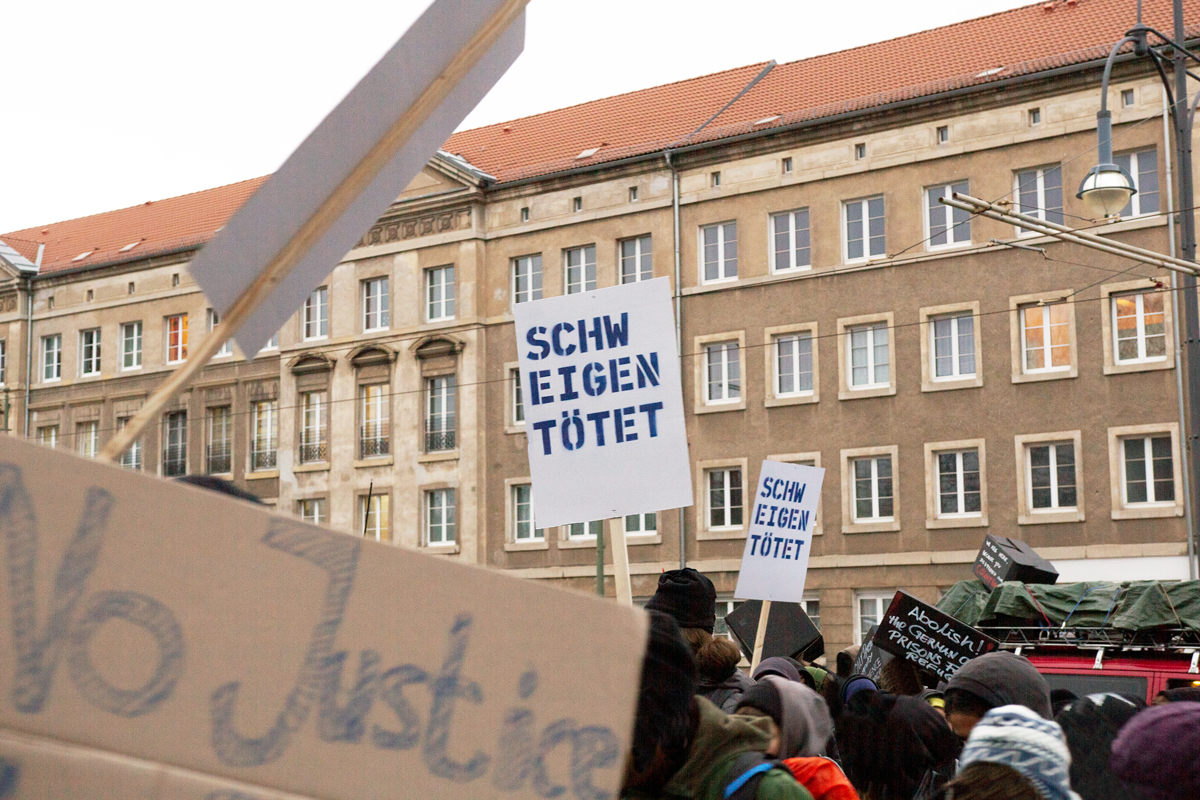 Schweigen tötet (Silence kills), posters for the 14th annual commemoration of the murder of Oury Jalloh. Photo: S A V V Y Contemporary
Schweigen tötet (Silence kills), posters for the 14th annual commemoration of the murder of Oury Jalloh. Photo: S A V V Y Contemporary
Since 2005, on 7th January each year, the commemoration protests of the unresolved murder of Oury Jalloh in a Dessau police cell take place. In order to support the protest, Spinning Triangles organised a workshop, where participants engaged intensively with the background of the Oury Jalloh case and worked collectively on content and design of protest banners. The workshop was guided by Mouctar Bah, friend of Oury Jalloh, activist and founder of the Initiative in Gedenken an Oury Jalloh e.V. (Initiative in Memory of Oury Jalloh), and Alexander Lech, communication designer and member of VorOrt-Haus Dessau. The posters were distributed and widely used during the protest.
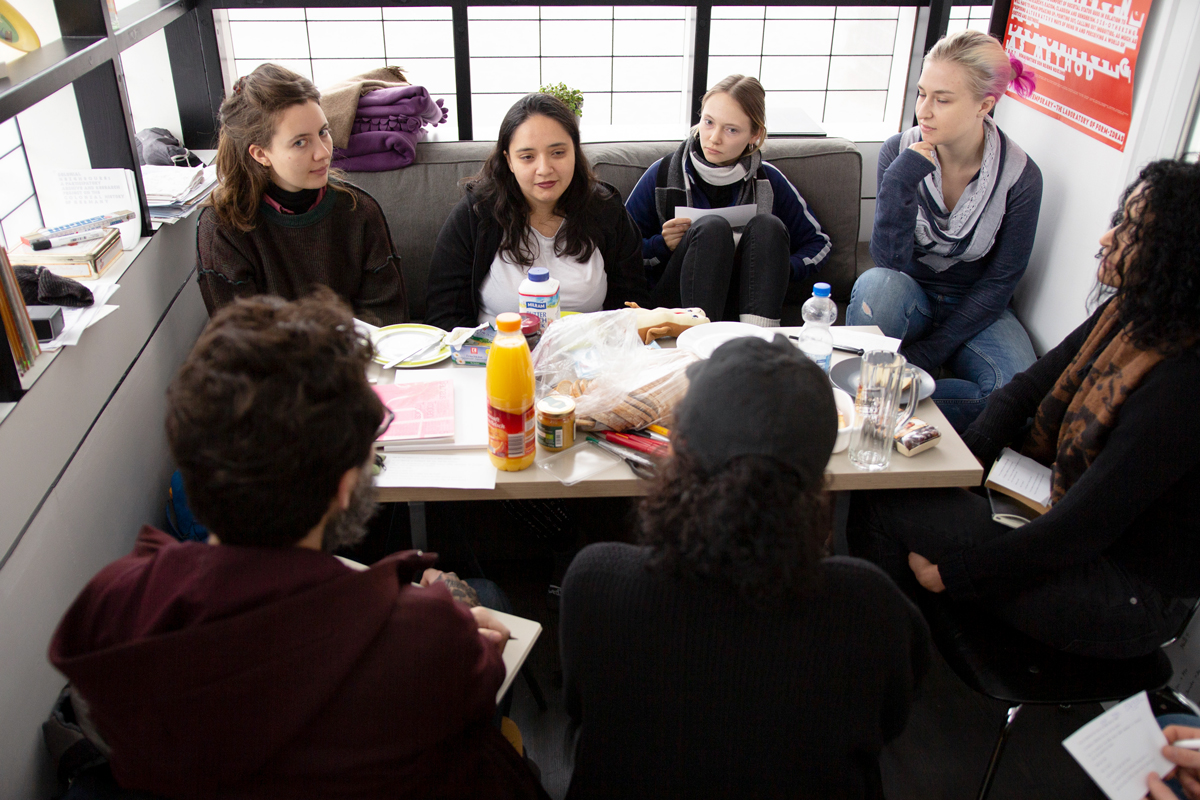 Impossible Methods, workshop with Decolonising Design. Pedro Oliveira, Luiza Prado
Impossible Methods, workshop with Decolonising Design. Pedro Oliveira, Luiza Prado
Two members of Decolonising Design, Pedro Oliveira and Luiza Prado gave a workshop both in Dessau and in Berlin. During the workshops the partcipants “start out from a designed artifact they are asked to bring to the session – responding to a set of keywords or a statement given by us beforehand – and slowly unpack the networks that inform the existence of that object in the world, as well as its implications in-use,” thus reflecting design processes: “the act of designing produces other designs into the world, and does so by intervening in an entanglement of processes, performances, interactions, narratives, and relations that are all context-dependent and socio-culturally informed. In other words, we understand the act of designing as one of producing material discourse.”
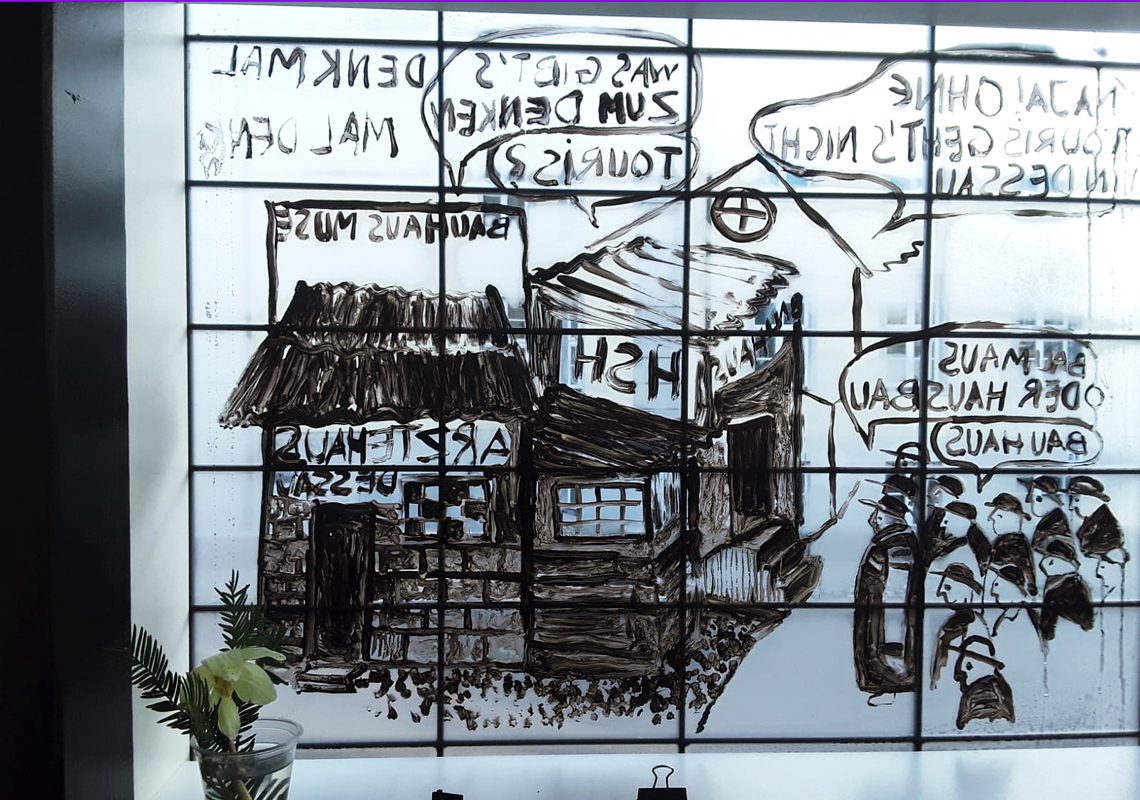 Comic Counterlegacy: Graphic novels, Colonialism, Representation, and Modernity. Workshop Lambert Mousseka
Comic Counterlegacy: Graphic novels, Colonialism, Representation, and Modernity. Workshop Lambert Mousseka
The workshop Comic Counterlegacy: Graphic novels, Colonialism, Representation, and Modernity was a continuous conversation and discussion with students, passers-by and visitors in Dessau, who were asked to contribute drawings and stories connected to their experience of being in Dessau and the topics at stake in Spinning Triangles. In the words of the workshop initiator, Lambert Mousseka: “Colonialism is mainly defined as the sum of those principles that governed past power relationships between Europe and the colonized world. But we need to face the reality, today, that colonization is still active in our present on many levels and is thus part of everyday ‘normalities.’ it is present in what we read, what we eat, what we drink, how we move. In this workshop, we will actively concentrate on the decolonization of thought-actions and the form-taking it can produce. But such is not possible without talking about racism and other humiliations that are activated in the way we encounter each other.”
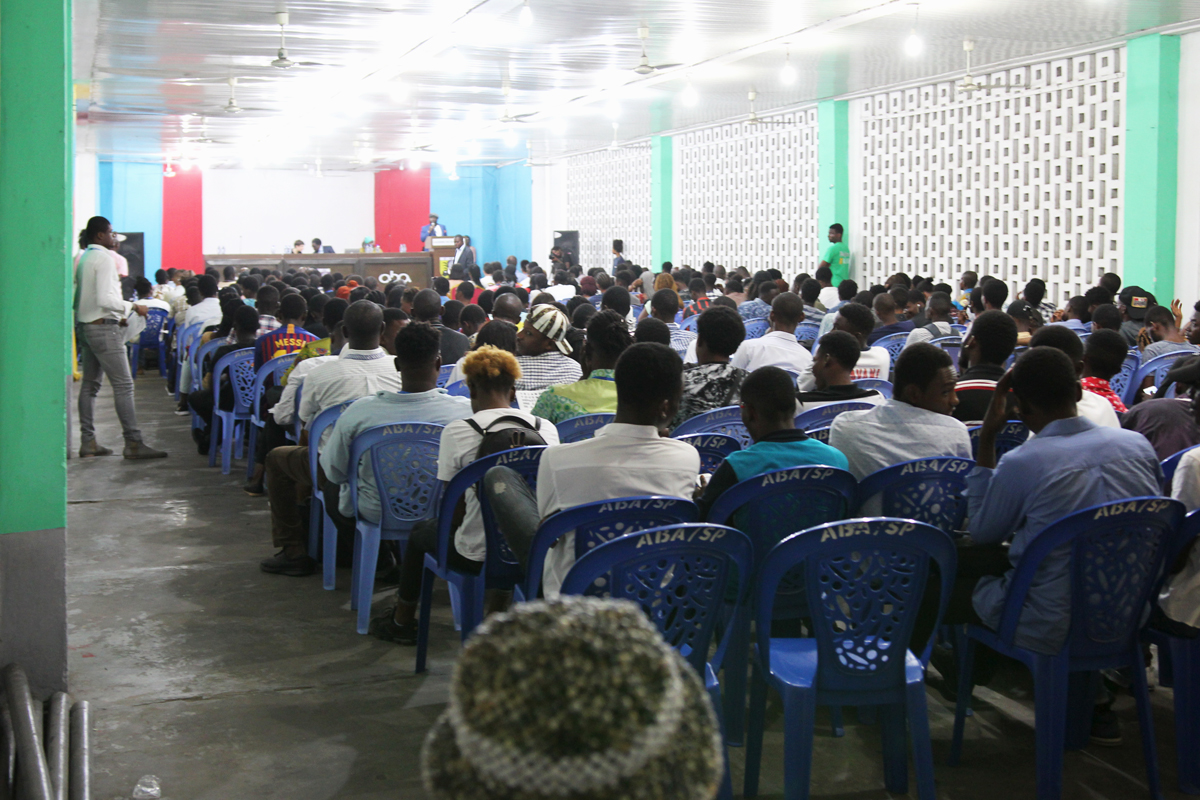 Spinning Triangles symposium in Kinshasa. Académie des Beaux-Arts, Kinshasa
Spinning Triangles symposium in Kinshasa. Académie des Beaux-Arts, Kinshasa
During the Spinning Triangles symposium in Kinshasa, the audience exchanged with Sinzo Aanza, Banka (Jonathan Bongi, Jean Kamba, Elie Mbansing, Malaya Rita, Jean-Jacques Tankwey), Cosmin Costinas, Cheick Diallo, Eddy Ekete, Iviart Izamba, Henri Kalama, Koyo Kouoh, Lisanga Bankoko (Lema Diandandila, Mavita Kilola, Mbo Mbula, Lutadila Lukombo), Saki Mafundikwa, Orakle Ngoy, Cedrick Nzolo, Colette Poupie Onoya, Eliana Otta, Tabita Rézaire, Simon Soon, Tau Tavengwa, Ema Tavola, Ola Uduku and Dana Whabira. The symposium oriented itself on the main topics of Spinning Triangles – design theory, practice and learning – simultaneously trying to reframe its history, opening new paths and discussing the possibilities of practices outside hegemonic structures. Each day was centered around guiding themes:
Beginning in the middle of things: a beginning with three perspectives on our contemporary condition, as well as performative discourses and a festive get-together at the artists’ residency Ndaku Ya La Vie Est Belle in Matonge.
Habits, Desires and Necessities: a multi-faceted day that guides us to the profound relationships at work within objects and the histories that they communicate.
Educative polyphony and spaces for knowledges: a day where multiple views and experiences in the domain of education confront each other to exchange perspectives, questions, experiences and visions.
Mingling bodies, spatial clashes: a day where the contributors bring us to the world of spatial conceptions – architectural ideas, their influences on our everyday life and the bodies that inhabit them, as well as urban provocations.
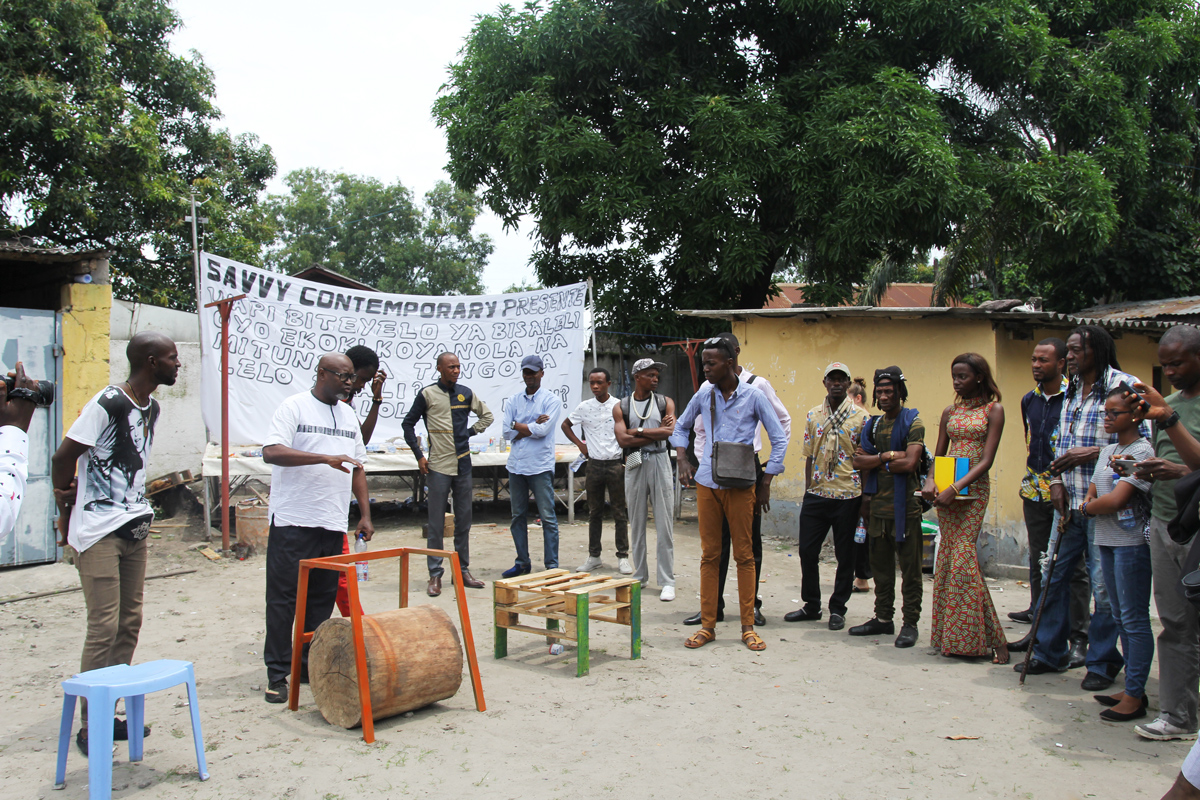 The Street as Laboratory of the Possible Workshop. Cheick Diallo
The Street as Laboratory of the Possible Workshop. Cheick Diallo
Starting from daily activities, shared and repeated in human life – like sleeping, sitting, eating – this workshop asked questions about the relationship between bodies, their activities and the objects, that support, guide and perhaps contradict the life of people. After choosing one of these daily activities, the participants began in depth observations of this activity and the social role it plays in the city of Kinshasa. What told and untold stories are hidden in these objects? Who produces them and why? Why are they formed like this, in such a way? Which ecosystem of production but also of use, recycling and repair surrounds them? Is there a way to rethink and redo them?
This workshop was initiated and guided by Cheick Diallo, Malian designer and design-thinker, who throughout his career did not cease to question observations and practices to propose objects that are not only use- and beautiful but are equally filled with important questions about our way of being in the world.
The workshop was accompanied by Jean-Jacques Tankwey.
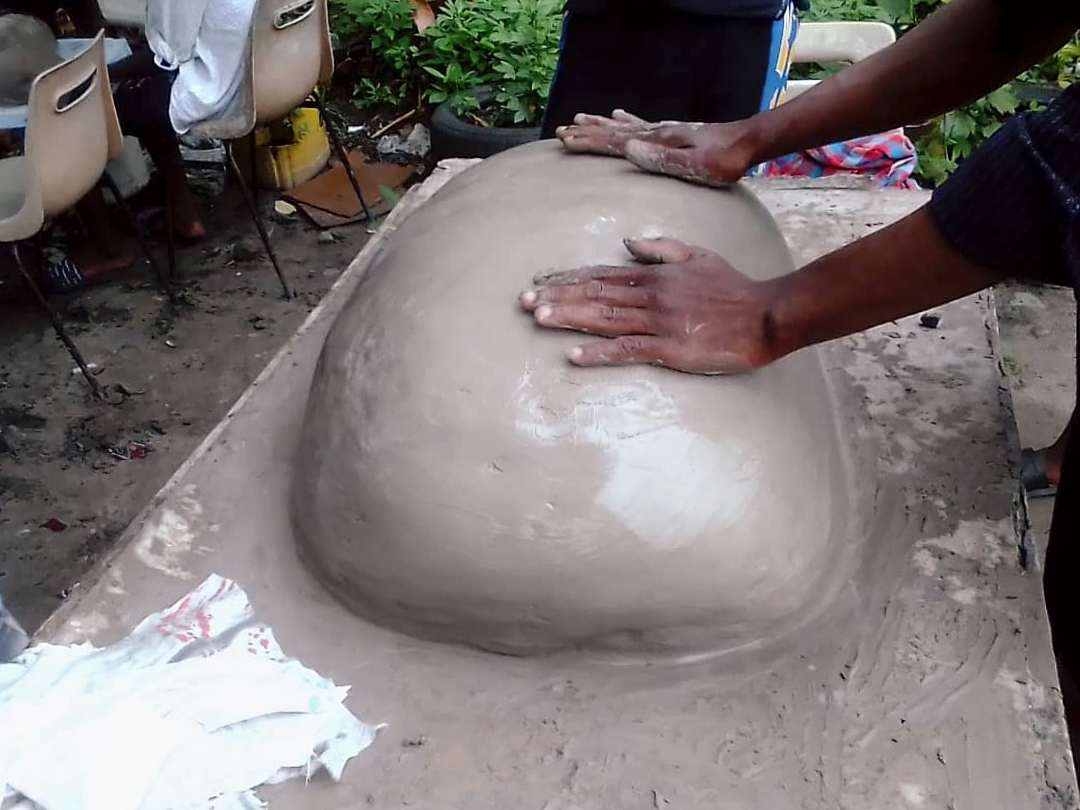 Spirits and Matter-Bodies Workshop. Lambert Mousseka
Spirits and Matter-Bodies Workshop. Lambert Mousseka
Through close observation and an experimental engagement with materials that make up the daily life of the city of Kinshasa, the workshop participants asked themselves what the spirits inhabiting these materials may be and which stories they tell. Through several activities, the participants asked questions of the animate and the inanimate – and associated materials to their own bodies. After experimenting with clay and other materials, the participants decided to make objects that could protect bodies, pointing for instance towards the necessity to address traffic accidents.
The workshop initiator, Lambert Mousseka activated an intergenerational network of artisans and artists surrounding Espace Masolo, a space he co-founded in Kinshasa in 2003.
The workshop was accompanied by Elie Mbansing.
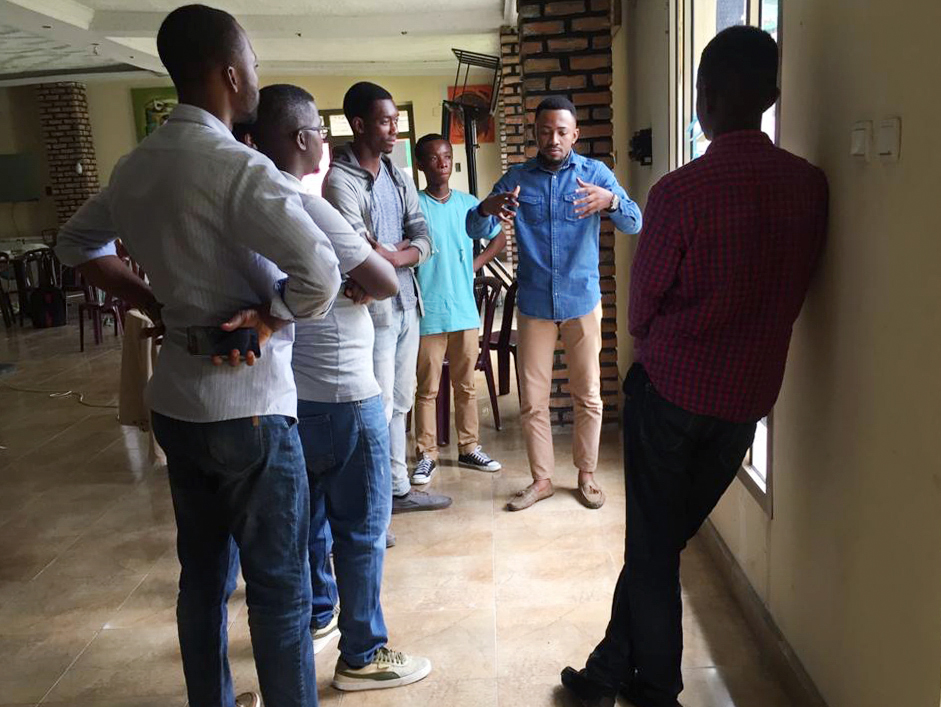 Design for Impact Workshop. Jean Paul Sebuhayi Uwase
Design for Impact Workshop. Jean Paul Sebuhayi Uwase
In this workshop questions turned around spaces of learning in the large sense – where and how is knowledge shared in Kinshasa, what are the spatial elements that guide this sharing, whether material or immaterial? In order to get closer to an understanding of these questions and build a bridge to concrete implementation, Jean Paul Sebuhayi Uwase proposed to have a close look at the principles of “design thinking.” Compared to methodologies that favor pre-conceived solutions, “design thinking” allows for a grounded understanding of the issues at hand, centering the user or affected group, rather than the designer. How do we design beyond individual fancy but propose impactful solutions? And within this project: can “design thinking” bring us closer to practicable ideas of how to give form to the potential school or un-school of design, thought about throughout Spinning Triangles, that might be capable of proposing “re-form-ulations” of our now?
Through Jean Paul Sebuhayi Uwase’s knowledge as architect and design director at MASS Design Group, participants discussed in depth what serving a community can actually mean.
The workshop was accompanied by Jonathan Bongi and Jean Kamba.
Lubricate Coil Engine – Decolonial Supplication | Performance
 Tabita Rézaire
Tabita Rézaire
Lubricate Coil Engine by Tabita Rézaire was a supplication to restore our ability to connect. In the words of the artist: “While eternity is on repeat, we scroll into the void to escape our existential conditions. How do we connect? Water, the womb, dream plants and sound are retrieved as connective interfaces against manufactured amnesia.”
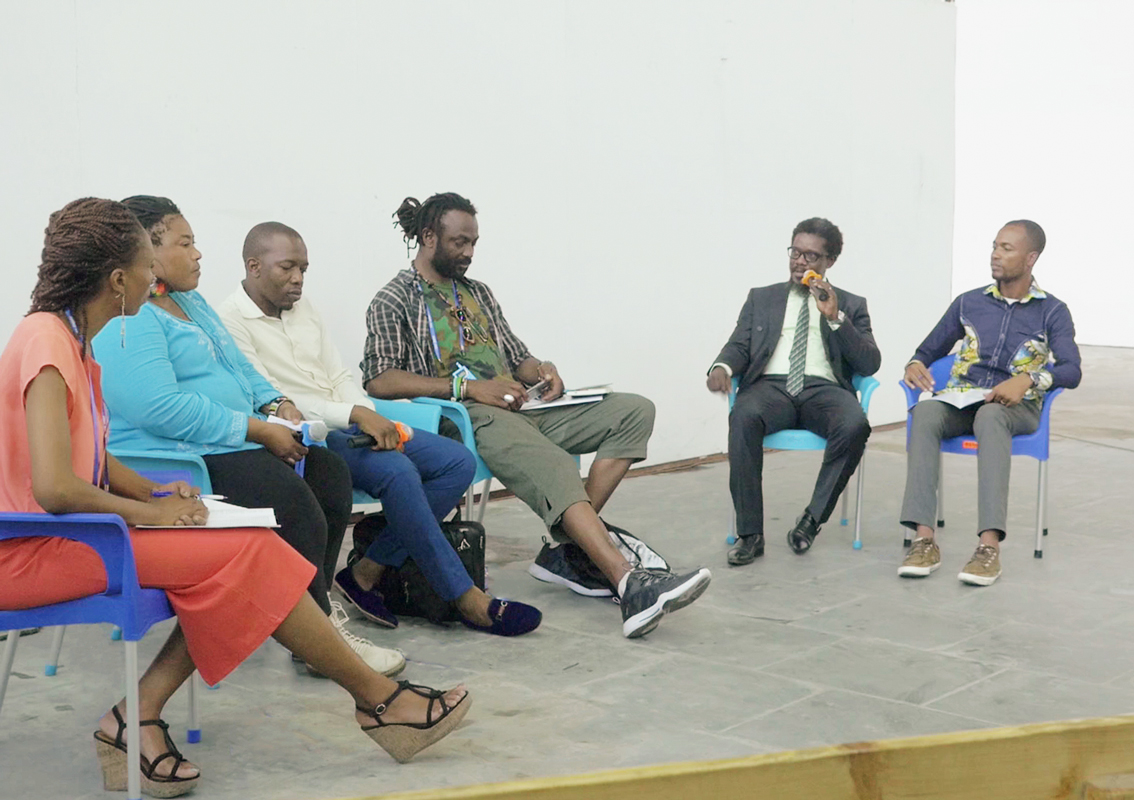 Educative polyphony and spaces for knowledges. Nioni Masela, Orakle Ngoy, Cedrick Nzolo, Eddy Ekete, Henri Kalama, Jean Kamba
Educative polyphony and spaces for knowledges. Nioni Masela, Orakle Ngoy, Cedrick Nzolo, Eddy Ekete, Henri Kalama, Jean Kamba
This round table discussion responded to the theme set for this third day of the conference Educative polyphony and spaces for knowledges, to discuss different forms and formats of education and learning structures. The director of the Académie des Beaux-Arts Kinshasa, Henri Kalama; the designer and educator at Institut National des Arts, Cedrick Nzolo; the rapper and initiator of Afrika Diva, Orakle Ngoy; and the artist and founder of Ndaku, Eddy Ekete, gave multiple perspectives of institutionalized as well as self-initiated learning environments.
Nioni Masela and Jean Kamba moderated this roundtable.
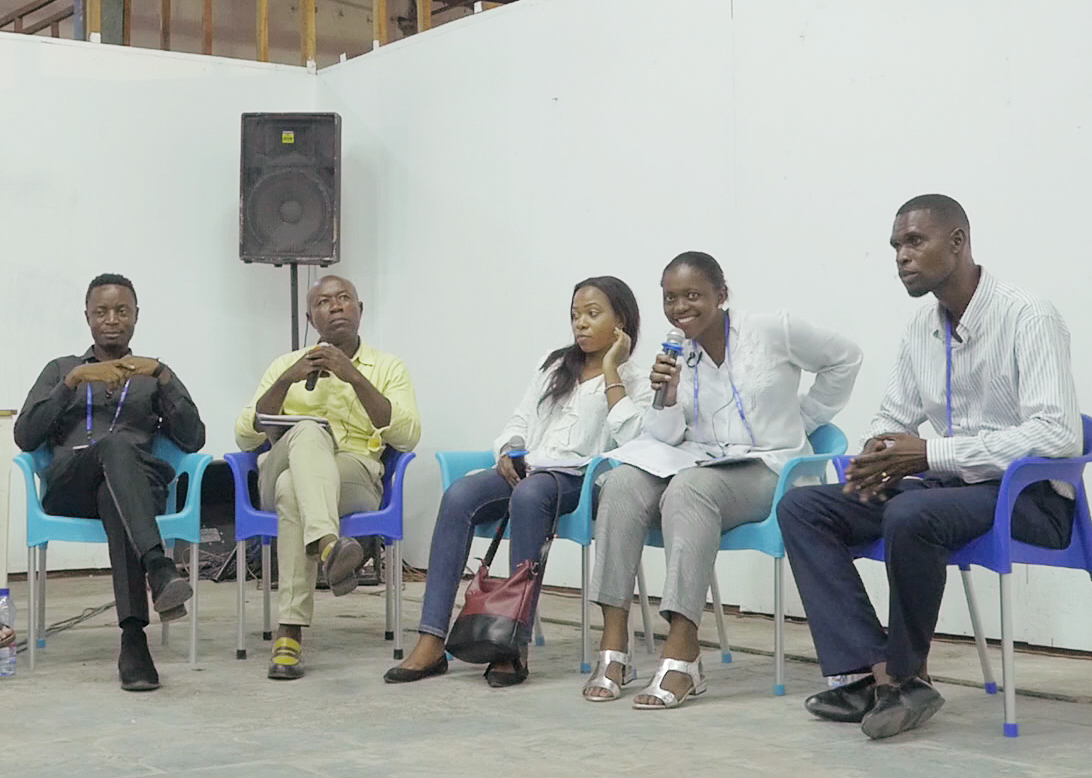 Mingling Bodies – Spatial Clashes. Iviart Izamba, Jose Bamenikio, Grace Mujinga, Colette Poupie Onoya
Mingling Bodies – Spatial Clashes. Iviart Izamba, Jose Bamenikio, Grace Mujinga, Colette Poupie Onoya
This round table responded to the topic undertaken for the fourth day of the symposium entitled Mingling Bodies – Spatial Clashes. The panelists discussed Kinshasa as a space, with its architectural and urbanist aspects, as well as its inhabitants, continuously confronted and in creative negotiation with its reality. The architects, designers and educators Jose Bamenikio, Iviart Izamba, Grace Mujinga and Colette Poupie Onoya expanded understandings of visible and invisible limits and possibilities within the city and the educational system.
Jean-Jacques Tankwey and Elsa Westreicher moderated this roundtable.
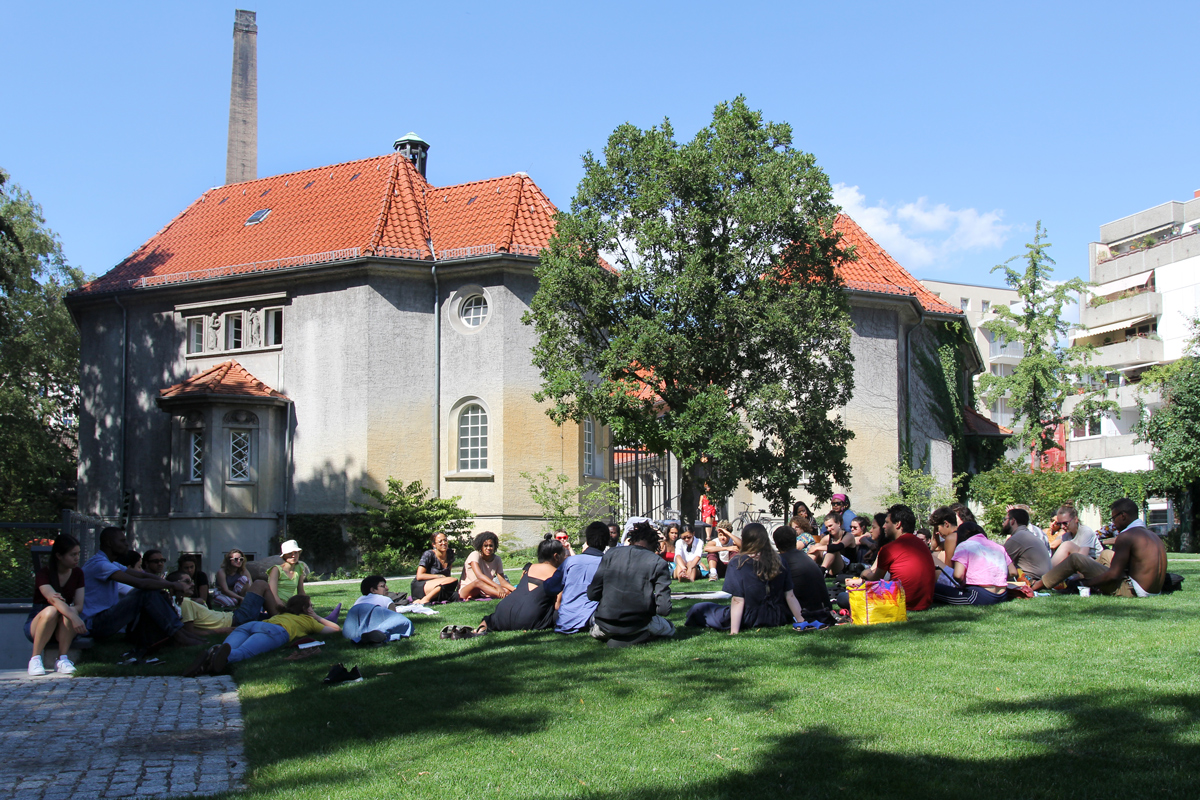 Summer (Un-)School of Design at S A V V Y Contemporary. Photo: S A V V Y Contemporary
Summer (Un-)School of Design at S A V V Y Contemporary. Photo: S A V V Y Contemporary
For one month, S A V V Y Contemporary transformed into a “school” of design, that might as well be called an “un-school,” moving along the entanglements between modernity and coloniality, questioning their repercussions for “world-making,” its obvious and less obvious masterplans. By exploring methods and practices alongside these discussions, forty participants, five invited guests from Kinshasa, as well as workshop initiators progressively gave form to this learning environment. Together, forms of co-living and co-creating were negotiated, bringing up systemic racism, entrenched white privileges, questions of comfort and discomfort, of oppression and complicities, of resilience and resistance.
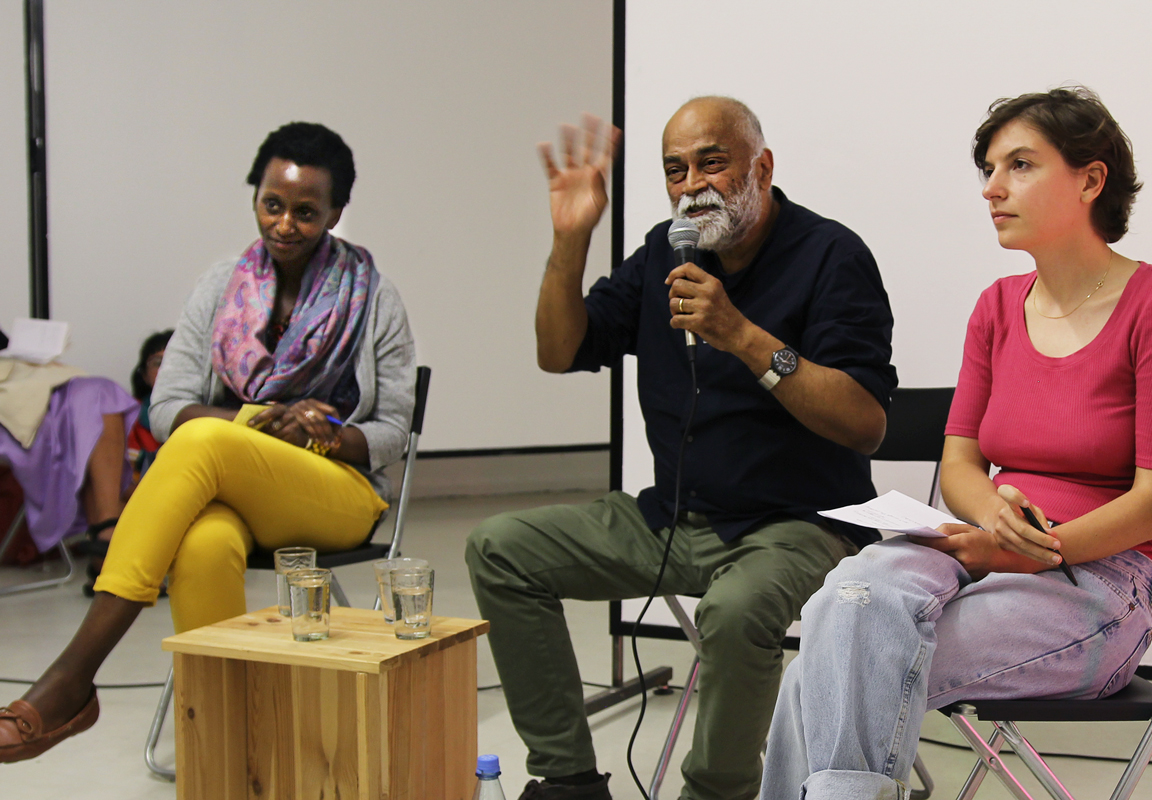 Design Without Planning: Everyday World-Building Outside The Gaze of Capital. Arjun Appadurai
Design Without Planning: Everyday World-Building Outside The Gaze of Capital. Arjun Appadurai
In his talk Design Without Planning: Everyday World-Building Outside The Gaze of Capital, Arjun Appadurai explored a form of design pedagogy anchored in daily activities incorporating a design sensibility of ordinary life in underprivileged communities. He suggested that the foundational object of design is sociality itself, and not the world of things.
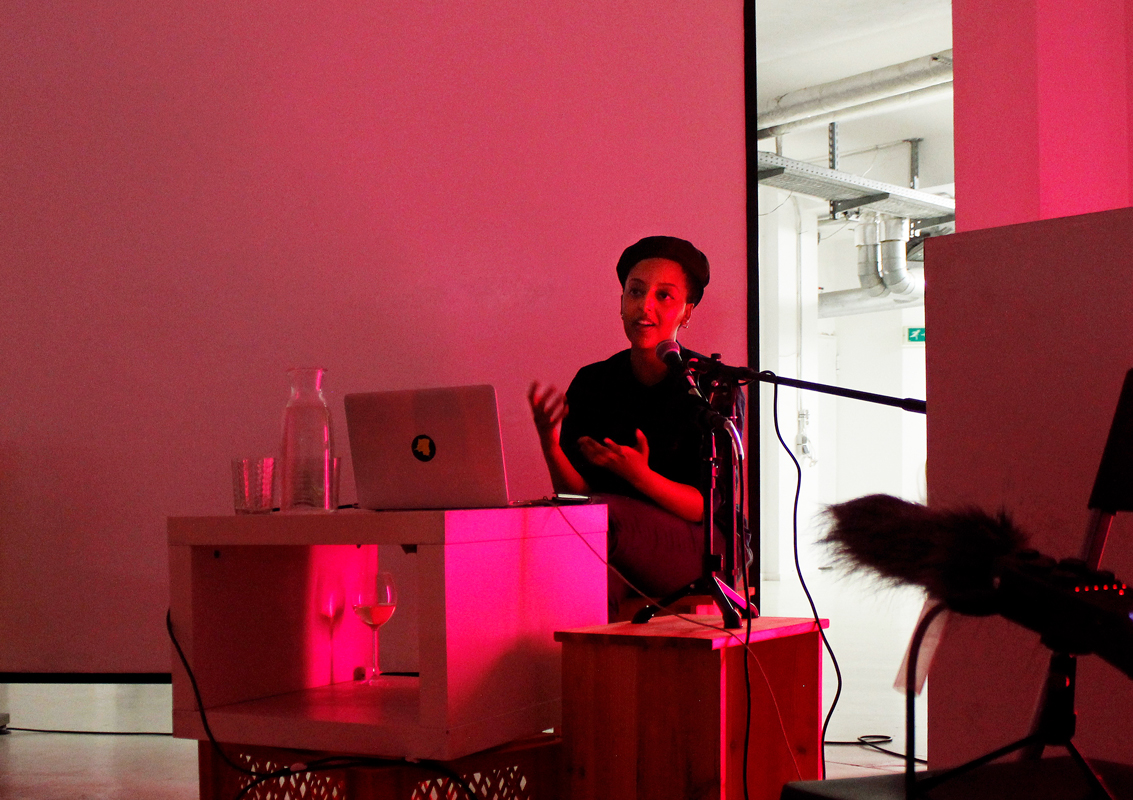 Ziba, Toguna, Tree: Applications of Traditional Multi-Use Space-Making in Contemporary African Architecture. Olani Ewunnet
Ziba, Toguna, Tree: Applications of Traditional Multi-Use Space-Making in Contemporary African Architecture. Olani Ewunnet
In this talk, the urban designer, researcher and sound artist Olani Ewunnet took a closer look into the generative capacity of object, space and nature or ziba, toguna and tree. Activating the 20 year project archive of the Kéré Foundation / Kéré Architecture and pulling from the rich tradition of collective building in central Burkina Faso, Ewunnet explored the ways in which contemporary African architecture can uplift the wellbeing of local communities, environments and economies.
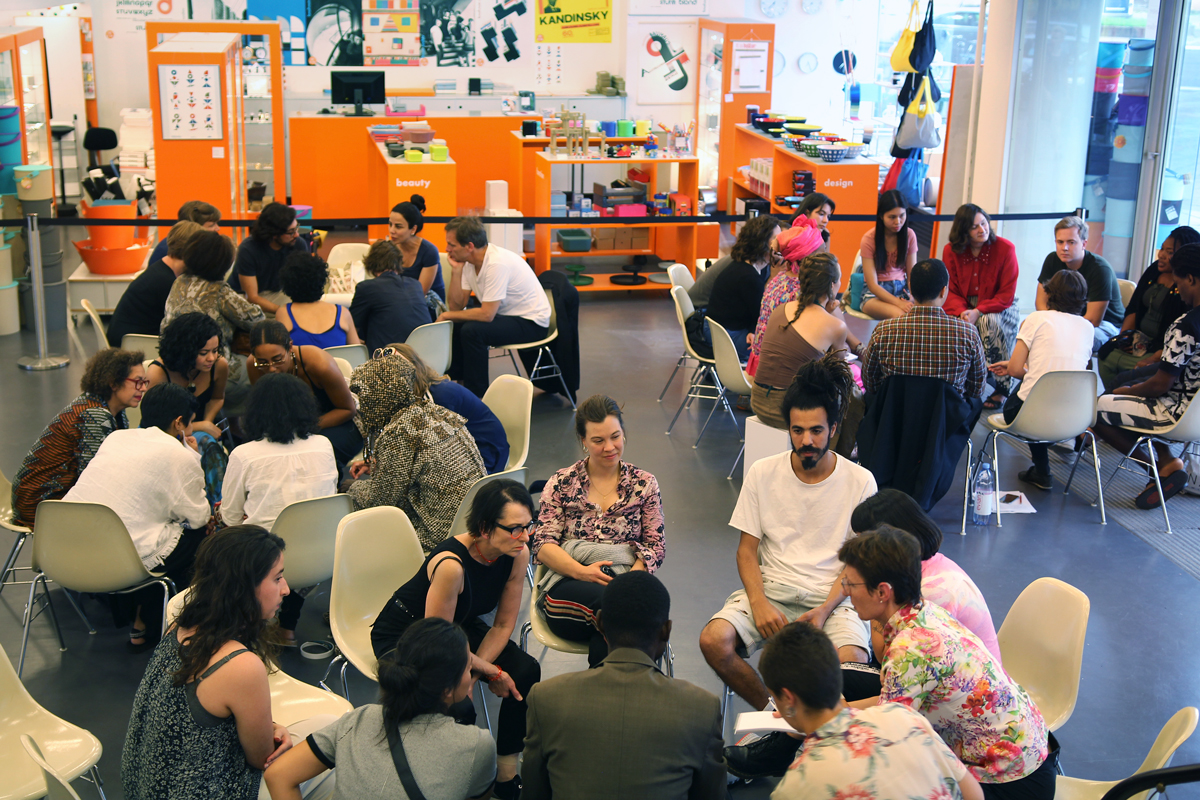 Lecture performance at Bauhaus-Archiv – Museum für Gestaltung Berlin. Bauhaus-Archiv – Museum für Gestaltung Berlin
Lecture performance at Bauhaus-Archiv – Museum für Gestaltung Berlin. Bauhaus-Archiv – Museum für Gestaltung Berlin
On invitation of the Bauhaus-Archiv – Museum für Gestaltung Berlin, S A V V Y Contemporary and the participants in the Berlin chapter of Spinning Triangles took over the space and conducted a multi-handed and multi-headed lecture performance, in which the “Un-School’s” practices and questions were made experiential for a wider public.
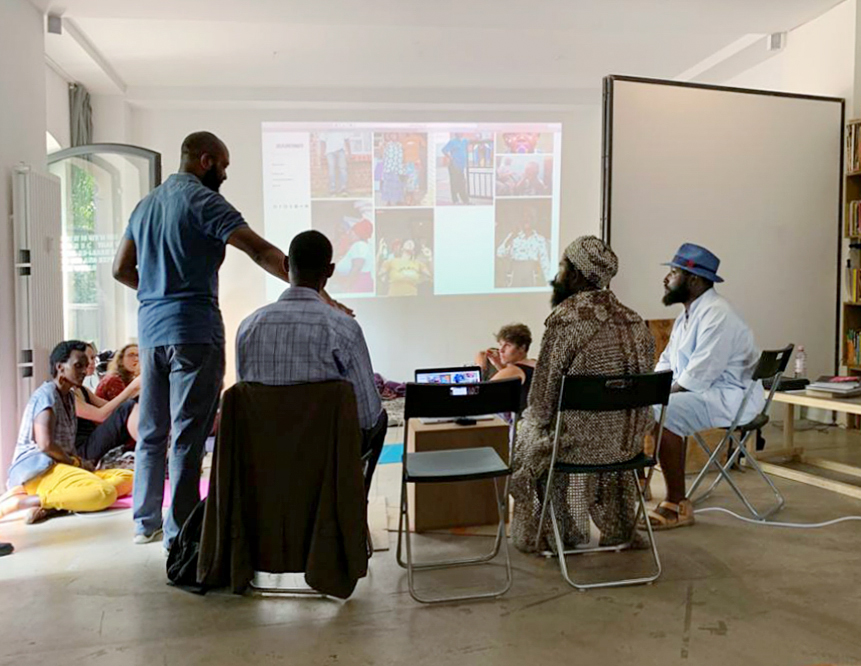 Comfort / Discomfort Workshop. Jean-Jacques Tankwey and Lema Diandandila
Comfort / Discomfort Workshop. Jean-Jacques Tankwey and Lema Diandandila
This workshop departed from the observation that as designers we are often concerned with designing for others, assuming we know what their comfort feels and looks like. Jean Jacques Tankwey and Lema Diandandila proposed to question this idea.
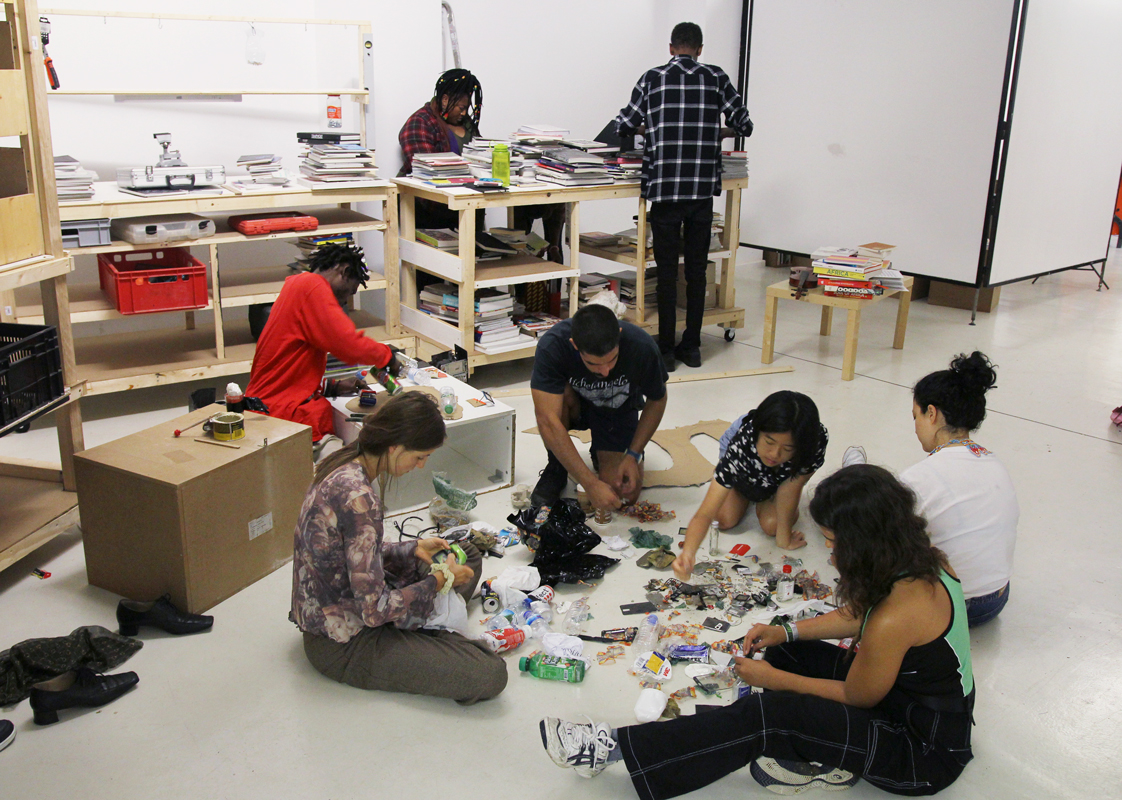 Facades as Communicative Rooms / Intimate Spaces for Resonant Bodies Workshop. Grace Mujinga, Orakle Ngoy, Nada Tshibwabwa
Facades as Communicative Rooms / Intimate Spaces for Resonant Bodies Workshop. Grace Mujinga, Orakle Ngoy, Nada Tshibwabwa
This workshop proposed ritual as a form of education, taking practices from the Makwacha villages in the Katanga region of the D. R. Congo as an example. In this women’s village, the ritual of painting the walls of buildings is part of intergenerational learning processes. From there, the participants questioned facades as spaces of transmission and translation; between the hidden and the revealed, between an inside and an outside, between the material and the immaterial world. The workshop was initiated by architect Grace Mujinga, rapper Orakle Ngoy, and artist-musician Nada Tshibwabwa.
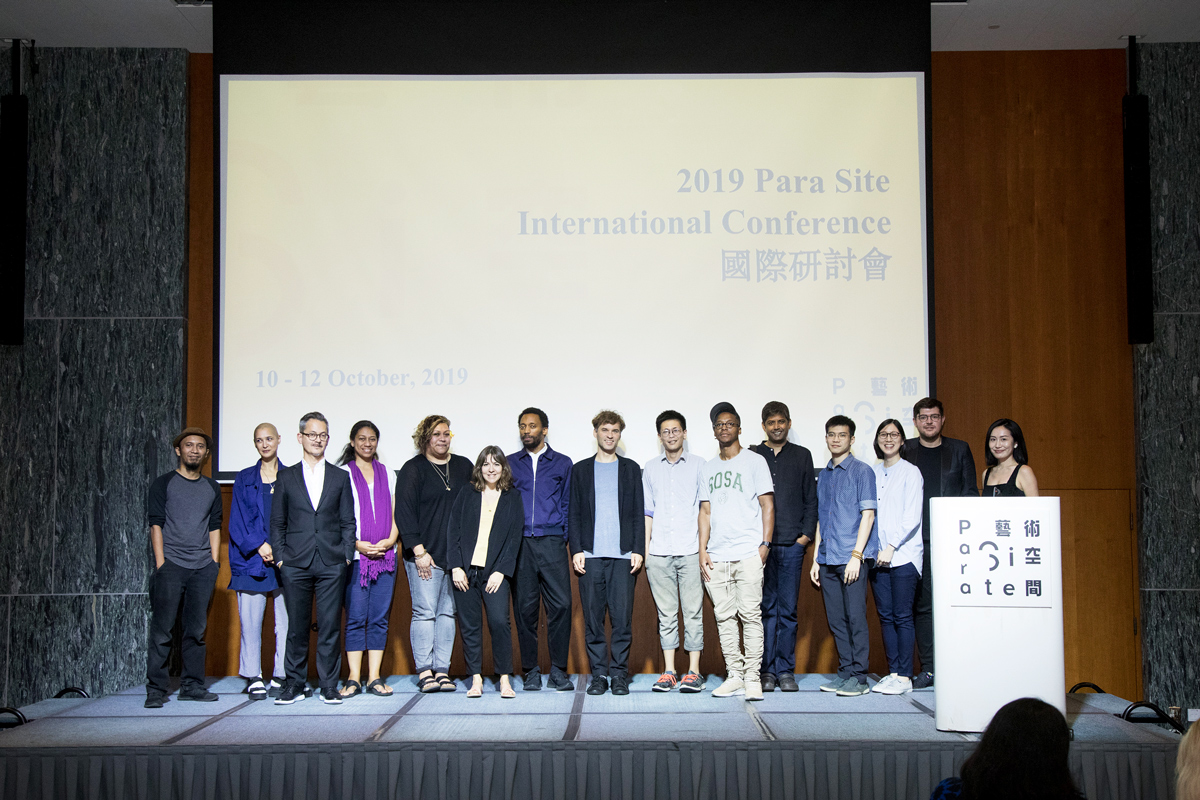 Para Site’s annual International Conference. Andreas Siagian, Clara Lobregat Balaguer, Lawrence Chua, Katerina Teaiwa, Ema Tavola, Iliana Fokianaki, Christian Nyampeta, Sebastian Cichocki, Simon Soon, Lupe Fiasco, Sugata Ray, Tan Zi Hao, Lesley Ma, Cosmin Costinas, Anqi Li
Para Site’s annual International Conference. Andreas Siagian, Clara Lobregat Balaguer, Lawrence Chua, Katerina Teaiwa, Ema Tavola, Iliana Fokianaki, Christian Nyampeta, Sebastian Cichocki, Simon Soon, Lupe Fiasco, Sugata Ray, Tan Zi Hao, Lesley Ma, Cosmin Costinas, Anqi Li
Para Site was S A V V Y Contemporary’s cooperation partner for Spinning Triangles’ Hong Kong chapter. As Hong Kong’s first exhibition-making institution of contemporary art and a crucial self-organised structure within the city’s civil society, this collaboration opened up the conversation moving within Spinning Triangles further, rather than being the project’s closure. The annual international conference as well as its accompanying workshops were more interested in “looking at a broad map and timeframe of resistance through design, schooling and unschooling, exchanges and circulations of forms in visual worlds that have had other directions of traffic and have created a different understating of what an internationalist language might look like”[2] than centering the Bauhaus’ legacy.
[2] Curatorial statement by Para Site for the International Conference 2019.
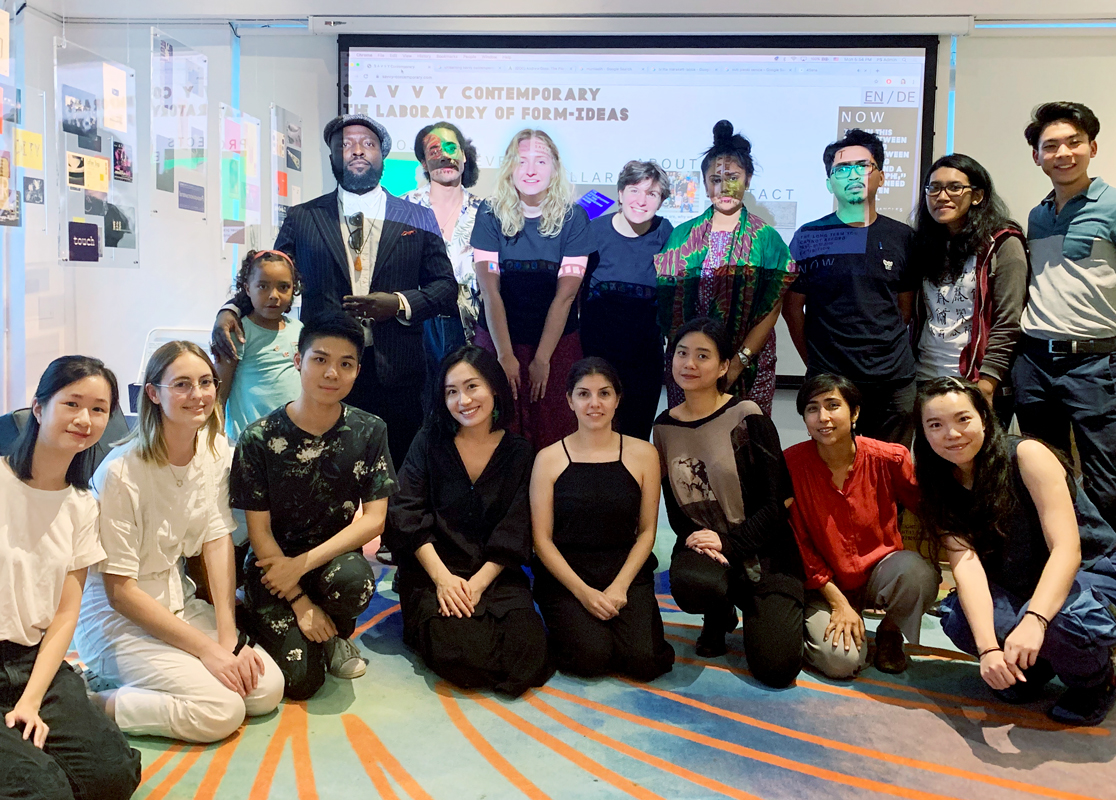 Workshops for Emerging Arts Professionals. Bonaventure Soh Bejeng Ndikung
Workshops for Emerging Arts Professionals. Bonaventure Soh Bejeng Ndikung
Since five years, Para Site, one of the oldest independent cultural institutions in Hong Kong focusing in contemporary art practices, organizes workshops for emerging curators, writers, critics, researchers, and other arts professionals from Hong Kong and abroad, through a series of workshops, lectures, and site-visits. It is a 9-day intensive program that provides learning and thinking opportunities, mediated by reputed speakers from Para Site’s International Conference as well as by art practitioners from across Hong Kong’s diverse institutional landscape.
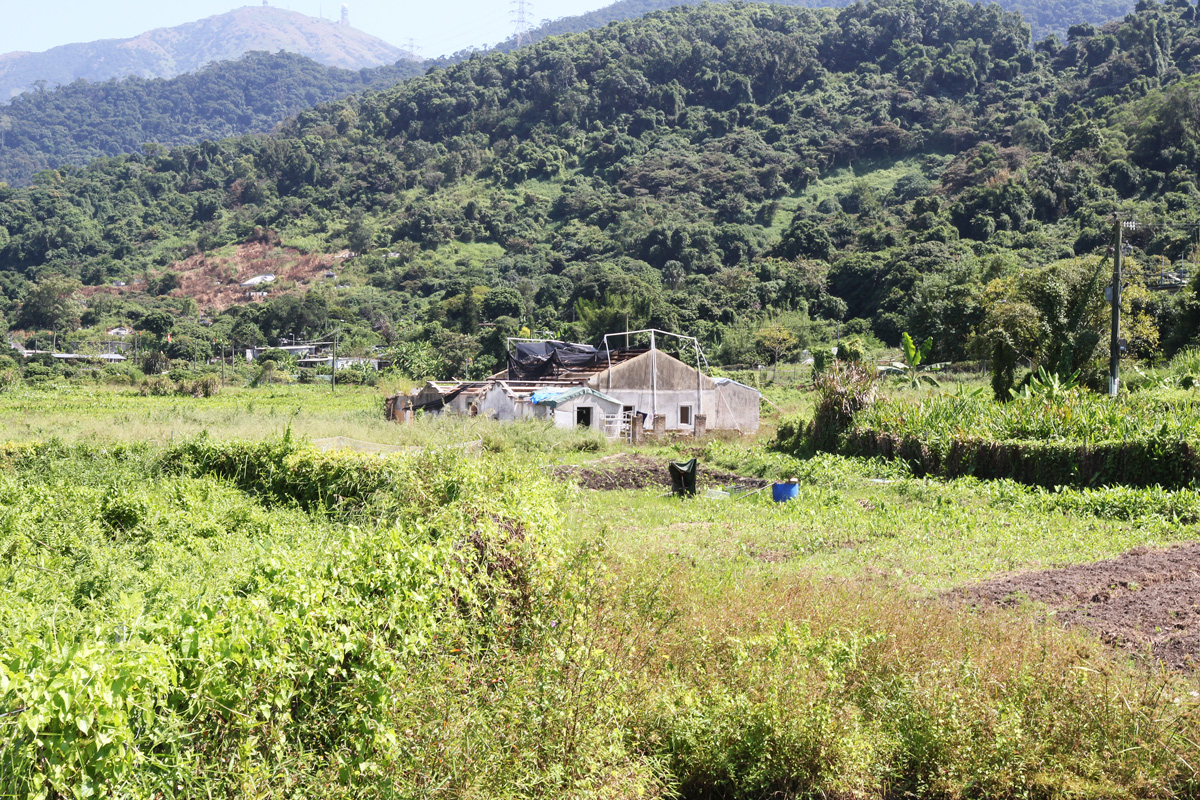 A learning and community centre under construction at Sangwoodgoon, a collective organic farm in Hong Kong. Lo Lai Lai
A learning and community centre under construction at Sangwoodgoon, a collective organic farm in Hong Kong. Lo Lai Lai
During the Workshops for Emerging Professionals, organized by Para Site, many site visits were programmed. Among them a collective farming initiative, Sangwoodgoon. Artist Lo Lai Lai, herself a learner within the initiative, explained and showed us the intricate social, natural and political entanglements at work within the structure.
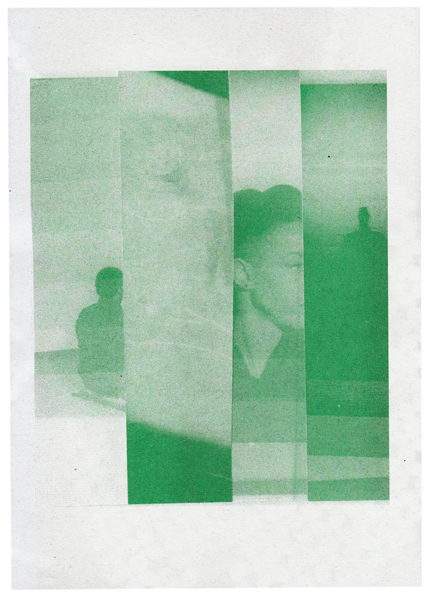 Berlin publication. Summer (Un-)School of Design at S A V V Y Contemporary
Berlin publication. Summer (Un-)School of Design at S A V V Y Contemporary
During the Berlin chapter of Spinning Triangles, the participants collectively created a publication. Loose pages, created by those involved in the “un-school,” came together as floating fragments, connecting and disconnecting from each other, mingling and creating a rhythm among visual and written voices. The names and titles of the contributions were printed but not assigned directly to the pieces, allowing a second layer to appear, giving no direct answers but hints, complicating our desire to assign straightforward meaning to what surrounds us.
Alejandra Alvarez (Learning Devices), Jasmina Al-Qaisi & Clara Saez (Grandma Knowledge is Science), Andrea Anzala & Frida Robles (How Insistent Are Our Urban Ghosts?), Banka; Jonathan Bongi, Jean Kamba, Rita Mayala, Elie Mbansing, Jean-Jacques Tankwey (Kinshasa Mboka Banka), Elia Diane Fushi Bekene (Who?), Katharina Birkmann & Marlene Kargl (Healing Landscapes), Clara Brandt & Emilia Escobar & Noara Quintana (Mouth, Hands, Spirit – No Head), Khaleb Brooks (On the Subject of Blackness and Technologies of Power), Maria Camilo (Flood), Uğur Latif Çelebi (Eternal Eyes And The Power Of Images), Juliette Dana (Can You Pour Water in my Cup? I've Been Taping The Cracks ), Lema Diandandila (Lisanga Bakoko Souhaite Partager Les Savoirs Avec Tout Le Monde. Si Un Ancêtre Meurt Sans Le Partager C’est Toute Une Bibliotheque Qui Meurt), Emilia Escobar (Must it Always Be Grids?), Uğur Latif Çelebi & Juliette Dana & Michalis Fountedakis & Olga Konik & Franca López Barbera & Antonio Mendes & Fanny Souade Sow (Juxtaposition), Gabe Gordon (Inter-Non-National Citizen Stamp Advisory Committee Issue One, Or, What Is Lick-able And Who Is Free, Or, Who Is Lick-able And What Is Free?), Samira Hodaei (From Object To Storytelling), Valerie Kong (10 Things About Eating), Olga Konik (What Is Your Food Landscape?), Lia Krucken (Our Body Writes), Galina Kruzhilina (List), Eliza Levinson (Das Wasser Zwischen Dir und Mir), Thomas Lindenberg & Shreyasi Pathak (Steal, Steel And More Steal), Franca López Barbera & Patricia Sayuri (When The Tide Rises), George Lynch (As A Shaken Can), Grace Mujinga (Construire A Moindre Coût Avec Les Matériaux Locaux, Isolation Thermique Et Acoustique Sont Garantis Et Une Bonne Ventilation Assurée), Osman Mukhtar (Have Never Been, It Just Seems, I Stick in Between), Orakle Ngoy (Du Sens Au Sens), Garth Roberts (9/10ths), Eeva Rönkä (Compose), Patricia Sayuri (Casinha), Mariama Sow & Dior Thiam (Mandombe Als Dekoloniale Strategie), Jean Jacques Tankwey (Confort-Inconfort, Décoder!), Nada Tshibwabwa (Bozui Tozali Komona Eza Malamu. Kasi Ezali Ya Molili To Ya Malamu? / Les Biens Matériels, C’est Bien. Mais Est-Ce Qu’ils Sont Vraiment Matériels Ou Ce L’Au-delà? / Material Goods Are Fine. But Are They Really Material Or From Beyond?).
Participants forming the editorial team were: George Lynch, Franca López Barbera, Eloise Maltby Maland (editors). Jasmina Al-Qaisi, Andréa Anzala, Michalis Fountedakis, Olga Konik, Galina Kruzhilina, Eliza Levinson, Osman Mukhtar, Caroline Neumann, Garth Roberts, Frida Robles, Clara Saez.
The publication was printed by WeMakeIt (Berlin).
